3
Sometime in 1964 a general in MACV headquarters developed a curiosity about why the Viet Cong were called “the Viet Cong.” I was assigned to find the answer. It took me many years to understand the full ramifications of this seemingly simple-minded question, but it turned out to be a good point of entry for the next phase of my life in Vietnam. In the spring of 1965 I joined the Rand Corporation and was put to work on their “Viet Cong Motivation and Morale Project.”
My first step in carrying out this MACV assignment was to find out who the leading American authority on the “Viet Cong” was. All trails led to Douglas Pike, an official of the United States Information Agency, soon to become the Joint United States Public Affairs Office (JUSPAO). I walked across the street from the Tax Building to his office on the second floor above the Abraham Lincoln Library (the target of the February 1965 demonstration). Despite his gruff, no-nonsense manner, Douglas Pike cordially received me, a military non-entity, and went out of his way to be helpful. I think he recognized a fellow fanatic with a single track focus on getting to the bottom of the question of who our enemy was and what made them tick.
These are two separable questions. The origin of the Rand Motivation and Morale Study which I joined in the spring of 1965 was a question posed by Secretary of Defense Robert S. McNamara in the spring of 1964, “What makes the Viet Cong tick?”2 As related in the previous chapter, McNamara’s top deputies did not like the answer they got from the first phase of the Rand study of Viet Cong Motivation and Morale. The Zasloff-Donnell briefing to McNamara’s deputy, John McNaughton, stressed the nationalist roots of the communist movement and “implied that the United States was facing a strong and dedicated enemy who ‘could only be defeated at enormous costs, if at all’”3
That was the preliminary answer to the question, “what makes the Viet Cong tick?” The seemingly more straightforward question, “who are the Viet Cong” proved more difficult to answer. Official US policy was based on the presumption that the southern insurgents were simply agents of an external force, the Hanoi government and the communist party that controlled it. As it turned out, the links between northern and southern revolutionaries were much more complex than the “aggression from the North” thesis implied.
Calling the insurgents “Viet Minh”, as many villagers in the South still did in the early 1960s, was unacceptable to the U.S. and its Saigon ally the Government of Vietnam (GVN), because it acknowledged the deep nationalist and anti-colonial roots of the movement. In addition, especially after a 1961 purge of older Viet Minh in favor of more energetic and malleable youth, the insurgents themselves avoided using the term. Calling them the “Liberation Forces,” as they called themselves was a political non-starter for those who did not want to be liberated. But even that was more acceptable than the National Liberation Front (NLF) after it was established in December 1960, because it was just that – a front – a façade intended to obscure the real power that created and manipulated it, the Communist Party. In a well meaning attempt to find a neutral term for interviewers questioning prisoners and defectors, the Rand Corporation decided to encourage the use of “the Front” as the most neutral term available. It did serve that purpose, but it was also confusing, because it was an unfamiliar and artificial-sounding term that interview subjects themselves never used, and it blurred the distinction between hard core insurgents and peripheral supporters.
Calling all the insurgents communists was inaccurate, because only the core leadership at each level belonged to the Party, and it obscured the wide support base of the insurgents who were active in the movement but not members of the Party. “Viet Cong” – Vietnamese communists, suffered the same defect. In the later years of the war, especially after the 1968 Tet Offensive, “Viet Cong” was used by the U.S. and GVN to refer to the Southern insurgents to distinguish them from the Northern forces infiltrated into the South from the mid 1960s on. Some tried to pin the label “terrorists” on the revolutionary forces but, despite the many acts of terrorism they committed, this did not catch on. The beleaguered peasantry found it prudent to employ a neutral term when speaking of the insurgents to the Government: “those gentlemen,” [mấy ổng] ” as in “those gentlemen passed through the village last night.” Sometimes it was further spelled out as “those Liberation gentlemen” [mấy ổng Giải Phóng].
One reason the U.S. government sponsored a “name your enemy” contest in 1958 was that they hoped to find a way to eliminate the “Viet” in “Viet Cong” (Vietnamese Communists) so as not to concede even that the insurgents in the South had a national identity. The model would have been the “communist bandit” (gong fei) term, devised by the Chinese Nationalist forces or “communist terrorists [CTs]” as the British termed the Malayan insurgents, also to stress the non-native character of the insurgents that they regarded as interlopers and troublemakers. The British in Malaya would have preferred to recycle “communist bandits” but eventually decided against it. One prominent book on the Malayan Emergency explained that “Throughout this book Communist guerrilla fighters are referred to as CTs, short for Communist Terrorists. At first they were officially labelled ‘bandits’ – until the British discovered that this word had unfortunate connotations. “Bandits’ had been the identical term used by the Japanese and Chiang Kai-shek to describe Communists; since neither of these powers had been successful, the use of ‘bandits’ by the British put them on a similar level in the eyes of the Malayan Chinese. The British therefore changed ‘bandit’ to ‘Communist Terrorist’ or CT. In order to make for easier reading, I have used the term throughout.”[1] For whatever reason, the entrants in the USIS “Name Your Enemy” contest were unable to improve on “Viet Cong,” and that term was deemed the winner by default.
Pike would soon write one of the landmark early books on the subject which he, reluctantly, termed “Vietcong: the Organization and Techniques of the National Liberation Front of South Vietnam.”4 He wrote to his publisher “I suggest we name my book Viet Cong – not because the term is fully accurate (it is not) but because it will do what a title is supposed to do: tell the reader what the book is about.”5 Doug Pike was a wellspring of information on the subject of the Viet Cong, and he recognized in me a fellow seeker of the Grail, the deep understanding of the enemy America faced.


Douglas Pike
I started off from a position similar to his own; the view that the Viet Cong was essentially an organization machine that was cleverly and effectively deployed by a determined and ruthless leadership group, and that its success was due to its ability to steamroll the fragmented opposition to its rule. The “organization machine” image was reinforced by the nature of my work; like Douglas Pike I first encountered them as abstractions who appeared only in the form of written documents. Even when I started to do face to face interviews, it was with cadres who naturally emphasized the organizational dimension of insurgency. As noted below in this chapter, one critique of Pike’s view was that of an economist who concluded that “Mr Pike’s views derive from too much concentration on the evidence obtained from Communist cadres, themselves inevitably pre- occupied with organization as the main factor in Communist success in South Viet-Nam after 1960.”6 The complexity and massive scale of this written communication nexus was impressive. The subtitle of Pike’s book (Organization and Techniques of the National Liberation Front) reveals his general orientation toward understanding the revolutionary organization in the South.
By the time I summed up my work of the revolutionary movement in the Mekong Delta in 2003, I had come to reject the “organizational machine” view of the revolutionary movement. I also decided not to use the term Viet Cong, though I will do so in this memoir for the same reason Doug Pike used it in his book, because it is the term most familiar to most readers. But I will note the caveat here. In the Vietnamese War I advised prospective readers that “There are a number a terminological pitfalls in the study of this revolutionary movement. The most obvious is what to call the movement and the people in it. This is especially perplexing after 1960. Calling the movement and its members the ‘Viet Cong’ is more comprehensible to a general audience, but is also a pejorative term which was devised for psychological warfare purposes by the enemies of the revolution. It is sometimes used in a sarcastic way by the “Viet Cong” themselves in postwar revolutionary accounts, but given the origins and purpose of this term, it seems inappropriate for a scholarly study. An even more important drawback of this term is that it blurs the distinction between the more and less committed members of the revolutionary movement, and thus confuses the key issue of nature of the movement and the extent of its base of support. Nonetheless there are some occasions dictated by the context when the term the ‘Viet Cong’ is used in parenthesis to indicate the post-1954 revolutionary movement in South Vietnam. In the Rand project, interviewers were requested to use the term ‘National Liberation Front’ (NLF) or, simply, ‘the Front.’ This had its drawbacks as well. Sometimes when it was important to make a distinction between the NLF and the Communist Party, for example, the respondent would take the cue from the interviewer and say ‘Front’ while meaning ‘Party.’”8
Doug Pike had a competitor for the title of “leading U.S. government specialist on Vietnam.” That was the CIA’s George Carver, who evidently preferred to study his subject from a distance, in the secure confines of the agency’s headquarters in Virginia. Thus it is not surprising that Carver saw the Viet Cong not only as a machine, but as “faceless.” In an article in Foreign Affairs, Carver wrote “Though the outlines of the Viet Cong’s organizational structure are fairly well known, the identities of its leaders are not. They are faceless men, veteran Communist revolutionaries who have made a lifetime practice of masking their identities under various aliases and noms de guerre and who take particular pains to stay hidden in the background to support the political fiction that the insurgency is directed by the N.L.F. and the Front’s ostensible officers.” Carver added “It is fairly easy to devise an organizational structure capable of lending verisimilitude to a political fiction, doubly so if one is trying to deceive a foreign audience unversed in local political affairs. Fleshing this structure out with live, known individuals to occupy posts of public prominence is considerably more difficult.” 9
Of course, it is likely that Carver had a déformation professionelle a proclivity to view things from the vantage of one’s own life’s work and training. Or, as the Vietnamese saying goes suy bụng ta ra bụng ngừơi – to project your own thoughts and motives onto others. To be “faceless” is the CIA ideal – indeed Carver hid his CIA identity in his Foreign Affairs article and presented himself as merely a random interested observer. The professional environment from which Carver operated is illustrated by a recent article on the current CIA director. “The desire to appear unremarkable tracks with Haspel’s past as a CIA operative. As Jenn Williams, the deputy foreign and national security editor at Vox, put it on Vox’s Today, Explained podcast: “[Haspel] has kind of mousy brown hair. She looks like she could be your sixth grader’s principal. She looks just like a random lady who passes on the street and whose face you would forget within a minute. But that’s a good thing — if you’re in clandestine operations, you do not want people to know your face. You want to blend in.”10
The “faceless Viet Cong” label caught on in the American press. In part it was due to a real ignorance on the part of the CIA and other intelligence sources the press had to rely on for information about the Viet Cong, and in part it was a reaction the frustrations of being unable to personalize a complex story. The only two Vietnamese communist names an American consumer of the news was likely to recognize were Ho Chi Minh and Vo Nguyen Giap. Postwar scholarship has generally concluded that both Giap and Ho Chi Minh had been largely sidelined in the Hanoi power structure by the early and mid-1960s. But, lacking a better alternative at the time, many journalists continued to attribute all policies, strategies, and decision to these two men, inevitably reinforcing the view that the southern Viet Cong were mere puppets of Hanoi and that everything that happened on the ground in the south was a result of decision made at the top in the north.
Moreover the idea that whatever the Viet Cong did in South Vietnam was attributable to the decisions of top leaders in Hanoi obscured the reality that most of what happened was the outcome of a vast social movement whose significant daily actions were the result of a complex interplay of local factors that played out within the parameters of general Party policies. An obvious illustration is the attack on the airfield at Pleiku in February 1965 which led to the massive intervention of American troops.
Robert McNamara wrote that in February 1965 “there was little doubt in Washington that Hanoi had ordered the attack in Pleiku specifically to send a signal of its own to the United States while the Bundy team [National Security Advisor McGeorge Bundy] was visiting Saigon.” In Washington’s view the incident meant that “Hanoi did indeed ‘seek a wider war’ via attacks such as were carried out at Pleiku.” At a conference in Hanoi long after the end of the war, McNamara discovered that the Pleiku attack was ordered by local revolutionary commanders “who had no idea that Bundy was in Saigon or that [Soviet Premier] Kosygin was in Hanoi… [and] were unaware that U.S. personnel were present at the time of the attack.! In other words, the Pleiku attack was not targeted at Americans, was not ordered by Hanoi, and was not designed by Hanoi to send a signal of any kind to anybody.”[2] One of the factors which reinforced the idea that the leaders of the insurgency were “faceless” was the impulse to attribute every action and outrage to an omniscient and all-powerful decision maker, who pressed a button and made things happen – thus the attraction of recognizable figures like Vo Nguyen Giap to American officials and the press.
More informed journalists, like Stanley Karnow (who later wrote one of the classic journalistic accounts of the Vietnam War and helped produce the first Public Television documentary on the subject), were well aware of limitations of their knowledge about the inner workings of the communist leadership in the South, and quite naturally ascribed this to the “faceless” nature of the Viet Cong. A column which Karnow wrote in early 1965 on this subject is a representative example of this view. Typically, the syndicated column was published under the heading “Viet Cong Terrorism” – certainly not a title chosen by Karnow. The combination of “terror” and “faceless” did strengthen the impression that the violence of the Viet Cong was sheer unreasoning evil, unrelated to any larger political purpose.12
Karnow explained to his readers that “…of an estimated 300,000 Viet Cong activists, only some 40,000 belong to hard core military units. The rest of the Viet Cong’s ranks range from senior Communist political commissars to part-time guerrillas, tax collectors, doctors, spies, messengers, and even traveling minstrels used for propaganda programs or recruiting campaigns. Though nicknamed Viet Cong – which means ‘Communist Vietnamese’ – the movement is formally called the ‘National Liberation Front.’”13
Karnow noted that the real ‘revolutionary base” was in North Vietnam and, as did most journalists of the period, singled out General Vo Nguyen Giap, who was credited as the chief strategist of the battle of Dien Bien Phu as the most recognizable figure in the communist leadership. “Inside South Viet Nam itself,” Karnow observed, “the movement is ostensibly directed by a central committee of 54 ‘representative’ Vietnamese: peasants, workers, professionals, females, and among others, a Seventh Day Adventist minister. But the Viet Cong’s real chiefs are intriguingly faceless.” To illustrate the point, Karnow cited the uncertainty about the real identity of the figure that American intelligence had concluded was the top Viet Cong military commander in the South, known by his pseudonym Trần Nam Trung. “The movement’s military commander, for example, is believed to be a general called Tran Nam Trung, whose alias, Bay Quang signifies that he was the sixth son in the family. Other Viet Cong officers are not only mysteries to outside observers, but even to their own comrades.”14
In the spirit of responding to the question, “who were the Viet Cong” in the light of what the Vietnamese Communist Party has subsequently revealed about the identities of the once “faceless” southern Viet Cong leadership, I excerpt a condensed and paraphrased current official (2019) biography of Trần Nam Trung. So little was known about Trung by American intelligence in the early years of the war that the name was thought by some to be a fictitious placeholder pseudonym for whoever happened to be in command of the Viet Cong forces in the South at any given time. “COSVN goes to great efforts to keep secret the real names and functions of its members, and most officials have aliases. A notable example is the Viet Cong military commander, Tran Nam Trung, listed on the National Liberation Front charts as NLF Presidium member and Chairman of the NLF’s Military Affairs Committee. Tran Nam Trung does not exist as an individual; the name goes with the job, and a number of individuals, usually North Vietnamese Army (NVA) general officers, have variously occupied that position/name.”[3] Some analysts thought Tran Nam Trung was a pseudonym of General Trần Văn Trà.15
Trung’s biography illustrates one of the problems in putting a “face” on the Viet Cong – the widespread use of ever-changing secret names, pseudonyms, and informal names. His real name was Trần Khuy, born on January 6, 1912, in Đức Thạnh village, Mộ Đức, district, Quảng Ngãi province. He joined what became the Indochinese Communist Party in 1931. In 1944 he adopted the secret name of Trần Lương and joined forces with some key figures of the central Vietnam revolutionary movement, who later became senior leaders, such as Trần Quý Hai, Nguyễn Đôn, and Phạm Kiệt.
In 1955 Trần Nam Trung was elected a probationary member of the Party Central Committee, based in Hanoi, and put in charge of Party activities in southern central Vietnam. He returned to the north to report on the situation in that region in 1960 and was elected as a full member of the Party Central Committee at the Third Party Congress. Upon his return to the south after the Party Congress, he adopted yet another secret name Trần Nam Trung [which was the name that came to the attention of American intelligence] with the informal name used among his intimates, Hai Hậu. He was the political commissar of the group returning from Hanoi in May 1961 to again take charge in lower central Vietnam. This group was led by his superior Trần Văn Quang, an even more important leadership figure who remained virtually unknown to American intelligence until the Easter Offensive of 1972.16 Quang later became a news item in 1993 when a document, almost certainly fabricated, was widely cited as evidence that Hanoi had not given a full accounting of the American POWs it had held.17 Trần Nam Trung’s status was later made public when he was announced as the member of the Central Office for South Vietnam (COSVN) the leading Party organization in the South as the member in charge of military affairs. In June 1969 he was given a public face as the Minister of Defense in the newly established Provisional Government of South Vietnam.18

General Trần Nam Trung aka Hai Hậu
A “faceless” Viet Cong military leader in South Vietnam
Of course I would have been thrilled to have known all this information about the secretive top leaders of the Viet Cong in the South in real time when I was pursuing the answer to the question “who are the Viet Cong.” I had no idea who these people were or what they looked like when I started out with Rand. But even if I had, it wouldn’t have been particularly helpful in understanding the specific segment of the movement I would be studying in the upper Mekong Delta, as Trần Nam Trung’s authority was largely in southern Central Vietnam.
In fact, the command of Viet Cong forces in the South had been split into two commands, one for the center and one for the rest of southern Vietnam including the Mekong Delta. The Central Vietnam commander in Interzone V, later renamed Region 5, reported directly to the Central Military Commission in Hanoi, and the “Southern Region Command” (Tư Lệnh Miền), which covered everything south of Region 5, reported to COSVN. A U.S. Army history states that six months after the establishment of COSVN in January 1961, with the authority to direct “all the Viet Cong guerrillas and main force units,” “Communist Party leaders in Hanoi would split COSVN’s responsibilities by establishing a new administrative entity, Region 5 [the former Interzone 5]. Reporting directly to Hanoi, Region 5 would manage enemy military efforts in the northernmost portions of South Vietnam. Hanoi called the military headquarters under Region 5 the B1 Front and the military headquarters under COSVN the B2 Front .”19 It is not surprising, therefore, that there was confusion among U.S. analysts about who was in charge in the South, because the command was split into two separate hierarchies.
The truly faceless leaders were at the all-important regional level, supervising the provinces in their jurisdiction. For central Vietnam it was Region 5, the domain of Trần Nam Trung. His counterpart in charge of the rest of South Vietnam (B2) was Trần Văn Trà. But for purposes of my research in My Tho, the key leader was Nguyễn Minh Đường, known as Sáu Đường, the Party Secretary for Region 8, or the provinces of the central Mekong Delta. In my quest to find the Wizard of Oz, I was peeking behind the wrong curtain in looking for the traces of Trần Nam Trung, or even the more visible Trần Văn Trà, who I met long after the war and who had once operated in My Tho. Trà does play a significant role in my book The Vietnamese War, though I was only faintly aware of him at the time I was doing the actual research.
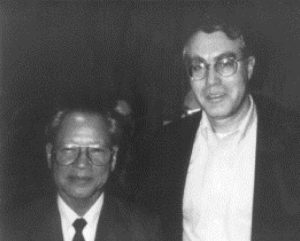
DE and Trần Văn Trà in New York, circa 1990.
For my purposes the real Wizard who was highly placed and powerful enough and yet close enough to the local realities to have a decisive impact on the way events played out on a weekly and monthly basis in places like Dinh Tuong was Sáu Đường, who was placed at the key intersection where grand revolutionary plans met hard reality. The Tet Offensive is a good illustration. Trần Độ was the deputy political commander in the southern provinces (B2] at the time. (I later met and interviewed him in Hanoi in 1982, when he had become the Minister of Culture and, still later, he became one of the highest level dissidents to ever break with the Vietnamese Communist Party). Trần Độ wrote, “I still remember that after phase 1, on the occasion of COSVN sending me down to where Tám Phương was [the provinces of the Central Mekong Delta where Tám Phương was the military commander], I met Sáu Đường, who at the time was the Party secretary of the region, and got into an argument with him. Now, thinking back on it, I believe I was stupid. Sáu Đường raised the question of how we could continue the attack in such a way that we could maintain a legal position for the people [e.g. not blow the cover of secret sympathizers living in Saigon-controlled areas by having them engage in overt activities]. But at the time there was a mind set of a ‘once-and-for-all attack’ [đánh dứt điểm] and bringing power into the hands of the people, so I wasn’t pleased to hear this man talk about maintaining a legal position [thấy ông này nói đến vấn đề giữ thế hợp pháp, xem ra không xuôi tai], so I argued with him that this was the moment to rise up and seize power, and that anyone who was opposed would be brought before a court and tried with no messing around. Why still talk about maintaining a legal position?”20
Despite this angry and ominous threat by the powerful General Trần Độ, the region Party secretary argued back. As the Northerner Trần Độ recalled, Sáu Đường told him, “No way, brother! We have been here a long time, and we see that as a matter of history, an uprising is not that easy. If we fight this battle, we also have to consider the possibility that the situation will not develop favorably, that the enemy will counterattack. Then what do we do? If they come back, how will the people [e.g., revolutionary supporters and activists] live? So there is no way we can’t think about the legal status of the people.” Trần Độ writes that, “listening to him put it that way, I had to admit that he was right.”21
It was only long after the war, when I came across his memoirs and was able to fill in the absolutely vital perspective of Sáu Đường, that many of the pieces of the Viet Cong puzzle in the central Mekong Delta began to emerge in a discernible pattern. During the time of the research I barely knew who he was since he was scarcely mentioned in the interviews and knew next to nothing about the rest of the Region 8 leadership. In fact it was the post-hoc memoirs and Party histories that finally began to flesh out the picture that I had only dimly understood at the time I was doing the Rand interviews.
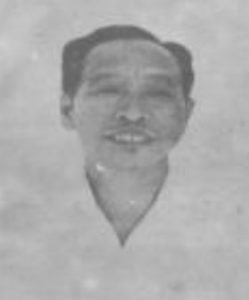

Nguyễn Minh Đường, Party leader of Region 8, which was comprised of the provinces of the central Mekong Delta including Dinh Tuong (My Tho). On Ho Chi Minh trail to Hanoi for a series of Politburo meetings following the 1973 Paris Accords
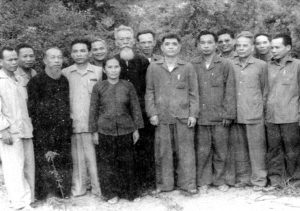
Nguyễn Văn Linh top Party leader in the South in center, fourth from right. Third from right is Nguyễn Minh Đường
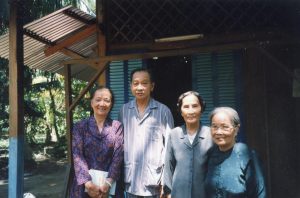
Sáu Đường and family in My Tho 2000 Photo DE
Even in my ignorance, I began to discover what I didn’t know, which was the beginning of wisdom in a venture such as finding the answer to the question, “who are the Viet Cong?” My first years examining the Viet Cong movement for Rand revealed that the image of the “faceless Viet Cong” was in some respects true, but quite misleading. Any movement which had been forced to operate as a clandestine opposition movement against an established authority trying to eliminate it from its inception will inevitably develop a cult of secrecy simply out of self preservation. When I started my research in Dinh Tuong province, I quickly discovered that the marginal hamlet and village members of the insurgency had only a hazy grasp of the leadership at higher levels; the district, province, and region – to say nothing of the secretive top leadership of the movement in the South – the Central Office of South Vietnam or COSVN.

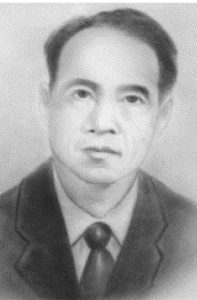
Photo of Nguyễn Chí Công (Chín Công, Chín Ốm, Chín Dư) in a base area. The leader of the Party organization in My Tho from 1962 to 1968, he often appeared as a shadowy figure in interviews with the Party rank and file in the province, and few had direct contact with him. On right is a studio portrait of Nguyễn Chí Công
In addition, Carver was correct in asserting that the purported leaders of the insurgency who were the public face of the movement, the top officials of the National Liberation Front were non-entities who had no real power or influence in the movement,
It is also possible that the image of the “faceless” Viet Cong was more a commentary on the gaps in CIA knowledge of the enemy than the invisibility of the cadres to the people they worked with. In his first trip to Vietnam in 1965 Kissinger queried the CIA on the nature and identity of the enemy. “Who exactly were the Vietcong? inquired Kissinger innocently. ‘They said they knew the Vietcong at the province level, but they did not know the names of the Vietcong at the district and fighting level and that in many cases they know only code names.’”22 It turned out that the reality was, the further down the hierarchy the more was known about the individuals active in the “Viet Cong.” In our Rand study, we had a great deal of information about “fighting level” insurgents, and even some information about key district cadres, but knew very little about the province level, and still less about leaders higher up than that.
But there is a contradiction between the two prominent ways in which the U.S. government depicted its enemy in Vietnam. The “Organization Machine” implied that all members, including the leaders, were simply cogs in the machine, and that distinctive personal qualities such as charisma were irrelevant. In a way, a faceless group would be the inevitable product of such a system and an indicator of its strength, rather than a weakness, since it would not be dependent on the individual qualities of its members, because they had all been poured into the same mold. If the cogs in the machine were all merely interchangeable parts, programs aimed at crippling the insurgency like the Phoenix program, would be much less effective in “degrading” its effectiveness. It was the idea that the organization mattered more than the people in it that the Khmer Rouge were trying to project in insisting that all their actions and orders were undertaken in the name of Angkar – The Organization.
.
Wizards of Armageddon
Mai had already gone to work for Rand as an interviewer in late 1964, and I met the original Rand team, Joe Zasloff, John Donnell and Guy Pauker a number of times in that period. It was Guy Pauker who made the original overture to me about joining Rand. My knowledge of the Vietnamese language and experience in translating Viet Cong documents were certain to be useful to Rand in its study of Viet Cong Motivation and Morale. Moreover, I had two years of graduate study which provided me with additional credentials for this think tank.
On top of that, Guy Pauker had studied at Harvard under my father, who had also been instrumental in obtaining an appointment for Pauker as instructor in the Government Department. As I found out much later, they had corresponded extensively about Pauker’s first trip to Vietnam. In the summer of 1956 Pauker wrote my father, William Yandell Elliott (WYE), on his impressions from an extended stay in South Vietnam. “Dear Bill: I have just reached half-time in my Vietnamese assignments and begin to have some feel for the local situation. I gave fifteen two hour lectures in French, with half the time devoted to questions. I spoke to members and especially cadres of the two organizations supporting Diem, the Mouvement de la Revolution Nationale and the Rassemblement des Citoyens. I had a three hour session with Diem and long talks with cabinet members their political advisors and knowledgeable Americans including our very attractive ambassador Frederick Reinhardt.”23
Pauker informed WYE that he would “now spend some two weeks in the provinces lecturing and talking to people. Some of the lectures are to civil servants, others to army officers, most of them to political groups. The main topic is constitutional government. This country has really achieved a political miracle. A basis for a stable government has been created. The population is certainly more confident in the government’s power to protect it than at any time in the recent past. As a result, while there is still a very serious problem created by the underground Viet Minh in South Viet Nam, I have the impression that they are over the hump. July 20 passed without incidents, and Ngo Dinh Ngu [sic – this innocent bowderlization of the given name of Ngo Dinh Nhu rendered it “Ngo Dinh Idiot”], the President’s brother, told me the other evening that it was due to effective security measures which thwarted Communist plans to organize demonstrations in Saigon, not in Communist ‘reasonableness,’”24
Pauker was under no illusions about the repressiveness of the Diem regime, but considered these traits necessary, given the challenges from the communists. “But the economic situation would be hopeless without our aid and countering Communist propaganda and subversive activities takes sometimes itself quasi-totalitarian forms. So there is much to be done, but Viet Nam has come a very long way since Geneva.”25 WYE duly passed along Pauker’s observations to the State Department and to Eisenhower’s national security advisor William Jackson in an attempt to build more support for Diem among skeptical Eisenhower officials in the State Department and the NSC (“You know how difficult the audience is there,” WYE wrote Pauker).26
Pauker, who had personally experienced the precariousness of life as a Jewish outcast in Romania during its Nazi occupation, and then persecution by the communists when they consolidated their grip on Romania following the end of World War II, escaping across three borders on foot and ending up in exile in the United States, became an object of derision in the academic community and even among his Rand Corporation colleagues for his malleable views. He was pessimistic about U.S. prospects in the Vietnam War but switched to supporting government policy. After expressing initial pessimism about the wisdom of American involvement in Vietnam and providing a trenchant supporting analysis, Pauker publicly defended the Johnson administration’s policy in the 1965 escalation. Hearing that there would be a televised debate between McGeorge Bundy and anti-war critics in the summer of 1965 and that Pauker would participate, “In a chorus, everyone present asked, ‘On which side?’”27 Later he was widely suspected of turning over a confidential study of the 1965 coup in Indonesia, circulated only to a select group of American Indonesian specialists because of its explosive content, to the generals who were accused by the study of provoking the coup, to the considerable professional detriment to one of the authors of this study, Ben Anderson, who was on my thesis committee at Cornell.28

Guy Pauker and DE 1964
Given this relationship between my father and Pauker, as well as my own credentials, my path to Rand was probably over determined. In addition, my father had extensive contacts with Charles A. “Chuck” Thomson throughout the 1950s, when Thomson was an official of the Rockefeller Brothers Study. By 1963, Thomson had moved to Rand. In her history of Rand in Vietnam, Mai Elliott writes “Chuck Thomson was then the administrative officer of the Social Science Department, focusing on problems of budgeting, reporting, and personnel, but also working on issues of command and control, and U.S. civil defense. In Saigon, as Leon Goure’s deputy. Thomson helped with the development of the [interview] questionnaire and with staff issues, and would co-author some of the reports. Whenever Goure returned to the United States, Thomson would fill in as project manager.” Tony Russo, a young analyst who joined the Saigon project, described Thomson as “a craggy, snow-haired man in his 50s” with “the air of a stern schoolmaster.”29

Chuck Thomson at Rand Saigon, circa 1965
My first encounter with the new regime that would replace Zasloff, Donnell and Pauker, was with the newly appointed project director, Leon Goure. After processing out of the army at Travis Air Force Base, I went to Santa Monica to sign on with Rand. I was there only for a few days – long enough to get a feel for the structured informality of the place. Because of a surfeit of PhDs, Rand had adopted a policy of first-name informality, and formal titles “Dr. This and Dr. That,” were frowned upon. Everyone called the President Frank Collbohm “Frank” and security guards and Rand superstars were all on a first name basis. For a place which had the reputation of nurturing the “Wizards of Armageddon,” and providing a platform for “Dr. Strangelove,” Rand had a disarmingly mellow and breezy ambiance. The building had the institutional and architectural profile of a retirement home, perfectly situated by one of Southern California’s best beaches.


Rand Corporation headquarters Santa Monica
I didn’t rub elbows with many Wizards of Armageddon, but spent most of my time with the friendly and efficient administrative assistant of the Social Science Department, Rita McDermott. For me she was the face of Rand, which I found would be a supportive environment to pursue my quest of understanding America’s enemy in Vietnam. It seemed like an unbelievable stroke of luck to find a platform which would provide the necessary entrée and material support to pursue this goal.
After a short stay in Santa Monica, I joined Leon Goure, the newly appointed project director of Rand’s Motivation and Morale Program in Saigon, for the return trip to Vietnam. I was familiar with the previous iteration of this program under Zasloff and Donnell, but did not yet know that Goure’s appointment to succeed them marked a major shift of orientation from the original goal of finding out “What Makes the Viet Cong Tick.” This story is expertly told by Mai Elliott in her book Rand in Southeast Asia, and I will not repeat it here.

Leon and I stopped over in Hawaii to attend a briefing on Vietnam at the headquarters of the Commander in Chief, Pacific (CINCPAC). Leon was appalled that I had not bought anything for Mai, and shamed me into buying a gift at the airport. Since I was then, as well as now, a jerk who ostentatiously rejected commercial conventions like greeting cards and Valentine’s Day observance, I only partly bowed to Leon’s pressure. I bought a cheap key chain on a rabbit’s foot to make the statement that I would not be dictated to by convention. Leon was even more appalled at this flouting of sentiment and good manners. Whatever his flaws, Leon was extremely thoughtful and considerate in human relations generally and, of course, courtly and a great gallant in his dealings with the opposite sex. He was, therefore, amazed to encounter someone as obtuse as me. Fortunately, Mai took it in stride and responded philosophically that it was the thought that counted. Not only did this “gift” not have great sentimental value, it was of little practical use since Vietnamese rarely carried keys around in those days (someone was always home so the doors were rarely locked, and very few had a motorized vehicle at the time).
At the CINCPAC briefing in Honolulu I was intrigued by the experience of watching the upper echelons of the system in I which I had been a remote appendage at the lowest levels of the chain, but it also made me aware the for all the trappings of power and the sense of being a privileged witness to the inner circles of government, that the briefers did not seem to be particularly insightful or well informed. CINCPAC seemed very distant from the realities of Vietnam, and I certainly did not sense any sense of desperation or urgency, even though we now know the situation was unraveling in Vietnam at a rate not fully understood even by Americans who were in the country. There were certainly no intimations that within a month Marines would be on their way to salvage the situation. But the fact that these briefings were being given in the rarified atmosphere of CINPAC, and were presumably passing on knowledge accessible only to the very powerful, gave the contents of their briefings an authority which was not warranted by its intrinsic merit. At the time, however, I accepted it on the grounds that it represented an informed view far about my pay grade. In my new civilian status, I was the equivalent of a GS-12, equivalent to Captain, according to my newly issued civilian ID card for MACV. It was a significant step up from Specialist 5th class.
Leon became a polarizing figure both inside and outside Rand, as Mai’s Rand book makes clear. Like many others, even among his critics, I found Leon charming and personable – something of a likeable scoundrel. We enjoyed a relaxing evening in Honolulu after the CINPAC conference, watching the show of the leading Hawaiian entertainer of the period, Don Ho, before continuing on the long flight to Saigon. On arrival, Leon and Chuck Thomson and I began to discuss how my talents could be put to best use.
I can no longer remember whether or not my first major interview done for Rand was specifically targeted to explore the subject of psychological warfare, or whether the interview subject was selected on the grounds that he was the highest-ranking defector then available for interview at the Cholon Chieu Hoi center, but the first interview I undertook was with a member of the Propaganda Section for the Saigon-Gia Dinh Special sector. Mai joined me on April 21 and again on April 23, 1965 to do an interview which, transcribed and typed totaled 60 pages. I will call the subject of the interview “D.”
“D” had joined the revolution in 1961 after being discharged from his job as a clerk typist in a district in the lower Mekong Delta because he did not have an elementary school diploma. He went to Saigon and opened a small shop making cabinets for radios. “In 1961, I met a VC cadre, a friend of mine, who propagandized me on the dictatorial nepotistic rule of Ngo Dinh Diem. He accused the Americans of being imperialists like the French. At that time I did not fully understand the question of the Americans being imperialists, but I could understand very well that Ngo Dinh Diem was maintaining a dictatorial family rule in South Vietnam and that Ngo-Tran [Ngo Dinh Diem, his brother Nhu and Nhu’s wife Tran Le Xuan] controlled the economy of the country and monopolized the market. They oppressed the people and I hated them. I therefore agreed to work for the Front. I joined the Front out of my personal grievances for having been discharged from my job by the GVN [Government of Vietnam].”30
I didn’t know it at the time, but his brief personal history was a tip-off to a major development in the evolution of the revolutionary movement, which escaped Rand, as well as U.S. and GVN intelligence at the time. Only in 1967 did I learn from Rand interviews in My Tho that in 1961, the year that “D” joined the revolution, there was a massive purge of former Resistance members ordered by Directive 137 from the Central Committee in Hanoi. The purpose was to “rectify” and purify the ranks of the Party and clear the way for an infusion of new members who would be younger, more obedient, and not compromised by any “mistakes” in their past.31
The first Rand study in 1964 had emphasized the continuity of the “Viet Cong” with the anti-French Resistance movement, the Viet Minh, and cited this as evidence of the deep nationalist roots of the revolutionary movement. In fact “D”’s case shows how complex this subject is. Although he joined the “Viet Cong” in 1961 as part of the new intake to replace purged members, he himself had been involved in the Viet Minh movement as a clerk typist for various District Finance-Economy sections in the southern Mekong Delta, before being dismissed by the Viet Minh for his irascible behavior in 1951. In 1952, increasing French military pressure on his village forced him to seek refuge in Saigon, where he could be anonymous and opt out of the war. Ironically, it was his dismissal from a similar clerk-typist position with the GVN that pushed him to join the Viet Cong. Because he had not been a Party member in his previous stint with the Viet Minh, but only a mere clerk, he was evidently allowed to start with a clean slate, but if I had known about Directive 137 when I interviewed him I might have spent more time on discovering how someone with such an initially sketchy grasp of the key ideological issues (he “did not fully understand the question of the Americans being imperialists”) when he was recruited. and a checkered past, had made his way to such an elevated political position, in the propaganda sphere, no less. This is an illustration how little I knew at the beginning of my Rand career. Only decades after the war was over was I able to reconstruct what the interviews were really telling me, and identify the questions that I had been too ignorant to ask at the time.
The interview with “D” went into laborious detail about the organizational structure of his unit, the Propaganda Section of the Saigon-Gia Dinh Party Committee, which was responsible for Saigon and its suburbs, and reported to COSVN, which directed the revolution in South Vietnam. These details were of interest to me, because I was still trying to flesh out the organizational structure of the Party in South Vietnam which I felt was the main source of strength for the revolutionary movement. What interested Chuck Thompson, however, was the elaborate detail in the interview about how revolutionary propaganda was devised at a high level, and “D”s scathing critique of GVN propaganda, as being irrelevant and unpersuasive to its target audience. It was probably Chuck Thomson who saw this as a fruitful avenue of research to complement the ongoing Motivation and Morale Study, which was in the process of being redirected from studying the strengths of the Viet Cong to finding their vulnerabilities and weaknesses.
Leon knew exactly what he wanted to accomplish, and plunged into a study of the effects of bombing on Viet Cong morale which he hoped would solidify the institutional position of the Air Force, not coincidentally the main defense sponsor and funder of the Rand Corporation. Ultimately Leon’s attempts to curry favor and advance himself backfired, and he was eventually eased out, and Rand’s reputation suffered badly by his manipulation of the interview data.32 Although Chuck Thomson co-authored many of Leon’s controversial reports and evidently had no problems with either the methods or conclusions, he sought alternative projects that he could work on without being under Leon’s shadow. Psychological warfare seemed to be a field which Leon had only a peripheral interest in (especially in how the terror of bombing could be exploited) but he left this subject largely to others while he focused on issues closer to the interests of his Air Force patrons. This left an opening for Chuck Thompson, who shopped my interview with “D” around town. It eventually morphed into the first Rand study, which I co-authored with Chuck, and which took a slightly different direction from the main Motivation and Morale study in focusing on low level civilian cadres and their vulnerabilities.
As Leon and Chuck looked around for a project to assign to me, the topics of “vulnerability” and “psywar” suggested themselves, because these were areas in which MACV generals did not claim any particular expertise. In addition, “psywar” seem innocuous in that it did not challenge anyone’s turf and, at the same time, seemed as though it could be marginally useful. So Leon presented MACV with a proposal to do a detailed study of these issues in a single province, in order to gain the depth of knowledge and continuity of understanding that was difficult in a country-wide study in which neither the interviewers nor the analysts gained a profound grasp of a specific area.
“In June 1965, General Westmoreland requested that the project be undertaken to uncover the vulnerabilities of the Viet Cong, as well as to determine the kinds of programs that should be formulated to exploit their weaknesses and ways to measure the effectiveness of such programs. Besides Westmoreland, General William E. DePuy, the operations chief for MACV, was also enthusiastic because he wanted an in-depth study that he hoped would yield information about the Viet Cong so that the military could fight them more effectively.” As noted in Mai’s book Steve Hosmer, another Rand analyst who played a prominent role in the Vietnam program during the mid-1960s, later said that in 1965 “General DePuy had not turned against counterinsurgency in favor of all-out conventional warfare against the enemy.”33

General William DePuy, Westmoreland’s operations officer
I recall a dinner at Rand’s villa at 176 Pasteur organized by Leon, during which I engaged in conversation with a rather diminutive and un-martial man in civilian clothes to whom I had not been introduced. Thinking him a civilian non-entity I was not, as I recall, particularly deferential to his opinions or to his status. It turns out that this was General DePuy [pronounced DePew], as I soon discovered. To his credit, DePuy did not flaunt or assert his rank, and listened politely to my opinions (though I can no longer recall the substance of the exchange).
It seems that Hosmer may have misread DePuy’s approach to the war in this early period. Neil Sheehan writes that “The Vietnam to which John Paul Vann returned in late March 1965 was a nation on the threshold of the most violent war in its history. At the beginning of the month, Lyndon Johnson had started Operation Rolling Thunder, the bombing campaign against Vietnam. Two U.S. Marine battalions, the first of many to follow, had landed at Danang to secure the airfield there as one of the staging bases for the bombing raids. At MACV headquarters in Saigon, William DePuy, then a brigadier general and Gen. William Westmoreland’s chief of operations, had taken the first step in planning that was to bring hundreds of thousands of U.S. troops into South Vietnam with artillery and armor and fleets of fighter-bombers for a new American war to destroy the Vietnamese Communists and their followers. “We are going to stomp them to death,” DePuy predicted.”34
Nonetheless, DePuy did not stand in the way of more nuanced approaches to dealing with the Viet Cong, nor did Westmoreland. “To conform to Westmoreland’s interest, Leon Goure defined the project’s objective as helping improve the ‘the Psychological Warfare effort in [Dinh Tuong] province.” Goure envisaged the project as an operation that would unfold in three stages. At the beginning, the focus would be on ‘uncovering vulnerabilities’ among the enemy military and civilian ranks. Afterward, psychological themes and appeals would be developed by the GVN, with advice from American officials to target these vulnerabilities. Finally, the effectiveness of these appeals would be measured through interviews.”35
It could be that the future direction of the My Tho project was not fully determined by Westmoreland’s request in June 1965 that it explore Viet Cong vulnerabilities and that I had a more proactive role in defining the parameters of a study that would be distinct from the Motivation and Morale project. Over a half century later I came across a letter written by Mai to my parents on July 23, 1965 in which she said “Dave has also written a letter to Richard G. Stilwell, MAC-V Chief of Staff, in which he exposed his ideas on the need to conduct research on VC organization. He’s still hoping that Rand would OK this project. I hope the project would get off the ground because this is something Dave is really interested in.”36 I can’t recall the origins of my personal contact with Stilwell (no relation to “Vinegar Joe”) but I met him several times. He knew my father and when we accidentally crossed paths at Tan Son Nhut inquired after his health. Stilwell had been a protégé of Westmoreland throughout his career. So it is possible that this letter had some impact and that Stilwell had some role in facilitating the orientation of the Dinh Tuong program toward the study of Viet Cong organization. In any case that was the focus that evolved.

Maj. General Richard G. Stilwell,
Chief of Staff, Military Assistance Command Vietnam 1965
Introduction to My Tho

Aerial view of the town of My Tho and the upper branch of the Mekong River November 1967

Dinh Tuong province was a large (population 500,000) and geographically important province that linked the lower provinces of the Mekong Delta to Saigon along the key land route of Highway 4. Most of the rice from the Delta that reached Saigon came along this route or the Cho Gao canal which connected the upper branch of the Mekong River to Saigon. It was the home of one of South Vietnam’s best divisions, the Seventh Division. The Viet Cong referred to Dinh Tuong province as My Tho province, which was also the name of its capital town, 35 miles south of Saigon.
The combination of strategic importance and accessibility – Highway 4 was generally secure during the daytime and, depending on traffic, the trip to My Tho could be done in less than two hours – made it an obvious choice as a test case for a detailed micro-study of the war. The first interviews of what became the “DT series” [Dinh Tuong] were actually done by a Saigon-based team within the framework of the ongoing Motivation and Morale Project. In June 1965 I was joined by my fellow graduate students at the University of Virginia, Nguyễn Mạnh Hùng and Tạ Văn Tài who had recently returned to Vietnam after finishing their PhDs, and were teaching at the National Institute of Administration. They agreed to temporarily help out as the program was just getting established.
About that time Mai and I decided to move to My Tho from Saigon. We had been working out of our house in Saigon since my arrival with Rand because the Rand village at 176 Pasteur was overcrowded.

DE looks over manuscript in his home office at 223 Phan Thanh Gian in Saigon ca 1965
As more interviewers joined our team and the operation expanded we would have to expand our local presence in Dinh Tuong. Finally, Mai was concerned about my driving to My Tho on a weekly basis. Even though Highway 4 was generally secure during the daytime, the unexpected was always possible, as in the picture below of the junction just outside of the town of My Tho where Highway 4 turns west and bisects the central districts of Dinh Tuong province.

Flaming remains of a bus which had been mortared during the daytime at Trung Luong intersection near the town of My Tho, 1966.
So we rented a Citroen from Col. Phước, put all our worldly possessions (which were not many) in it, and drove down to My Tho where we had rented a house.
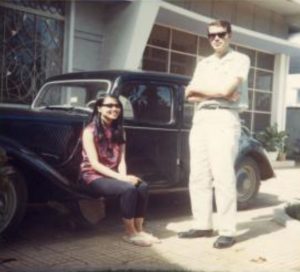
Mai and DE in rented Citroen, May 1966
Unfortunately the Citroen broke down halfway to My Tho, in the province of Long An. Although traffic was fairly heavy, the spot was deserted except for a brick kiln about 100 meters from the road. I was able to hitch a ride on the back of a passing motorbike, whose driver kindly transported me to the province town of Tan An. I went to the U.S. military advisors’ compound and explained the situation and asked for assistance. My wife is stranded in an exposed area, I said, and it is urgent that we get the car back in motion. Upon discovering that I was a civilian and that Mai was not an American, the advisors lost all interest and declined to help. This was a rare exception, since all my future dealings with American advisors were very positive and cordial. Fortunately I located a Vietnamese mechanic who drove me back to the stranded vehicle and fixed it. We then completed the trip to My Tho. Although we subsequently would often drive to Saigon for the weekend, we did not have further problems with the Citroen, which proved quite reliable. I later discovered that the brick kiln, the only nearby structure in sight where we had broken down, was a notorious Viet Cong sniper’s nest. I’m glad I didn’t know that at the time, because it would have left me in an impossible dilemma about leaving Mai to seek help.
We moved into our new house at 27 Hung Vuong, the main boulevard of My Tho, and went to work immediately interviewing defectors the Dinh Tuong Chieu Hoi Center.

Dinh Tuong Province Chieu Hoi Center 1965: left to right DE, the director of the Center, and Đinh Xuân Cầu
In some ways these first encounters with former Viet Cong were as much an education for my grad school classmates Hung and Tai, who had volunteered to help out in order to get the project started, as for me. One of the “ralliers” (defectors) was induced to sing Gỉai Phóng Miền Nam [Liberate The South] the anthem of the “Viet Cong” – a rousing agitational number with bone-chilling lyrics. The innocuous young man sang in a froggy teen-ager voice:
to liberate the South, we decided to advance,
To exterminate the American imperialists, and destroy the country sellers.
Oh bones have broken, and blood has fallen, the hatred is rising high.
Our country has been separated for so long.
Here, the sacred Mekong, here, glorious Truong Son Mountains
Are urging us to advance to kill the enemy,
Shoulder to shoulder, under a common flag!
https://www.youtube.com/watch?v=0K8okWdJ2xg&list=RD0K8okWdJ2xg&start_radio=1&t=37&t=0
“How bloodthirsty!” Tai, exclaimed. Even accounting for the hyperbole of a song designed to stir hatred to motivate action, these words made it clear that the insurgency did not intend to deal nicely with their enemies. One of the recurring and characteristic terms in the interviews was “diẹt gọn” (“exterminate completely,” or “wipe them off the face of the map!”). This was a language which General De Puy (“stomp them to death”) could understand.

University of Virginia classmates Nguyễn Mạnh Hùng and Tạ Văn Tài and wives 1967
The Year of the Big Change
The first year of interviewing Viet Cong prisoners and defectors in My Tho, from May 1965 to May 1966, was an incremental learning experience. The object of our study, the revolutionary movement in My Tho province (the revolutionary name for Dinh Tuong province) was in consant flux, and the situational environment which provide the context of the study was evolving rapidly as the American military presence dramatically escalated following the initial insertion of two Marine battalions in March 1965.
As summarized in my book The Vietnamese War, the revolutionary leaders called 1965 “the Year of the Big Change.”37 The “big change” was, of course, the deployment of large numbers of U.S. combat troops in Vietnam. This changed the nature of the war from a “special war” in which U.S. support took the form of advisors and economic assistance, to “limited war” in which the U.S. troops engaged directly in combat, but limited the scope of operations to South Vietnam (as the Korean War had limited the scope of hostilities within Korea). The conflict was transformed from a guerrilla war to a conventional war (on top of the continuing guerrilla struggle). This, in turn, led to a big change in policy – several changes, really. The first was a reversal of the brief leftist shift in revolutionary policy which had been aimed at intensifying land reform to benefit poor peasants, who would become the main political base for the military mobilization to finish off the war before the U.S. could intervene. Le Duan and other leaders had talked of an imminent “general offensive and uprising” at the beginning of the year, but this was replaced by the theme of “protracted war” after the size of the U.S. miltitary intervention became clear.
In historical retrospect the most important change that happened in 1965 was the accelleration of a vast socioeconomic transformation in the countryside that, in the long term, undermined the rural base of the revolution. Of course it was only many years later that this biggest change of all became obvious. Individual proprieters termed “middle peasants” (“trung nông,” who owned all the land they farmed and did rent any of it out or hire laborers) by the Viet Cong increased in prominence, and it was they, not landless peasants, who filled the void left by the demise of the landlord class. This was the “yeoman peasant class” that the U.S. had once hoped its policies would produce to become a bulwark against collectivization and a counterweight to the poor and landless peasants who were the social and political base of the revolution – began to emerge as the dominent force in the rural areas. As I wrote in The Vietnamese War; the “middle peasantization” that was already evident in 1965 “posed a dilemma for the revolution. On the one hand, it represented the obverse of the decline of the landlords, and was a sign of greater equity in land distribution. On the other hand, the Party did not trust the middle peasants, because their class interests would not necessarily carry them all the way to the end of even the ‘national democratic’ revolution, let alone the socialist revolution. In Long Hung village, the ‘cradle of the revolution’ in My Tho, ‘after the land reform was carried out in the village, the poor and very poor peasants contributed to the Front even more zealously. The rich and middle peasants began to leave their fields and orchards to go to the GVN areas.’ When the land distribution was first launched, the ‘middle peasants didn’t dare oppose it. When the Front gained complete control over the village, the middle peasants saw that the Front didn’t harm their interests and began to get to like the cadres and supported the Front from 1961 to 1963. But in 1964, when the Front imposed the agricultural tax in the village, they began to be disgruntled and left their homes to take refuge in the GVN areas. So now [1967] the village Front has concluded that the middle peasants belong to the vacillating and passive element of the national democratic revolution’” [DT185]. Since the middle peasants were already becoming the dominant class in the countryside in 1965, “this was an ominous portent for the revolution.”
We really didn’t fully comprehend the situation in My Tho we encountered in the spring and summer of 1965 until the following year, when we had more perspective on the events and were able to talk with more knowledgable people who were able to tell us more about what had been going on at that time. It is probably in the nature of a prolonged and in-depth study like ours in My Tho that understanding comes after the fact, usually long after the fact. Therefore it was pointless to expect any policy relevant breakthroughs derived from interview information in this early stage of the project.
This must have been a disappointment to Leon, who was constantly trying to beat military intelligence to the punch with “scoops” derived from the interviews. “As Goure saw it, his project was supposed to be militarily-oriented and to assist ‘the war effort.’ Although his team [in Saigon] continued to gather information regarding motivation and morale and although eventually several substantive studies did emerge from the data – the project, in his view, was not meant to be a mere continuation of the work of Zasloff and Donnell because that ‘was not what the chief of intelligence of he Air Force wanted, Of course not – he was not interested in that – he wanted to know about the war and the effectiveness of the war, how you fight the war better. The military was not interested in that kind of [social/political study] … It might have been set up that way originally, but it was certainly not the direction that they asked me to do.’ By the time he became involved, it seemed to him that the project was essentially an intelligence thing…[and that] ‘We’ve got the best damn intelligence in the war.’”38 Ironically, in trying to beat military intelligence to punch on relatively secondary issues like changes in military tactics and patterns of defection, Rand – the supreme think tank – missed the biggest story of the war, the accellerating erosion of the socioeconomic base of the revolution. Unfortunately for the U.S. and the Saigon government, this was a gradual and prolongued process and the consequences were not fully apparent until after the war was over. As the process was unfolding in the latter years of the war, it turned out that the losses in the Viet Cong’s socioeconomic base were not transferred to the side of the Saigon government, which proved unable to expand its support base with these dropouts from the revolutionary movement.
Leon gave frequent briefings on fast-breaking topics that emerged from the interviews, and would often design short questionaires to pursue these new issues. As Mai Elliott’s Rand book observes “Goure now became a star of the briefing circuit. He gave so many briefings that he could not recall the total. Goure ‘would give a briefing at the drop of a hat,’ some of the staff members would later say, and they would come to refer to those presentations as ‘quickies.’”39 I recall that Leon himself proudly referred to short written reports that he circulated in Vietnam as ‘quickies,” and considered the topicality and rapid response as an asset that was unique to Rand’s Saigon operation. His Rand colleagues in Santa Monica were less thrilled with the “quickies” since Leon used the pretext of timeliness to circumvent the normal Rand review process, which he surely know would not only be time-consuming, but critical of his findings.
The American staff members of Rand based in Saigon chafed under the burdens of being constantly mobililized into Leon’s “quickie” projects, and soon became disillusioned with the way in which Goure had transformed the original Motivation and Morale project. For me, being in My Tho provided a distance that afforded considerable independence. Afther the initial setting up of the program, I was left largely to my own devices. Occasionally, Leon tried to bring me into his plans to raise Rand’s visibility to the movers and shakers in Vietnam, but this happened rarely, and the few attempts to do so backfired, as we shall see. It also took some time to produce a formal written report on the study. The first was “A Look at the VC Cadres: Dinh Tuong Province 1965-1966, which was not published as a formal Rand Memorandum until March 1967. The second was “Pacification and the Viet Cong System in Dinh Tuong province: 1966-1967,” which, though submitted in October 1967, did not appear as a Rand Memorandum until January 1969.
In a way, positioning the My Tho project as a long-term study was consistant with the original rationale for restricting the study to a single province to get the depth and context which transitority visits to scattered sites around the country could not achieve. Given the limited number of higher level prisoners or defectors available in the confines of a single province at any given time, finding a significantly informative interview subject would be a rare event. It would be the cumulative contributions of many lower level interviewees to establish trends over time rather than the revelations of a “D” about the higher levels and policy aspects of the revolution that would allow us to achieve our goal of better understanding the state of war in one small slice of it, and obtaining some kind of reality check on how the war was progressing in at least one significant area.
A good illustration of this is what happened in the first two months of interviewing in My Tho. We did not yet have an established base there, but commuted to MyTho town, checked into the one barely tolerable hotel, and proceeded to the the province Chieu Hoi Center. We did not, at the beginning have the contacts to gain access to prisoners.Only when Nguyễn Hữu Phước joined us in July 1965 were we able to talk with prisoners, using his contacts with military and security officials. Phước became our entrée to military and civilian prisoners.
After a few interviews with village cadres who had defected, we spent the next several weeks learning the stories of some representative members of a large group of young men who had been forcibly drafted and marched out of the Mekong Delta, headed for the Central Highlands, where they would serve as fillers to Viet Cong main force units being reinforced to fight the Americans.
The compulsory drafting of recruits by the Viet Cong had started in 1964, in some areas as early as 1963, and was directly related to Hanoi’s December 1963 decision to “go for broke” and try to militarily defeat the Saigon government while it was still in disarray after the Diem coup and before the Americans could intervene. Also in 1964 compulsory taxation also replaced “contributions” to the revolution which had been compulsory in all but name. Now the consequences of defying the exactions demanded by the revolution were extremely serious, as all pretense of persuasion was abandoned. The combination of draft and taxes created a backlash against the revolutionary movement and created great problems for the local cadres who had to enforce these unpopular policies. The first phase of the My Tho study examined this issue in detail, and it was the subject of the first report issued on the My Tho research.
By chance, the wave of compulsory drafting reached its peak in May and June of 1965 just as we were beginning the study. After that, the intervention of U.S. combat troops compelled the revolution to abandon its “go for broke” approach, and shift to a policy of protracted war which abandoned the buildup of conventional main force troops in the Iron Triangle and the Central Highlands, and dramatically reduced the transfer of young men from the Mekong Delta to those areas. Sixteen of the first 33 interviews were with new recruits, who had been forcibly dragooned in early May 1965, in groups of a dozen or so from villages in the central part of the province. They were marched to a central collection point near the abandoned Buddhist temple Chùa Phật Đá in Cai Lay district.
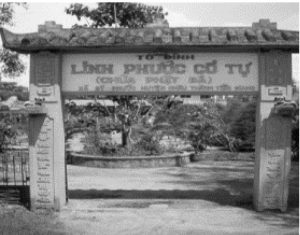

Chùa Phật Đá circa 1999. On right is the nearby Nguyễn Văn Tiếp canal on the edge of the Plain of Reeds.
From Chùa Phật Đá the consolidated groups of draftees crossed the Plain of Reeds into Tay Ninh province, near the Cambodian border. Most of the group that we interviewed had ended up on the Iron Triangle area in the Bời Lời woods, where I had witnessed the forced evacuation of a hamlet near the village of Bến Sức earlier that year when I was still with MACV. Providentially for these new recruits the defoliation of the Bời Lời woods in the Iron Triangle that had already been done was sufficient to allow them to see a path of escape, and large numbers of them defected.
We didn’t learn a great deal from these new recruits other than the fact that Chùa Phật Đá seemed to be the central nexus of their communications and liaison system. This was an early indication that the image of the guerrilla as someone who was “everywhere and nowhere,” disconnected from the geography of their area of operations, was a myth.40 As we later discovered, the liaison routes and base structure of the Viet Cong in Dinh Tuong were relatively fixed, although they were used in an unpredictable rotation. In a way this was the beginning of our discovery of the geographical “face” of what I came to call the “Viet Cong System” in My Tho. Saigon had its “Dinh Tuong province” and the revolution had its “My Tho province.” They both existed within more or less the same provincial boundary (although “Viet Cong” My Tho province included an additional district, Go Cong, that was a separate province on the GVN side), but an overlay of areas of control, routes of communication and the like would have shown that each side’s grid filled in the empty spaces left by the other. The difference was that large sections of the Viet Cong grid were inactive most of the time, until they were needed for specific purposes. This insight was sparked by a pivotal interview that Cầu did with a deputy platoon leader of the 514th battalion [DT110] in March 1966 – another example of Cầu’s ability to dig beneath the surface.
His observation that the 514th and other concentrated units operating in Dinh Tuong province actually had a network of prepared fortified positions that were the equivalent to the military posts of the GVN. The only difference was that they were only sporadically occupied in random patterns that kept the GVN guessing which ones they might be in at any given time. It was like the shell game once proposed by the US to set up an underground network of missile sites, which could contain mobile missiles connected by rail lines hidden from sight, that would create uncertainty on the part of Russia as to which sites were occupied, and complicate any counterforce strike plans they might have.41
From this basic insight, we were able to discover the elaborate network of communication and supply routes that connected these prepared fortification, and from that we learned how this protected the political cadres in Viet Cong controlled areas by casting a “psychological umbrella of security” over the “liberated areas” by raising the threshold of force required by the GVN to enter a Viet Cong zone simply by creating uncertainty as to whether or not they might meet a large Viet Cong force. The large and cumbersome “sweep” operations of the ARVN Seventh Division were always known in advance to the Viet Cong, who simply left the area until the operation was over. It was not until the U.S. Ninth Division came into the province, especially in the post-Tet 1968 years that this system broke down.
We began early on to get a more detailed picture of a few villages because of the defections of several people from the same village whose stories could be cross-checked amplified and expanded. In general this did not happen until after six months or so of the study, but one village that stood out early on was Hồi Cư in Cái Bè district. It was an elongated village that connected the Plain of Reeds with a critical segment of Highway 4, the lifeline route of the GVN which ran through the middle of the province, cutting into northern and southern sectors.

Because of this geographical quirk, close to key GVN locations but connecting to a secure base area for the Viet Cong, this village was important to the Viet Cong.
Whatever “quickie” intelligence might have been derived from our interviews of the fleeing draftees would have been misleading. Instead of being a harbinger of a new phase in the war, it was was the last gasp of a policy (”go for broke”) that had already been abandoned as obsolete. We did have enough sense to focus on the impact that the escalation of draft and taxes had on the relationship between the local cadres and the rural population in both Viet Cong-controlled and contested areas.
Another development that accellerated in 1965 which began to show up in the interviews was the depopulation of the countryside which, over the remainder of the war intensified and created a massive demographic shift that drove the socioeconomic ascendancy of the middle peasants. In the late 1960s Harvard political scientist Samuel Huntington cavalierly termed this “forced draft urbanization,” which meant, essentially, bombing and shelling the peasants out of the countryside and forcing them to take refuge in the cities where, as Huntington noted, they could be more easily controlled by the Saigon government. Leon was unfazed by the “collateral damage” of his recommended policy of intensive bombing of the rural areas. In some ways he anticipated Huntington with his pithy, if cynical, remark “we’ve got the onus, let’s get the bonus.” In other words, we should turn the negative of “collatoral damage” into the positive of pushing the peasants into areas were they could be more easily controlled.
In Dinh Tuong province, a “free fire zone” was established in the heartland of the province (the “20-7 Zone” named by the Viet Cong in commemoration of the July 20, 1954 signing of the Geneva Accords). This was the most heavily populated and prosperous area in the province, and its central location was vital to the Viet Cong base structure and supply routes. The people who lived there were told in the announcement (audio clip below) that starting from January 15, 1965, the GVN would bomb and fire artillery at will, and anyone who chose to remain in this area would not be eligible for compensation for loss of life or property. The resulting exodus of refugees began the demographic hollowing out of the rural villages, which became the main engine of “pacification” for the remainder the war.
GVN announcement of establishment of a “free fire zone” in Dinh Tuong as of January 15, 1965
After the war, Chín Công, the shadowy province leader of the Viet Cong in My Tho described the beginnings of the great rural demographic shift that began in 1965.
Going into 1965 the enemy fiercely and destructively fired into the liberated area, driving the people out to live along the roadsides, while they zealously prepared for a limited war [the intervention of U.S. troops]. The situation became difficult. How could we hold the people in the liberated areas? Before, when they [the GVN] used infantry to grind down and round up the people, we could use the “three spearheads” of political and military action along with military proselytizing to stop them, because they were flesh-and-blood human beings. Now the instrument used is iron and steel raining down from the skies. The gang that does this is not there on the spot, so how can you stop them? The Current Affairs Section [of the province Party committee] constantly met to discuss this. I concluded that we should resolve to mobilize everyone, cadres, soldiers, and people, to dare to cling to their turf. The leadership must set the example, and the fiercer and more difficult it is, the more they need to set an example. Brother Muoi Ha raised the point that the people in Ap Bac had spontaneously left for the open rice fields and set up straw huts at the edge of their fields. At the beginning they only set up some crude straw roofs as shelters for them during the day, and returned home at night. But later, as the [GVN] continued to shell into the treelines [where the settlements were], they built more substantial houses in the fields. The other brothers said that it was not only Ap Bac that did this. By day the people wore white clothes and moved back and forth. When enemy planes came to strafe, they just went about their business normally and it appears that the enemy got used to this, so that this became a way of becoming legal with them. From this phenomenon a solution to the problem of holding onto the people gradually emerged.42
Although, as Chín Công asserts, the Viet Cong eventually found ways to diminish the impact of this rural reconfiguration of the population, this dispersal of the village settlements had an inevitable impact on the Viet Cong ability to mobilize the population.
Until 1965, the village cadres in Viet Cong controlled areas had been able to mobilize the population under their control to engage in political confrontations with GVN authorities, known as “face to face struggles” [đấu tranh trực diện] in which a group of several dozen villagers, motivated and held together by a handful of activists or “backbone elements’ [nòng cốt] would confront local GVN authorities and demand compensation for damage from shelling, or release of people who had been arrested. This was a risky venture for the villagers and mobilizing them for the task was a tricky problem for village cadres, who could not themselves join the demonstrators because the risk of exposure and arrest was too great. The “backbone elements” thus were the key to success. Since they were not Party members or actual cadres – at most they would be members of the hamlet or village Women’s Association – the risk of arrest and imprisonment was minimal. But they were the eyes and ears of the cadres, and would report back on villagers who wavered in their task.
When I wrote the first Rand Memorandum on the cadres in 1966, I was looking in the wrong direction for the vulnerable stress points of the Viet Cong local movement in focusing on the link between the village leaders and the Party district organization above them. I should have been looking in the opposite downward direction to this erosion of the crucial “backbone elements” who were the most direct link between the Party and people. Many of these had been forced to abandon their homes, either to move to more secure GVN controlled areas or to live temporarily in the ricefields. In the later phases of the Rand My Tho study I did put increasing focus on the shifting societal context of the revolution, especially the consequences of rural depopulation, and less on its organizational structure and mechanics.
The reason I emphasized the link above the leading village cadres rather than the link below them was that I wanted to shift the focus from what I considered marginal members of the revolutionary movement to those in more critical positions, and reduce the indiscriminate arrests of mere sympathizers. From a humanitarian point of view this was laudable, but it overlooked the fact that the link between the nòng cốt activists and the sympathizers was essential to political mobilization in the villages.
Looking at the village cadre links with higher echelons more than examining the critical support they received from below, from the nong cot and civilian sympathizers was the consequence of operating from the “organization theory” assumptions about the nature of the insurgency. As I increasingly discovered, while an effective organization was a necessary condition for success in an insurgency, without a strong base of support in the larger population, the organization could not mobilize the resources and political support it required.
I take the liberty of excerpting some sections of the Vietnamese War about the village Party leader in Hồi Cư who, in 1965, was largely responsible for organizing these “face to face struggles” both the illustrate the growing problems faced by village cadres in the “year of the big change” and also to illustrate how multiple and often conflicting portrayals of individuals which our focus on a single area made possible began to bring the “faceless Viet Cong” into focus for us. The portrait of Hiến Mai, the Party leader of Hồi Cư village in 1964-65, was developed through four interviews, one in late 1965, two in mid-1966 and one in early 1967.
“Hồi Cư village, a large and strategically located village in Cái Bè bordering Highway 4 but extending north to villages which were on the fringe of the Plain of Reeds, was under the leadership of Hiến Mai, a former seamstress in Saigon who had returned to her native village in 1962 and had rapidly ascended through the position of head of the village Women’s Association (1963) to village Party chapter secretary (1964). Her quick rise through the ranks was due in part to her very good rapport with the popular association members and, according to one account, ordinary non-Party people in the village [DT130]. The general consensus of interviewees from Hồi Cư, however, was that she had risen in the Party not because of her popular touch, but because she was hard-nosed in imposing Party discipline. Another cadre said that some villagers disliked her because she had been “undemocratic,” showing favoritism to her relatives in the land distribution. ‘Hiến Mai was harsh,’ he said, ‘and she offended everyone with her sharp tongue. She liked to press the people hard, and the villagers didn’t like her. But the Front trusted her because she was the right hand of the revolution’ [DT165]. Her strong family links to the revolution certainly helped her Party career. In addition, her male predecessor had been judged incompetent to lead at the village level by higher Party authorities, and was demoted to a hamlet-level Party position [DT117].
“Hiến Mai was disliked by many of her fellow cadres; however, some of whom attributed her harshness and inflexible application of orders and regulations to an inferiority complex [DT130]. Her tough enforcement of Party policy led to an appointment as village security chief before she became the village Party secretary [DT117]. A cadre who had been promoted to district level from Hồi Cư said the problem lay mainly with the guerrillas in the village, who were ‘swashbucklers’ and resented being led by a woman, and, no doubt, the discipline she imposed on them [DT109]. ‘Hiến Mai was harsh,’ said the former head of the village guerrilla unit, ‘and didn’t like military people to eat and drink. She never praised anyone, but criticized them for errors right away’ [DT165]. A main force soldier from Hồi Cư village presented a less than flattering picture of Hiến Mai: ‘All her brothers are fervent Front followers. She is forty years old, looks ugly, and has never gotten married. She comes from a middle peasant family. The villagers are afraid of her because she likes to dress down those who didn’t perform the tasks she entrusted them with’ [DT93]. A very different account was given by a village cadre who admired Hiến Mai, though he implicitly agreed with the cadres who thought she had an ‘inferiority complex.’ In his telling, she was a twenty-nine-year-old former Resistance member who had been married to a cadre who regrouped to North Vietnam in 1954, and now lived with her mother along with her twelve-year-old daughter. She was, he agreed, from a middle peasant family, and she had a third-grade education. Her father had been a cadre in the Resistance [DT130].”
“While other village cadres were having increasing problems assembling a crowd for political demonstrations, Hiến Mai had some success. On the occasion of the July 20 anniversary of the Geneva Accords in 1965, she succeeded in mobilizing 100 members of the Hồi Cư village Women’s Association and 200 ordinary villagers for a large intervillage demonstration in Hậu Mỹ village. The secret to her success on this occasion was probably that this was not a risky face-to-face demonstration in a GVN district town, but a political rally in a secure liberated area. On this occasion the ratio of Women’s Association members to ‘people’ or nhân dân (in this context the term is used in the same way as the more frequently employed ‘masses’ or quần chúng, that is, ordinary civilians who were not members of revolutionary organizations) was one association member for every two nonmembers.
“Hiến Mai also got some results even in the more risky face-to-face demonstrations. In late August [1965] she organized a demonstration of 100 women in Cái Bè district town, with five ‘backbone elements’ (probably Women’s Association members) for every thirty ordinary demonstrators. The smaller number of demonstrators (100 as compared with the 300 at the Hậu Mỹ rally), and the lower one-in-six ratio of “backbone elements” to ‘masses’ (as opposed to the one-to-two ratio at Hậu Mỹ) reflects the greater difficulty of organizing higher-risk ‘face to face struggles,’ since both the activists and the ‘masses’ were harder to persuade. In the march on Cái Bè district, the crowd carried petitions urging an end to shelling of the village and forced GVN conscription. They also called for higher salaries for the GVN soldiers (to provide political cover for their demonstration by appearing to be acting on behalf of GVN soldiers, while also trying to sow discontent in the GVN ranks), and demanded U.S. withdrawal from Vietnam. The demonstrators from Hồi Cư village, who had been afraid before the march, returned enthusiastic and triumphant because none had been arrested. But then Hiến Mai, according to the “official story,” was promoted to the “district level,” and no one in the village was subsequently able to match her success in organizing political participation [DT130]. The likely reason for this was not only a difference in leadership skills, but the erosion of the outer margins of the local revolutionary movement, the popular association, and the “backbone elements” which were the key to mobilizing them. The role of the “backbone elements” in the revolutionary movement is indicated in the chart below.

This illustrates one of the advantages of staying in one location over an extended period of time – that it allowed some cross checking of statements made in the interviews. Given their situation, defectors, still in a camp under GVN control and unsure of how they would ultimately be dealt with, had a built in incentive to tell the interviewers things that might be expected to please the powers that be. An example from an early interview was a young man who had been forcibly drafted in early 1965 but managed to escape after a few weeks. He said his village had been defoliated in 1964. Despite GVN soldiers’ attempts to reassure the villagers that the pesticide was harmless “everyone was afraid… [and] worried about crops.” They “did not dare drink or use water judged to be contaminated.” Nonetheless, the defector stated that “now we see that defoliation chemicals did not kill the paddy and did not contaminate the water, so no one minds any more.” [DT15] In 1966 Rand undertook a controversial study of defoliation and crop destruction, which showed the perils of accepting statements like this at face value.43 Similarly, when an interviewee stated that the villagers blamed the VC when their village was shelled because they “understood that the presence of the VC was the direct cause of the shelling,” though it was actually the US or the GVN that actually did it, it was hard to evaluate this. There was probably some truth to this in some circumstances, but it was a far cry from that to the conclusion (favored by Leon) that at least bombing and shelling did not lose any “hearts and minds” – though his phrase “we’ve got the onus” seemed to acknowledge that he did not fully believe this.44
Expanding the My Tho Team of Interviewers
In a project of this design, there was inevitably a fairly extended learning curve. One of the factors that contributed to the length of time that it us to delve below the surface in our interviews was that for most of 1965 the interview subjects were relatively low ranking and limited in their knowledge of even the inner workings of the revolution in their own hamlet or village. A good indicator of how informative an interview subject was is the number of pages of the printed translation. With a couple of exceptions, but involving military defectors, interview length was under 40 pages for most of 1965, but began to increase in 1966.
I would be the first to admit my deficiencies as an interviewer and my role was largely that of debriefing the interviewers and editing the transcriptions of their interviews prior to translation and publication in Saigon. For the most part I left the selection of interview subjects up to the interviewers, largely because an intrusive American presence at the Chieu Hoi Center was bound to be counterproductive in terms of the reaction of the defectors and also because there was an inevitable sensitivity on the part of the director of the Chieu Hoi Center to any appearance of being an appendage of the Americans. As a result, I rarely went to the Chieu Hoi Center once we had rented a house in town where the interviewers lived and did their interviews. To the extent that I interacted with the defectors it was usually in my house or the interviewers’ house.
Fortunately we were able to add interviewers to the My Tho project who turned out to be the key to whatever success the project achieved, since the burden for selection of informative interview subjects and the direction of the largely free form interviews was largely on them. It turned out that my most positive talent was an ability to listen to what they told me about their interviews as they were proceeding, and encourage them to pursue the avenues that they had perceptively opened up for further exploration. In this way, we were able to tailor our line of inquiry to the distinctive experience of each interview subject and be sensitive to following on new information or new insights. Of course the fact that we did not use a standardized questionnaire largely ruled out the possibility of drawing any conclusions from these interviews based on quantitative data.
Our interview capabilities dramatically expanded in June 1965 with the addition of Nguyễn Hữu Phước and Đinh Xuân Cầu to the My Tho team. Cầu was a northerner, a writer best known for his anti-communist book Bên kia Bến Hải[On the Other Side of the Ben Hai River]. In the 1950s he had been the Chairman of a Group that called itself the Association of Victims of Communism. On the face of it, Cầu’s background as a political anti-communist activist would not seem to bode well for a balanced study of the revolutionary movement. It could have been a repetition of our experience in the MACV Translation Section with Tran Thanh Chieu, discussed in the previous chapter. The fact that Cầu had something of a swashbuckling personality, as we will see, also might not seem to bode well for the task of interviewing. It turned out, however, that Cầu was a brilliant, sensitive and perceptive interviewer, and responsible for many of the key insights that emerged over the course of our study.

In front of our house on 27 Hung Vuong Street. Đinh Xuan Cầu is second from left; Nguyễn Hữu Phước is on far right: the man third from the left between Cầu and DE was a former rallier who helped us screen potential interview subjects at the Chieu Hoi center. I later discovered that he had been the victim of a bloody assassination in 1969 while I was back in the States, in retaliation for his cooperation with Americans.
Because Cầu and Phước were the cornerstones of the first phase of the My Tho project (supplemented in mid-1966 by Cầu’s friend Vương Bách, a journalist with a wonderful gift for the “story” of each interview subject, and my colleague in the second phase of the My Tho project in 1971-72) it is worth exploring their background a bit. I already have discussed Phước in the previous chapter, so I will focus on Cầu. Let me preface this by noting Cầu’s tragic demise. He stayed in Vietnam after 1975, attempted to form a rival “government” to unseat the communists, was arrested and imprisoned under brutal conditions, from which he died. He was what Vietnamese call an “adventurer” [người phiêu lưu] and his unconventional background (his father was part French and his mother was from an ethnic minority) facilitated the “outside the box” thinking that made his interviews so unique.
To get a sense of this remarkable man, I quote at some length the account of his background by the Vietnamese writer Duyên Anh, who was persuaded by Cầu to join his “cabinet” and was arrested and imprisoned along with Cầu in 1976.45
“When the three Đại Việt party members went out into the boonies [around 1952], Hoàng Đạo ordered them tied up, and admitted straight out that he was a communist spy. Older people still remember what was called the ‘trial of Hoang Dao [Vụ án Hoàng Đạo]. The three Đại Việt gentlemen were taken to Thanh Hóa and locked up in the Trai Lý Bá Sơ camp. Cầu had to carry a bucket of urine to pour on the vegetables every day.
The detention camp had a female guard, a person from Hanoi, who had wandered into the revolution and was assigned this mission in the middle of the jungle. Cầu was a playboy, tall, handsome, and intellectual. His female jailor fell in love with him. The chief jailor Lý Bá Sơ was jealous and enraged, and transferred Đinh Xuân Cầu to another incarceration camp on the Đà river. Nguyễn Văn Hướng and Phan Văn Trâm stayed behind in the Lý Ba Sơ camp, from which they were later released.
Đinh Xuân Cầu took advantage of a stormy night to escape on a bamboo raft. It was flood season and the raging water propelled him along. After some harrowing incidents where he thought death was at hand, his raft washed up at a French post. He told the post commander the truth. The day he was saved was the very day the newspapers published the news of Malenkov liquidating Beria, the overlord of Soviet secret police and his cronies. If I am not mistaken it was in 1953.
Cầu was taken to the Deuxieme Bureau in Hanoi. He was released very quickly. Vũ Ngọc Các, the editor of the newspaper Dân Chủ intended to make a big deal of the Đinh Xuân Cầu affair, but his older comrades were afraid that Cầu would eclipse them. They stopped Vũ Ngọc Các, and spoke badly of this nationalist warrior [Cầu], whose escape from prison gradually faded from view.”46
Given the subsequent highly improbable account by Duyên Anh in this memoir of Cầu’s connections with the CIA during the American period one would be justified in being somewhat skeptical of his account of this daring escape, but I remember Cầu telling me the same story. The details, such as his feeling of exhilaration mixed with the thrill of danger, and the wind blowing through his hair as he hurtled down the turbulent Sông Đà river at flood tide to escape his captors were convincing. His dramatic retelling of this story certainly seemed genuine to me. The story of his being lured into a trap also reveals the combination of gullibility and rashness that led him to pursue a thirty year quest to discover mythical buried Japanese gold and also to pursue his quixotic, and ultimately fatal attempt to single handedly overthrow the communists after 1975.
Cầu’s attraction to the dramatic also expressed itself in his ability to elicit the tragedy and pathos of the people we were interviewing. As we got deeper into the project, we began to become emotionally invested in the personal lives and traumas of the people who laid out the rocky road they had travelled to us. One of the most memorable examples of this was Cầu’s interview with a regroupee who had returned from the North to fight with the 261st Battalion, the leading main force unit in the entire central Mekong Delta, which had actually borne the main brunt of the fighting in the famous January 1963 battle of Ap Bac, one of the landmark encounters of the entire war (revolutionary propagandists wanted to magnify the achievement by assigning the glory to the less powerful provincial 514th Battalion, the main force unit of My Tho province).
In the course of a lengthy interview, Cầu elicited the following heart-breaking story of the emotional costs exacted by service to the revolution, a description of this Viet Minh fighter parting with his wife as he left with his unit for North Vietnam in 1954 in accordance with the provisions of the Geneva Agreement.
“That day there was a swarm of relatives of the regroupees going North, but my wife wasn’t among them. I was depressed and angry. The thought that my wife had not been true to me made me miserable, and I couldn’t think of anything else. The boat weighed anchor and departed from Cao Lãnh. I moved off from my comrades and stood on the deck looking at the countryside. When the boat pulled abreast of a small island rising out of the Mekong River, I suddenly saw my wife in a small boat near the shore. She was alone on the boat and I knew that she had been waiting there to bid me farewell. I called out “Út! . . . Út! What are you doing here?” Hearing my voice, my wife turned toward me, but when she saw me she couldn’t say a thing. I saw her lower her head and wipe the tears from her eyes.
I felt so sorry for her that I almost went crazy. I wanted to jump over the rail, swim to the bank, and go back to my native village with my wife and give everything up, even my comrades-in-arms and the revolution that I had—and still was—engaged in. But the ship was a French boat. They were responsible for taking us as far as Vung Tau, where we would be transferred onto a ship from the Soviet Union. If I jumped overboard, what would happen? Probably there would be a big commotion on the boat, it would stop, and the French would find out about it. What would they think of a revolutionary soldier like that? I saw that I would be shamed, and would disgrace my entire unit.
So I pulled myself together and silently watched the silhouette of my wife, with her head lowered, fade into the distance. When it had disappeared, I didn’t have the strength to remain on deck any longer. I went below to the sleeping quarters and lay down, ignoring my friends who were joking and bantering. When we reached Vung Tau we were transferred to a Russian [actually Polish] ship as planned, and during the week we were on this ship we were shown movies, but I remained stretched out on my bunk, thinking of the wife I had just married, and asked myself when we would meet again.” [DT101].
I can still recollect the powerful impact this story had on me as I translated it at my work desk in My Tho. Although many interviews were routine or perfunctory, stories like this could not but elicit compassionate empathy for the people who were passing on their often painful life stories to us. It was this connection with the life histories of “the other side” that brought the “faceless Viet Cong” into sharp focus for us. This was not the stuff of quickies, but it was a small part of a much larger and more complex story of a national experience which we had to better understand in order to grasp what we encountered on a day to day basis.

DE translating interview at My Tho house office
In the spring of 1967 we were joined by another interviewer, Vuong Bach (he dropped the “Van” for stylistic reasons. Bách made an immediate impact on the project, but only in the second phase of the interviewing, from 1971-73 did he become truly indispensible. He was an immensely gifted interviewer with a reporter’s sense of the most interesting “story” of the lives of seemingly ordinary individuals. I will save his own “story” for a subsequent chapter on the second phase of interviews we did, starting in 1971, and only note here that Bách was the brother of Col. Vương Văn Đông , who had led the failed 1960 coup against President Diem. Bách had been subsequently jailed in a cell under the Saigon zoo until released after Diem’s overthrow. The fact that Col. Phước had been Deputy Mayor of Saigon for security during some of this time and at least nominally in charge of the “zoo” prison cells, complicated their relationship. It is also a reminder that, in Vietnam, there were more than two sides in its complex civil war.
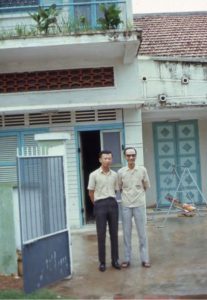
Vương Bách (right) in front of Rand house in My Tho
Hallowed Land, Illustrious People: (Địa linh nhơn kiệt)
Vinh Kim was the most famous village of MyTho province. Its notables adopted one of the familiar tropes of historical geography in the Mekong Delta to the village and its surrounding area, “Hallowed Land, Illustrious People.” Of course this distinction was also claimed by many other villages and even provinces, but it was undeniable that Vinh Kim stood out, both for its prosperity but also its history and people of distinction. Vĩnh Kim was known to locals as Chợ Giữa (the “market in the middle”) for its central location in the core area of the province – known as the 20/7 zone, in honor of the anniversary of Geneva Accords. As can be seen on the province map shown earlier Vĩnh Kim was located in the core agricultural area of the province between the province capital and the district town of Cái Bè. It was the largest market in the province other than My Tho itself.

Vinh Kim market circa 1966
It had been home to a number of distinguished personalities, such as the musicologist Trần Văn Khê and his less illustrious but even better known brother, the Saigon lounge singer Trần Văn Trạch, who I heard several times in Saigon, noted for his crooning style which was often compared to the French “Frank Sinatra,” Tino Rossi. His bohemian appearance would seem to make him an unlikely village icon, but every Vietnamese knew he was from Vinh Kim.

Trần Văn Trạch, Vietnam’s most famous lounge singer in the 1960s, known as the “weirdo star” (Quái Kiệt). A native son of Vinh Kim.
The ups and downs of Vinh Kim throughout most of the 1930-75 period provided knotty challenges for postwar revolutionary historians, as informatively discussed in Philip Taylor’s important book about the Mekong Delta.47 The problem of coming up with an accurate “official” Party-approved history of this period in the postwar era was the difficulty in tracing the evolution from famous nationalist icons of the 1920s and 1930s such as Nguyen An Ninh and Ton Duc Thang through to the postwar communist village leadership. Moreover, the official Party line on early revolutionary history decided that the spotlight should be on the neighboring village of Long Hung, and therefore local attempts to glorify Vinh Kim’s early nationalist movement were discouraged. In addition, a local postwar historian in Vinh Kim asserted that the problem was that “there had been no carry-over of local leadership from the era of the resistance wars into the post-liberation period. He said that after 1975 the village had been loaded with a series of administrators from outside the village.”48
An overview of what happened in Vinh Kim in the mid-1960s and early 1970s explains this disjuncture between the early nationalist movement, the Viet Minh period, and the 1960-75 phase of the war. In late 1965 the Party organization of Vĩnh Kim village fell apart. In November the village guerrilla unit leader defected, followed by the village Party secretary in late December. Beginning with these two insiders, followed by other key village leaders in succeeding months, we began to get a unique picture of an entire village revolutionary organization. This was aided immeasurably by the insights provided by a former Vĩnh Kim village leader who had left the revolutionary movement years earlier.
Under normal circumstances Hồ Nhựt Niên would have been the natural link between the Viet Minh period and the post-1960 period. Known to everyone as Hai Niên, he became a friend, who I remained in contact with until his passing in 2012. Through Hai Niên we began to develop personal connections in Vĩnh Kim, and began to regard it as a kind of pilot study of village dynamics, even though its particular situation was quite unusual, and it could not be considered a “representative” village in Dinh Tuong province.

“Bé Ba” the village guerrilla leader of Vinh Kim who defected in November 1965 and Hai Niên , a former village Party secretary, in front of the district Chieu Hoi center in Vinh Kim.

Hồ Nhựt Niên (right) with militia of the Cầu Ván Sập post in Bàn Long village, adjacent to Vinh Kim.

DE and Hai Nien in July 1973, Saigon, just prior to my return to the U.S.

DE presents Hai Nien with a copy of The Vietnamese War in 2008
Hai Niên was the ideal of what a “man of the people” should be. He was civic minded, altruistic and self effacing, and genuinely wanted to serve his community. These qualities had prompted the Viet Minh to appoint him Vinh Kim village Party Secretary during the Resistance. After 1954, during the “six years of peace” he was promoted to become a member of the district Party Committee. From the village perspective this was a very elevated position.
In 1959, however, the Diem government arrested Hai Niên’s father, and threatened to kill him if the son continued to work for the revolution. From a family perspective Hai Niên simply had no choice. At the time there was no Open Arms program, or euphemisms for changing sides. The Party denounced Hai Niên as a “surrenderer to the enemy” (“đầu thú”) and put him on a death list, to be shot on sight. The esteem in which he was held by the village community and his abstention from politics helped protect him. Sometime in the early 1960s the local village authorities relented and began to consult him on village affairs. By 1965-66, the local Party organization was falling apart and was losing its coercive capacity.
In November 1965 Bé Ba, the village guerrilla unit leader (on the left in the above photo), defected. A month later Ba Nữ, the acting village Party Secretary (leader of the Party organization), followed suit. Some months later, the head of the village Party Propaganda and Indoctrination defected. From the three of them we were able to piece together the story of a local village Party organization in total disarray. This was confirmed by a member of the District Party Committee ( the district was the level between the villages and the province), who had defected in July 1966 and was the highest ranking and most knowledgeable interviewee we had yet encountered. He came from the village neighboring Vinh Kim and was intimately involved with its affairs. Cầu did a remarkable interview with him that was over 200 pages in length, and was confirmation by someone at a level above the villages of the picture we had already put together in broad outline of a serious challenge for the revolution posed by the depopulation of the countryside and the decreasing ability of local cadres to mobilize the remaining population under their control.
The defections of the once feared but respected cadres began to erode the prestige if those who remained. The village cadre who had been in charge of propaganda said “There was a lot of turmoil inside the village Party chapter. First of all, none of the cadres and Party members trusted anyone. All of them feared that the village Party secretary would take GVN soldiers back to arrest and kill them, and everyone was suspected by the others on the grounds that he might be one of the Party secretary’s henchmen. After that they split up and each one tried to secure a new hideout for himself alone. Before, they lived in groups, and had full confidence in one another. Second, the villagers lost confidence in the cadres. They feared that in the next sweep operation the ralliers would single them out to the GVN as VC helpers. As a consequence, they stopped giving assistance to the cadres, arguing that they were no longer certain of the cadres’ loyalty. Some of the villagers even declared, ‘Giving the cadres something to eat is like raising bees in one’s shirtsleeves!’ Whenever we called on them for a meal, they would say, ‘Let us make it clear that giving you something to eat is no different from giving GVN soldiers something to eat. We have to cook for anyone who tells us to. If I have more compassion for you, it is only because you are leading a very hard life. So if any of you rally, please spare me from being arrested by the GVN. In case you lead GVN soldiers back here, don’t single me out as a VC sympathizer.’ [DT143].
The village Party Secretary who replaced Ba Nu was more capable and managed to partially stem the tide, but even he found it tough going. “The new Vinh Kim Party secretary, Hai Hồng, “couldn’t maintain discipline either. He used to criticize us and talked until he was all red in the face, but we didn’t pay any attention. This was why he got the nickname ‘Hai Hồng,’ or ‘Hai who gets red in the face’ ” [DT188]. Hai Hồng had participated in the Destruction of the Oppression in Vinh Kim, and was promoted to the district level in 1963 to become a member of the district Farmers’ Association. Despite the lack of respect from his fellow village cadres, Hai Hồng apparently went over better with the villagers. “His personal conduct is good, his comprehension is fair, and he enjoys much confidence from the villagers,” said the former propaganda chief [DT143]. In the end, Hai Hồng became another casualty of war. “Now that Hai Hồng has been killed,” said a guerrilla, “things are going to pieces in there because he took charge of practically everything while he was alive” [DT188].
The Saigon Government Fails to Exploit Viet Cong Disarray in Vinh Kim
The Viet Cong in Vinh Kim were on the ropes in 1966. The failure of the GVN to exploit this weakness is a good illustration of some of the underlying reasons for their losing the war, despite overwhelming superiority in resources and half a million American troops. GVN had their own resources. In 1966, the GVN had a unique window of opportunity to use this opportunity to “pacify” Vinh Kim. In addition to the vacuum of revolutionary leadership in the village, the arrival of a dynamic GVN official began to give the Saigon government some traction in Vinh Kim.
The appointment of Captain Nguyễn Ngọc Minh as district chief (the formal name of the district in which Vinh Kim village was located was Long Dinh, but it was routinely referred to as Vinh Kim district) marked a significant turning point in the GVN’s relations with the locals. I take the liberty of quoting at length from The Vietnamese War.
“Captain Minh was a dashing and energetic man, with an instinctive popular touch and a flair for dramatic personal and political gestures which had considerable impact on the people in his district. He was not unique among ARVN officers, though this kind of officer was rare. The tragedy of Captain Minh was that he was the exception that proved the rule. His common sense, his accessibility, and his effective but controlled military activities and good tactical sense were the model of what the Saigon government required to prevail in its struggle. His downfall illustrates why the Saigon regime ultimately failed. Not only did it not support its most capable and aggressive officials, it sometimes turned on them either because they were perceived as a threat to the less effective members of the GVN or because of corruption, or both.
“After a few months in the district, Captain Minh had capitalized on the disarray of the local Party organization. He sought out Hai Niên the former Resistance Party secretary of the village, now a community leader, and enlisted his support in winning the people over to the GVN side. Hai Niên was a close cousin of the Party propaganda chief, who began to notice that the Party leaders were growing more distant toward him. Finally, a Party member told him in confidence that his cousin Hai Niên was now working with Captain Minh and was now ‘very powerful in Vinh Kim.’ This news ‘reminded me of the last conversation I had with Hai Niên, who had spoken well of the GVN. He said, ‘The GVN these days is no longer a bad government sponsored by the colonialists. It is really a government which cares about the people’s interests.’ Hai Niên also complained about the way the Party had treated him regardless of what he had done during the Resistance” [DT143].
A third asset for the GVN besides Hai Niên and Captain Minh was Master Sergeant Biện, the commander of the local militia. He seemed to be related to all the important people in the village on all sides of the political divide. “The combination of the populist district chief, the affable but omnipresent Master Sergeant Biện, and the former Resistance village Party secretary posed a formidable challenge to the Party in the struggle for the ‘hearts and minds’ of the villagers. ‘We all knew that Hai Niên was skillful in winning over the villagers’ support. We also realized that he had succeeded in detaching some members of the Farmers’ Association from the Front, and turning a certain number of villagers into GVN supporters. As a consequence of all this, the outlying portion of Vinh Kim village from ông Hổ Creek to the Kinh Xáng Canal has become a dangerous area for the Front to operate in. Before the cadres of the Vinh Kim town Party chapter often came there, but not now.” “Why was Hai Niên so successful with the Vinh Kim villagers?” the interviewer asked. “Hai has always enjoyed the villagers’ confidence since the Resistance,” replied the propaganda chief. “Even during the time he was shunted aside by the Front, he still remained a good man in the villagers’ eyes. He is a rather kind and gentle man, and people love him. The Vinh Kim Party chapter also trusted him, and the village Party members often called on him for a chat while he was living in Vinh Kim and before his cooperation with the GVN” [DT143].
After a few months of this effective political warfare, Captain Minh was suddenly arrested and jailed. The circumstances around his case remain murky, but the essence of the charges were that a unit under Minh’s command operating in a swampy guerrilla base in distant Camau province had killed civilians during an operation in 1960. The legal points at issue were (1) whether these were really civilians, or were revolutionary cadres, and therefore fair game, and (2) whether then-Lieutenant Minh had personally ordered the shooting. He had already been tried once, in 1964, on these charges and acquitted. No one could explain why this case had suddenly been resurrected, or who was behind it—other than a vague impression that it was relatives of the deceased who had reactivated the case.
Why, in a war where such occurrences were commonplace, was Captain Minh singled out for an event that had occurred years before and despite his previous legal exoneration? Many close to the case felt that the Party had arranged for surrogates to revive this case to put this devastatingly effective officer out of commission. Dark hints of corruption and bribery in the Saigon legal system circulated widely as an explanation for why the GVN would arrest and try one of its own best officers, who had, in any case, been legally exonerated once.
Corruption is a probable explanation for a case of singular mystery and complexity and, if true, helps illustrate why the Saigon regime did not prevail in the political struggle. What the Viet Cong could not accomplish with force or political persuasion in terms of neutralizing effective opponents might be achieved with enough money for bribes. Minh was convicted and sentenced to jail, and cashiered from the ARVN, despite forceful intervention by Frank Wisner, part of the Lake-Holbrooke generation of prominent young Foreign Service officers who was then playing a key role in U.S. Embassy.

in white shirts left to right, Richard Holbrooke, Frank Wisner Jr., and journalist Ward Just
Bill Wilcox, was Captain Minh’s well-liked American advisor. He had considerably more political sensitivity than his predecessor, who interpreted the prior district chief’s reckless shelling of neighboring hamlets as a sign of aggressiveness. Wilcox was a U.S. military officer who enjoyed an exceptional rapport with the Vietnamese in his district and had effectively supported Captain Minh. But some months after Minh’s arrest he too left the district. The province advisor’s report for November 1966 noted, “In a remarkable tribute to the American advisory presence, leading citizens of Vinh Kim petitioned President Johnson to extend the tour of Long Dinh subsector advisor Major William R. Wilcox. He has, the petitioners said, “brought many advantages to the people of Long Dinh District from the military, political, economic, and social points of view.” Sentiment, or even a desire to do a more effective job, could not prevail over military bureaucracy, however, and Wilcox too departed.
Without any support from people in positions of authority, the former revolutionaries who had hoped to wage a populist struggle against the Party were relegated to the sidelines. The Saigon administration in Vinh Kim went through a turbulent period in 1966. Following the arrest of Captain Minh, the village chief of Vinh Kim, who had served since 1961, was also arrested, along with the deputy district chief (a civilian administrative functionary who did the paperwork for the military officers who were appointed as district chiefs), and two members of the village council. The charges were embezzlement and bribery. In the villagers’ view, these charges were well founded. A hamlet Farmers’ Association chief said, “They seemed to be very pleased to see them arrested and jailed. They said, ‘They accepted so many bribes in the past, they deserve to be killed!’ ” [DT197].
It was not the corrupt GVN officials who were killed, however, but the non-communists in the village who had denounced them. Phan Kỷ Ngởi was a journalist with strong connections in Saigon who continued to leave in his idyllic home in his orchard on the outskirts of Vinh Kim. He had been vocal in condemning the malfeasance of local GVN. Through Hai Nien’s introduction, I took Don Oberdorfer to interview him.
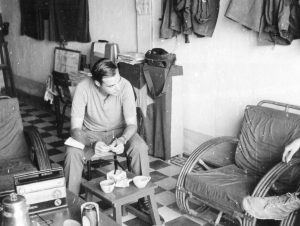

Don Oberdorfer in Vinh Kim sub-sector 1966 with DE
Don, who wrote the definitive book on the Tet Offensive, later became chief diplomatic correspondent for the Washington Post (and wrote a classic account of the end of the Cold War). In 1966 he was reporting for the Knight-Ridder chain of newspapers. Don had the inspiration to try to get an in depth view of the war by spending an extended period in a single village microcosm of the conflict.Don was referred to me, and I recommended that he visit Vinh Kim and interview Hai Nien and his circle of acquaintances as well as the recent defectors, along with Captain Minh to get the Vietnamese side of the story. Although Ngởi was scathingly critical of the GVN regime in Vinh Kim (who shelled his home and orchard) he was very positive about the changes made under Captain Minh. I had assumed that he must have made an accommodation with the local Viet Cong in order to be able to live in what had been an insecure area. The Viet Cong later assassinated Ngởi. George Bonville, who was district advisor in Vinh Kim when this happened sometime after Tet 1969, writes that Ngởi , who he initially regarded as a “fence sitter” came out in public support of an American sponsored bridge project which, in Bonville’s view, made him a “dead man walking.” He was “set upon in his modest home on the outskirts of Vinh Kim by a Viet Cong assassination unit. They stabbed him 20 to 25 times to death and hung a sign on his body claiming that he was a traitor to the people of Vietnam.”49 When Oberdorfer returned to Vinh Kim in 1980 to revisit Vinh Kim under revolutionary rule, he was told that Ngởi had been killed “because he was a spy.”50
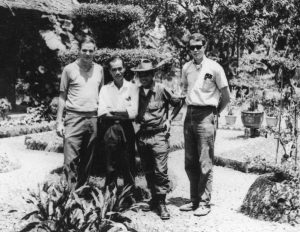
American journalist Don Oberdorfer, Vietnamese journalist Phan Kỷ Ngởi , Master Sergeant Bien and author, in front of Ngởi’s home.
Reporting on the First Phase of the My Tho Rand Project
As the interviews detailing the strains placed on the Viet Cong movement in Dinh Tuong became more detailed and graphic, Leon decided that the time had come to publicize it to a broader audience. He proposed writing up the story of the local cadres and their increasing difficulties. Mai Elliott writes: The first reports to emerge from the Dinh Tuong project were based on data extracted from interviews conducted during the last half of 1965 and early 1966, and on information derived from captured documents and from interviews conducted by Goure’s teams in Saigon. Elliott produced two draft reports. Chuck Thomson was assigned to edit and merge them into one. Goure urged Thomson to steer the report toward an emphasis on enemy vulnerabilities.“In a February 25, 1966, letter to Chuck Thomson, Goure told him to highlight the cadres’ ‘problems, weaknesses, stresses, and strains.’ He wrote to Thomson, ‘What should come out of it is a paper showing that the VC cadres are neither monolithic nor always pure, that they have problems and weaknesses, exploitable ones, and that a careful examination of them shows all cracks and fissures.’ He also urged Thomson to ‘. . . indicate that data from other parts of Vietnam show this situation is not unique to Dinh Tuong.’ Beyond his propensity to emphasize vulnerabilities, it appeared that Goure’s intention was to reinforce his reputation as a key player in exploiting enemy weaknesses through psychological warfare, and he expressed his pleasure over the fact that ‘. . . for whatever it’s worth, we (i.e., RAND) are still the cadres of psywar here and they [Americans in charge of psywar, such as General Fritz Freund] all come for help, advice, or just to cry.’” “However, Elliott, as head of the Dinh Tuong project, which was separate from Goure’s Viet Cong Motivation and Morale Project and which was not under Goure’s purview, controlled the substance of his own findings. He did not go along with Goure’s idea, and his report described a more nuanced picture of the enemy in Dinh Tuong. The Viet Cong had suffered reverses, but they remained resilient, he pointed out, and the cadres continued to keep their commitment and their faith in eventual victory, because they felt their movement had the support of the people. It was a movement that had grown and strengthened itself despite the fact that Dinh Tuong was the seat of the ARVN 7th Division—one of the GVN’s best units.
“The National Liberation Front, as the Viet Cong called their movement, dominated over a fourth of the villages, 24 of the province’s 93, and controlled over 40 percent of the population of half a million, counting those living in their zones and those living in contested areas.” However, the NLF’s military strategy in Dinh Tuong—as in the rest of the Mekong Delta—was not to make the province a center of military operations, but to maintain it mainly as a source for recruits and economic resources. As a result, insurgent military activities in Dinh Tuong, and elsewhere in the Delta, were limited relative to those in the Central Highlands. They were aimed mainly at securing lines of communication to allow access to the rice and manpower of the Delta and to permit arms and ammunition infiltrated by sea to reach the Plain of Reeds. The NLF’s other objectives in the province were to interrupt or block supplies to Saigon and other large cities, tie down ARVN forces, and generally derail GVN economic, political, and social efforts.
“In the 1965–1966 period, the NLF in Dinh Tuong suffered some of the same reverses that were afflicting it elsewhere. GVN military pressures had strained its manpower supplies and economic resources, and had forced it to place increasing demands on the population—a move that intensified popular resentment. Yet, despite these challenges, which were compounded by defections and desertions, Elliott concluded, the Viet Cong cadre ranks, especially those at the upper levels, had been relatively unaffected by the erosion of strength and by the dimmer prospects. They continued to show their resilience and determination to fight for as long as it took, regardless of the costs. Their steadfastness stemmed from their commitment for their cause and from their belief that victory would come eventually, because the NLF enjoyed popular support. Despite difficulties and hardships, they attended to their tasks with efficiency, recruiting and retaining control in the Viet Cong zones, as well as in most contested areas.”51
Visitors
Leon also put the My Tho project on display by persuading visiting dignitaries that a stop in My Tho was essential to get an “on the ground” understanding of the war. As a consequence I was mobilized to meet and brief a succession of visitors from Saigon. I well remember picking up William Jorden, the State Department official who authored the “Aggression from the North” White Paper that laid out the case for U.S. intervention at the My Tho helipad. Jordan looked somewhat self conscious because he must have known that he looked ridiculous in his off-the-shelf military fatigues, with the creases from sitting folded on the quartermaster’s shelf still visible. But someone had told him he had to be prepared to go “out into the field.” At the time I knew of Jorden only as the author of the White Paper, but later learned that he was actually “a leading early skeptic of the likelihood of rapid American military success in Vietnam. He reported back to his bosses about violent protests against Ngo Dinh Diem, the South Vietnamese president aligned with the United States who would be killed during a coup in 1963” David Halberstam wrote that Jorden had “warned against the United States’ becoming too closely identified with a man or a regime.”52
While Jorden was an unassuming person who had come mainly to listen, Joe Alsop swept into My Tho with an article already written in his head, and a non-stop lecture on what was really going on in Vietnam to people he was supposedly interviewing. By early 1966 Alsop had already become something of a caricature of the bloviating pundit, but was fawned over by generals and ambassadors alike in Vietnam as the only prominent opinion leader who expressed unqualified support for the war and LBJ’s policies (Johnson was impressed by this cheerleading but was leery of Alsop for his ties with the Kennedys). When Alsop travelled in Vietnam American officials rolled out the red carpet, fearful of making a bad impression with the great Alsop that might damage their careers. The co-author of Alsop’s memoir notes “Alsop’s privileged VIP status. Although he spent rigorous days in the field. Joe, in his fifties [in the mid-1960s] and fast leaving middle age, was used to coddling and rarely turned down preferential treatment when it was offered. The army placed its vast transport system at Joe’s disposal, whisking him from one destination to the next in specially assigned helicopters. On the ground he was provided with high-ranking uniformed guides and, often enough, a personal trailer in which to rest. Official sources were supplied on command.”53

Leon was equally solicitous of Joe Alsop, and considered it a coup that he had persuaded him to join in a trip to My Tho to follow up on some of the Rand interviews that we had done. No doubt Leon enjoyed being swept along in the whirlwind of an Alsop expedition. Alsop swept into our drab living room and settled down to give his lecture.
As one biographer notes, “Joe had developed a peculiar form of interviewing. He would pull out his notebook, position himself as if he were about to scribble away – and then lecture on the course and conduct of the war. ‘As a reporter, he didn’t ask questions; his mind was made up,’ recalled [Frank] Wisner, who accompanied Joe on numerous sessions with high level officials. Over drinks one afternoon at the home of William Porter, Lodge’s deputy ambassador, Joe nearly lost control. He stood up and stomped his feet. ‘You’ve got it all wrong, Bill,’ he exclaimed. ‘You’re doing it all wrong.’”54
The story he had already written in his head was that the famed 514th Battalion, which the Viet Cong proudly dubbed the “victors of Ap Bac” – where the 261st Battalion, supported by the 514th had shot down American helicopters and disabled the newly introduced M113 Armored Personnel Carriers in January 1963 – was now in shambles, and headed for extinction. Alsop’s point was that if this famous symbol of Viet Cong military prowess was disintegrating, the war must be on the brink of victory. As one biographer wrote, “Throughout his next Vietnam visit in early 1966, Joe saw signs of American success. He reported that the famous 514th Vietcong Battalion, known as the ‘ever victorious,’ was ‘really in dreadful shape,’ beset by defeat, defection and unpopularity in the village.”55
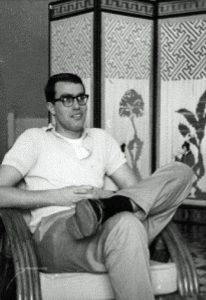
DE receives a visitor in his sparsely furnished living room in My Tho
To get the full flavor of my encounter with Alsop, it is necessary to read the article which resulted from his visit to My Tho.
514th Now
By Joseph Alsop
The Journal Herald (Dayton, Ohio)
19 Feb 1966
MYTHO, DINH TUONG PROVINCE,
South Vietnam – This is the stamping ground of the most famous provincial battalion. Officially, it is the 514th, but the propagandists call it the “Ever Victorious Ap Bac Battalion,” in memory of a major victory over government troops in 1963.
Today, however this once-proud and highly successful outfit is really in dreadful shape. Defectors from the battalion have begun turning up rather regularly at the well-run center for VC ralliers here in My Tho. Fifteen have been received and interrogated to date.
There are three basic reasons for the 514th battalion’s troubles. First, the Vietnamese Seventh division has changed radically since the fight at Ap Bac in 1963. And it has incalculably stronger air and artillery support.
Then, too, the people in the villages have also changed radically since they organized the victory parties for the battalions after the Ap Bac fight. They have been alienated by the VC press-gang conscription methods. And they have ceased to regard the VC as sure prospective winners.
Finally, the battalion itself is less well led. The enormous expansion of the VC main force has been in part accomplished by drawing off the best men in the provincial and local forces. Some time ago the 514th lost its able former commanding officer in this manner.
Defeats, however, are not the grimmest part of the story. The truth is that service in the battalion, once hard but exhilarating, has became hard and bitterly discouraging. The quiet, restoring weeks of rest between the combat in the hidden camps in the Indigo forest are a thing of the past.
Add that most men in the battalion no longer expect victory and it is not surprising that the outfit is at least 20 per cent under strength.
In the circumstances, it may reasonably be asked how the Ever Victorious Battalion survives as a fighting unit. The answer lies in the omnipresent VC espionage, beginning in the member cells of the infantry squads, and also in the stern VC rule that troops must fear their officers more than the enemy. But the pressure is mounting. The time when the battalion will cease to be a fighting unit can already be foreseen, although that time may come both gradually and painfully.
(Copyright, 1966, The Washington Post Co.)
Leon beamed as Alsop regaled us with these points that he had gleaned from the Rand MyTho interviews (minus the point about 514th soldiers being more afraid of their officers than the enemy – which I did not recall as a prominent element of the interviews we had done with former soldiers from the 514th battalion).
To the extent that Alsop was seeking further information or confirmation of any of these points, his interrogation of me (for that is what it was) centered on demands that I furnish him with detailed information about figures on desertion, replacement, and casualties. This is information that is only available to military intelligence organizations with the manpower resources to seek out and compile this technical statistical information. OB specialists spend their full time collecting the data required for this analysis from a wide variety of sources. Since our small Rand group in My Tho could not possibly do this, for the simple reason that the 514th interviews were only a small part of our overall interviews which was predominantly focused on civilian cadres and our mission was to understand what was distinctive about the individual we were interviewing, not duplicate the military intelligence Order of Battle information.
Alsop was used to obtaining information by bullying and implied threats that failure to comply would get back to superiors who would not be pleased if the great man walked away from an interview dissatisfied with the information he was provided. Under normal circumstances I would have been polite and deferential to a visitor who was genuinely trying to understand what we were doing, but the more I proved unable to provide the facts and figures he wanted, the more hectoring Alsop became. I could see Leon begin to squirm, as his plan to show Alsop that Rand knew more than MACV about the war began to falter.
Since Leon had claimed that Rand produced better intelligence than MACV, my failure to produce detailed order of battle information on the 514th battalion, though this was not an objective of our interviews, was proving to be an embarrassment. Finally I began to respond in kind to Alsop’s hectoring, and heatedly told him that we did not have the intention or the resources to provide the kind of military intelligence information he was seeking. Our meeting ended with curt farewells, as Alsop stomped off with Leon in tow. Thus ended one of Joe Alsop’s “rigorous days in the field.”
Over the course of the next week, something must have changed on Alsop’s part. Leon told me to come to Saigon, because Alsop had second thoughts about his interrogation of me in My Tho and wanted to apologize, or since “apologize” was not in Alsop’s repertoire, Leon must have said something along the lines that Alsop wanted to clear up any “misunderstandings” that may have emerged during his visit. I was stunned. Alsop had the reputation for being unconcerned about the feelings of those that he bulldozed in the course of his single-minded quest to get enough fodder to undergird his opinions and preconceptions. To my astonishment, Alsop invited me to his suite of rooms in the Majestic Hotel for tea and received me cordially. I remember walking into his suite, which looked like a bordello, with hanging velour ceiling-to-floor red drapes dividing the inner and outer sanctum. (Ironic, since Alsop says in his autobiography “ ‘drapes’ remains the most grating word in the language to old WASPS like me.”)56 The bordello suite was probably the closest thing the Majestic had to a Presidential Suite, suitable for his eminence. There was no apology per se, but the invitation itself was a gesture of reconciliation – why I can’t imagine, given my insignificance as a lowly Rand employee, unless Alsop had the intention of following the declining fortunes of the 514th in the future, and wanted to keep the lines of communication open.
In fact, Alsop’s prediction that the 514th Battalion would disintegrate came to pass. In preparation for the Tet Offensive of 1968 a clone battalion was formed and designated 514B. In 1969 a 514C unit was formed (it seems that there may have been three 514 battalions in existence at that time. Eventually the the 514B battalion disappeared, and the original 514th may have been reduced to a single company by 1974,57 but with the remarkable regenerative power that seemed to defy explanation, the 514C, the surviving incarnation of the original 514th took part in the final 1975 offensive.58
Later in 1966, Joe’s brother Stewart came to My Tho, and I was asked to escort him and his travelling companion Rowland Evans (who along with Robert Nowak wrote one of the most influential columns in the hard-hitting Drew Pearson style). By late 1966 when he came to My Tho, Stewart Alsop was deeply pessimistic about the prospects for American success in Vietnam. “As Stewart viewed it, Johnson’s policymakers had fooled themselves into sending nearly 400,000 troops to war on the basis of diplomatic assumptions and a military strategy that were wrong. With these dark thoughts, Stewart travelled once again to Vietnam in late 1966. He didn’t find much to cheer him.” Stewart “travelled to the Mekong Delta south of Saigon and perceived that the war would be won or lost there, where half the South Vietnamese population lived. By day, the Vietcong controlled a third of these eight million people, by night two-thirds. Stewart could see that the South Vietnamese army, ‘idiotically trained by the Americans only in conventional warfare,’ was ill-equipped for the guerrilla challenge in the delta. In fact the delta was in danger of falling to the communists. American troops had moved in, but the decision to send them in, born of military necessity could have adverse consequences. Even north of Saigon, wrote Stewart, where the population was relatively sparse, the cumbersome American killing machine had destroyed thousands of what one U.S. colonel called ‘friendly people.’ How many ‘friendly people,’ asked Stewart , would be killed or wounded when the Americans moved into the populous delta? ‘And what will be the consequences, in this most of political of wars?’ To answer this question, Stewart visited two U.S. Army officers working in the delta. One was Major Jack Stapleton, a big, beefy regular soldier from Columbus, Ohio, who was a military advisor near My Tho.”59 In one of the villages of My Tho, Stewart had a jocular exchange with some small children, which left an impression on him. Joe did not seem to register these kind of human contacts, or seek them out.
Stapleton took Stewart to a battalion sweep operation where a group of bedraggled detainees were squatting, waiting to be interrogated. Looking at one 14 year old among this group, Stewart wondered what he might be thinking. “I wish I could have read the expression in the boy’s black eyes. Was it just fear? Or was there hatred also? Might he not join the VC now, after a long day of squatting on his haunches, surrounded by ‘round eyes’ – the big, well-fed, red-faced, queer-smelling foreigners? How do you balance the love of the urchins for their protector, Major Stapleton, against the hatred which at least some of Major Colson’s ‘detainees’ must have surely felt? That is the key question, as American troops prepare to move into the Delta, and the remorseless Americanization of this small war proceeds apace.”60
Clearly Stewart Alsop had a radically different take on this war than his brother Joe. For this reason, my encounter with him seems to have left little impression, in contrast to his trips with Major Stapleton. He and Rowland Evans basically wanted to go to a village that was absolutely secure, probably just to be able to say that they had personally witnessed life in the rural Mekong Delta. So I took them to the village of Long Binh Dien along the road from My Tho to the district town of Cho Gao, one the most tranquil areas of the province. They looked around for a bit, with no apparent agenda in mind, and we left. Unlike Joe, Stewart evidenced little interest in the Rand interviews. I showed a printed transcript of a recent interview to them to make a point. Stewart was clearly not interested. Rowland Evans, with the instincts of a predatory journalist, simply grabbed it out of my hand and put it in his pocket in case it might prove to be of use somehow.
Stewart Alsop’s concerns about U.S. troops coming to the Mekong Delta was prophetic. His concern was not shared in high policy circles in Washington, however. When Mai and I returned to the U.S. in late 1966 and early 1967 to visit my family at their farm in Virginia, my father arranged for a luncheon with his old friend from MIT, Walt Rostow. Rostow was then serving as LBJ’s national security advisor. We sat in the White House dining room, where Rostow presided at ground zero of the Johnson administration. In the Joe Alsop mode, Rostow spent most of the lunch telling me what was going in the Mekong Delta as though he was able to conjure up the situation in every corner of that region with the fluency of a native. He was not especially curious to know about the findings of our Rand project – I’m sure he had read the Dinh Tuong interviews and had incorporated them into his pre-existing view of the war, and thus any input from me would be superfluous. I tried without much success to raise the issue of American troops coming to the Delta, and caution that this might create problems. I had not discussed this with Stewart Alsop or read his reporting on this issue, but my views were much the same. Rostow, patronizingly dismissed this, and assured me that of course all of these issues had been thoroughly examined, and that there would be no problem.
There were, of course, people who were deeply concerned about the human costs of the war, especially in populated areas like the Mekong Delta. One such person was Martha Gellhorn, whose reporting on the wars of the twentieth century has become legendary. I had not heard of her previously when I was told that “the former wife of Ernest Hemingway is coming to My Tho. Could you please take her to see whatever she wants to see.” (I later discovered that the thing Martha Gellhorn detested most was being introduced as “the former wife of Ernest Hemingway”).

When she arrived in My Tho she asked to go the local provincial hospital. She wanted to visit the civilian war wounded and see how they were being cared for. Mai remembers being the interpreter for this visit and I remember that Col. Phước was also there. I had asked him to join us because I felt that his Southern accent would be more familiar and comprehensible to the hospital patients. I distinctly remember that Martha Gellhorn interrupted when Phước was translating a question (she posed the question to me and I passed it on to Phước in Vietnamese with the expectation that he would be able to put it in the local idiom in a way that I could not). “He’s too harsh,” she said. I’m sure she sensed that however gently he posed the question, Phước could not help projecting an air of authority which might make the patients hesitate to respond. I assured her that Phước was not asking questions in an intimidating way. She looked dubious, but we continued with Phước as the questioner. The questions were painful – about the grievous wounds they had suffered, mainly from white phosphorous shelling into their village.
Martha Gellhorn’s later account runs as follows.
“My Tho is a charming town in the Mekong Delta, the green rice bowl of South Vietnam. A wide, brown river flows past it and cools the air. Unlike Saigon, the town is quiet because it is off-limits to troops and not yet flooded with a pitiful horde of refugees. Despite three wars, one after the other, the Delta peasants have stayed in their hamlets and provided food for the nation. Governments and armies come and go, but for 2,000 years peasants of this race [Vietnamese did not arrive in the Mekong Delta until the 16th century], have been working this land. The land and their families are what they love. Bombs and machine-gun bullets are changing the ancient pattern. The Delta is considered a Vietcong stronghold, so death rains from the sky, fast and indiscriminate. Fifteen million South Vietnamese live on the ground; no one ever suggested that there were more than 279,000 Vietcong and North Vietnamese in all of South Vietnam.
“During a short, appalled visit to the big My Tho provincial hospital, among hundreds of wounded peasants, men and women, I noted a 13 year-old girl who had lost her left foot (bomb), sharing a bed with an old woman whose knee was shattered; a 14 year-old girl with a head wound (mortar shell); a 15 year-old girl with bandages over a chest wound (machine-gun bullet). If you stop to ask questions, you discover frequently that someone nearby and loved was killed at the same time, and her is the survivor, mourning a mother or a little brother; loneliness added to pain. All these people suffer in silence. When the hurt is unbearable, they groan very softly, as if ashamed to disturb others. But their eyes talk for them. I take the anguish, grief, bewilderment in their eyes, rightly as an accusation.”61
After the hospital visit, Martha Gellhorn asked to visit the province Chieu Hoi Center. We did, and brought home a recent rallier for her to interview. She wrote the following account of this part of her trip to My Tho:
“The ‘Open Arms’ camp at My Tho, a provincial capital in the southern Delta, was smaller and happier than the Saigon camp. The ralliers have a vegetable garden and a fish point and chickens, and some of their families have joined them. Life is bearable for Vietnamese peasants only if children are waddling and gamboling around. …”
[We met a young woman rallier and took her back to our house for an interview]
“In My Tho, a beautiful young Vietnamese woman, educated in Washington DC, and married to an American, acted generously as my interpreter and hostess. All day long, she and I and a Vietcong peasant woman, Miss Phuong, who had defected three days ago, sat in Mai’s front room, drank tea, soda water, orange squash, and heard Miss Phuong’s life story. When the helicopters rattled and banged deafeningly overhead, we waited in patient silence, everyone learns to do that.
“Miss Phuong was corpulent, muscular, but well padded; the only peasant of that shape I saw in Vietnam. She was a spinster, probably aged 35, though she looked older: at 35 peasant women are apt to have seven children. Her voice was like the silver cooing of a dove, her laugh a tinkle. Her profile was attractive but her full face was not; her eyes were bloodshot, wary and cold. Only surprising that she did not look half-mad.”
[There follows an account of Miss Phuong’s life story. In the Resistance she served along with her fiancé who regrouped to North Vietnam in 1954, and was never heard from again, She became a successful village midwife who owned a little hamlet clinic and was forced to move to a fortified settlement, but was unable to reestablish her clinic. Later she left the Agroville to resume work as a medic in a Viet Cong controlled hamlet. Early in 1966 this hamlet was bombed and destroyed. Even after that it was continuously bombed].
“How do people feel about the Government, I asked. Her dove voice changed, it suddenly became emphatic and louder. Mai translated: ‘She says they hate both sides. They don’t care which side wins. They only want peace so they can work in safety.’ In Miss Phuong’s position ‘they’ was a wiser word than ‘we.’
“Too casually, I asked whether she was not afraid the Vietcong would punish her family for her defection. For answer, she wept. Tears for her own family, hatred of both sides, terror of our weapons, a longing for peace were Miss Phuong’s real emotions; conceivably they are the real emotions of most Vietnamese peasants. In time it should be possible to drive all peasants from the land and thus starve out the dedicated hardcore Vietcong. It would also starve out the nation. From the air, abandoned rice paddies look like scraps of sand.”
“But things like that; you know must be
At every famous victory.”62 [The Battle of Blenheim by Robert Southey]
It is a reproach to most of us who spent years in Vietnam, immersed in the war, that we had so little contact with the civilian victims of the conflict. This was the only time I visited the burn ward of the My Tho hospital during the six years that I lived there, and would probably never have seen it, had it not been for Gelhorn’s visit. I’m sure that Leon never set foot inside such a place.
Gloria Emerson, who covered the war for the New York Times, wrote about the young foreign service officers like Tony Lake, Dick Holbrooke, John Negroponte, and Frank Wisner who “lived in a famous villa at 47 Phan Thanh Gian, which was leased by the embassy and inhabited since the American ascendency in 1965 by a succession of young men out of Harvard, Yale, and Princeton, who worked for CORDS [the umbrella designation for the entity which coordinated civilian government programs related to pacification]. It was one way of avoiding the draft if they passed the civil service examination, for the State Department offered them an occupational deferment. They spoke Vietnamese, they wrote miles of reports, they entertained each other, they moved around the war, rarely through it, like greyhounds circling a garbage dump.”63 This is certainly unfair to most of those she referred to, who were deeply affected by the war, but it has an element of truth. Not many who spent long periods in Vietnam went out of their way to immerse themselves in the dark corners of the war unless they had to – myself included.
Even so, the war left a deep imprint on the “best and brightest” of my generation. I mentioned my brief encounters with Tony Lake and Richard Holbrooke in the previous chapter. There were others from this cohort worthy of mention who I crossed paths with during their visits to Dinh Tuong. Not long after I arrived in My Tho, I was surprised to encounter a Vietnamese-speaking American civilian, about my own age in the headquarters of the Dinh Tuong province military sector. I must admit feeling somewhat irritated that my monopoly on being the only American civilian fluent Vietnamese speaker in My Tho was under challenge. Initially I did not know who this was, why he was there, or how long he planned to stay. I soon discovered that it was Frank Wisner, a rising star of the State Department who had dropped by for a brief visit. I didn’t know at the time that he was the son of Frank Wisner Sr., who had been instrumental in setting up Cold War covert operations for the CIA. My father had worked with Wisner Sr. in the early 1950s, which I did not discover until doing research in the Hoover Archives a half century later. I also didn’t know that Wisner Sr. had committed suicide just about the time I met Frank Wisner Jr.
I quickly discovered that Wisner was extremely knowledgeable about the situation in the Mekong Delta, and the following year I was able to enlist his support in trying to exonerate the dynamic and effective District Chief of Vinh Kim, Captain Minh, who had been framed by the Viet Cong, who utilized corrupt Saigon officials to throw Minh in jail on fabricated evidence. I was impressed by Wisner’s willingness to take on this case, given the hassles involved and the lack of a “big picture” dimension to the case. Frank was perceptive enough to realize that this case of corruption undermining the war effort was, in fact, of considerable importance since, if left unchecked, this would give the Viet Cong a way to neutralize the most effective officers serving the Saigon government. Despite Frank’s energetic intervention, Captain Minh was sent to prison, and cashiered from the Army. Frank went on to become a prominent senior official in the State Department.

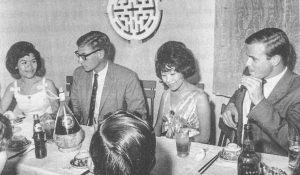
Frank Wisner Jr. as senior State Department Official and (on right) in Vietnam photo: Vladimer Lehovich
Another of the cohort of rising young stars was was my college classmate Les Aspin (Yale ’60) – who I did not know as an undergraduate – in fact I don’t think I was aware of the connection when he passed through in 1966 when he was working in some vaguely defined capacity for McNamara’s Defense Department. The purpose of his visit was to observe the revolutionary development (RD) cadre in action in the main 1966 pacification priority for Dinh Tuong province, the village of Thạnh Phú. This subsequently morphed into preparation for building a massive base to house the U.S. Ninth Division in the neighboring village of Binh Duc when it began to move into Dinh Tuong in force. During Aspin’s visit, this future was not yet in sight (though he might have been privy to it in the Pentagon) and the focus was on the GVN pacification program.

Les Aspin, future Secretary of Defense, visiting Thạnh Phú village pacification priority site, 1966.
DE in rear upper right (with head cut off in this video freeze frame) white shirt with glasses case in pocket, arms akimbo.
The visit of Les Aspin was one of his many forays out of Saigon to try to understand what was going on in the war. During the mid-1990s, noted New York Times columnist R.W. Apple wrote the following about Aspin and his cohort, who had been affected by what they saw in Vietnam. “At one time or another during the mid-1960’s, most of the best young talent in the State Department and the Pentagon found its way to Saigon and the provincial capitals of South Vietnam. Many of the names are household words today, at least in households inside the Beltway: Anthony Lake, now President Clinton’s national security adviser; Richard C. Holbrooke, who has been struggling to bring peace to Bosnia; Peter Tarnoff, the No. 3 man at State; Frank Wisner, Ambassador to India; John Negroponte [another member of the class of Yale ‘60], Ambassador to the Philippines, and Les Aspin, who became the Clinton Administration’s first Secretary of Defense.” 64
Apple recalled that “I saw a fair amount of him in Vietnam. One of Robert S. McNamara’s Whiz Kids, he shuttled between the Pentagon and Saigon on no evident schedule. He never did break the local code, any more than anyone else did, but he was always great company, a beaming, convivial figure at our parties and at the restaurants where we hung out, like Aterbea and the Guillaume Tell (where they drilled minute holes in the bottoms of fancy bottles of wine, drained off the expensive stuff and substituted some cheaper concoction).” While Aspin may not have “broken the local code” in his apparently random excursions throughout Vietnam, Apple notes that “He was an out-and-out dove when he was elected in 1970 … But his 22 years on Capitol Hill gradually made him more conservative, and he broke with his party’s leadership in the …”65 In February 1994, Aspin was forced to resign as Clinton’s Secretary of Defense. “As Secretary of Defense, he faced complex social issues, such as the roles of homosexuals in uniform, and of women in combat. … The deaths of U.S. soldiers in Somalia because of inadequate military support led to his resignation.”66 He died the following year.
With Aspin on that 1966 trip to the pacification site in Thạnh Phú village was Bob Sansom.

Bob Sansom in Thạnh Phú village 1966.
Sansom was an Air Force Academy graduate who had won a Rhodes Scholarship to Oxford and was in the process of finding a research site for what became one of the outstanding pieces of research done during the Vietnam War. The result was his classic book, The Economics of Insurgency in Vietnam. This was a fortuitous visit from my point of view, because Sansom became interested in Dinh Tuong largely on the basis of reading our Rand interviews, and decided to make it the primary site of his field research.
Mai’s book Rand in Southeast Asia records Sansom’s impressions of the Dinh Tuong interviews. “Sansom had become familiar with the RAND interviews conducted by David Elliott and his team in Dinh Tuong when he was performing his doctoral research. To him, those interviews were ‘the gold standard.’ He remembered that reading the interviews, ‘You had the feeling that you can get the fine grain of what was going on. You get these people to describe their lives. It wasn’t just the military component, it was the economic component, the social component.’ To him, the interviews provided ‘an introduction to the reality of it, what’s on the ground,’ and he remembered ‘how utterly mesmerized’ he was ‘by the facts and the details and the lives of the Viet Cong.’”67 Later, Bob was instrumental in paving the way for the second phase of my research on war in Dinh Tuong in 1971 as the member of Kissinger’s National Security Council Staff responsible for keeping tabs on Vietnam. Without his support, I would not have been able to complete the research, without which I could not have written my book, The Vietnamese War.
R.B. Smith’s perceptive review of Sansom’s book shows how his field research and analysis led to conclusions that challenged many of the dominant paradigms used to explain the dynamics of the Vietnam War. His work, which I discussed with him while he was doing his field research in Dinh Tuong, certainly broadened my horizons and had an important impact on the second phase of the My Tho study. Smith writes that in the Economics of Insurgency: “The ultimate aim seems to be to convince American officialdom of the serious limitations of views about insurgency held by such writers as Douglas Pike and Charles Wolf, Jr. Where the latter have placed great emphasis on organization as the main factor in Communist success in South Viet-Nam after 1960, Dr Sansom prefers the old view that insurgencies in agrarian societies are possible only when there are genuine grievances to be exploited, and insurgents who genuinely (in appearance at least) want to do something about them. He suggests that Mr Pike’s views derive from too much concentration on the evidence obtained from Communist cadres, themselves inevitably pre- occupied with organization as the main factor in Communist success in South Viet-Nam after 1960. … He has some particularly biting comments on a paper by E. J. Mitchell, which sought to prove that land was an unimportant factor in insurgency, on the basis of a purely theoretical analysis of variables and no first-hand experience of Viet-Nam at all. His general arguments probably reflect the feelings of many Americans who have had such first-hand experience in the Vietnamese countryside over a long period, but who have found it impossible to put across their views to officials at higher levels of the administration.”68 Ironically, by the time we returned to Dinh Tuong in 1971 the GVN had belatedly implemented a land reform program but, as I will discuss in a subsequent chapter, widespread rural depopulation had rendered the issue of land tenure irrelevant until peace would allow return to the land of the vast displaced refugee population.
Henry Kissinger was another visitor to My Tho, on a fact finding trip for the Johnson Administration. His brief stopover seems to have little impression on him, and it is hard to pin down the exact date of his visit. His second trip to Vietnam (the first was in 1965) brought him to Saigon on July 16, 1966. Like Stewart Alsop, Kissinger was already pessimistic about the progress of the war. His official biographer Niall Ferguson remarks that on this trip Kissinger felt that “it was impossible to see the situation as anything other than worse than it had been a year before,” on his first trip to Vietnam.69 Ferguson observes, on his trips to Vietnam Kissinger’s “preferred method was to ask disquieting questions.”70
To my regret, over a half century after a brief meeting with Kissinger (whom I had known casually as a student of my father’s at Harvard) I can’t remember any particularly penetrating or memorable questions that he posed to a small group of Americans, including the Province Senior Advisor, the USAID and Juspao representatives and a few others, including myself. All I can recall from this brief meeting was that Lt. Col. Brown, the Senior Advisor, became impatient when I went on a bit too long about the case of Capt. Minh, the Vinh Kim district chief who had been recently tried and convicted, citing this as an example of self-destructive behavior that negated the few real assets that the GVN had in confronting its enemy. Brown’s point was that I was beating a dead horse, that the damage had been done and that we had to move on to other things. Kissinger, who largely listened without comment to what the local Americans had to say, did not comment or react to this or any other points raised in this brief colloquy. I’m sure he felt that my impassioned focus on the tragedy of Capt. Minh was a good example of “localitis” and not seeing the big picture. For me, the case of Capt. Minh was a perfect illustration of the “big picture” – that the Saigon government was its own worst enemy (as Kissinger, not a partisan of the Saigon government in the first place, came to appreciate when he took office).
In White House Years, Kissinger wrote: “In the absence of criteria of success, self-delusion took the place of analysis. When I visited the province of Vinh Long in October 1965, I asked the province chief what percentage of his province was pacificied; he proudly told me 80 percent. When I visited Vietnam for the second time in July 1966, I made a point of visiting the same provinces in order to assess the changes. In Vinh Long the same province chief told me that enormous progress had been made since my earlier visit. When I asked him how much of the province was now pacified, he proudly told me 70 percent!”71 Dinh Tuong province was just north of Vinh Long and the situation was comparable. On a third visit that October, he learned from talking to peasants in one South Vietnamese village that eighty percent paid taxes to the Viet Cong. How, Kissinger later asked a U.S. adviser, could he thus claim the village was largely pacified? ‘The VC wouldn’t dare enter this village,’ replied the adviser. ‘The people pay their taxes by mail.’ Kissinger’s skepticism was thus reinforced, though perhaps not enough.”72
The Other War
Since the U.S. had entered the war in 1965 without a plan for victory, but only a desperate effort to stave off a humiliating loss, the only thing that could pass for a “strategy,” by default, was Westmoreland’s concept of attrition – military pressure which would kill off more enemy than could be replaced, until the Viet Cong ran out of manpower to continue the war. This was expressed in somewhat less abstract terms by General DePuy’s “stomp ’em” approach. By 1966 it was evident that this one dimensional emphasis on grinding the enemy down was not achieving the desired results – or, at least, not fast enough for the American public which was become increasingly impatient with what it perceived as a lack of progress toward winning the war.
So, in 1966 there was increasing talk of “the other war” – a supplement to the military meatgrinder that would provide the missing ingredient that could lead to victory. This was reflected in a new emphasis on “pacification” or replacing Viet Cong control in villages with Saigon dominance. The first step was to clear the concentrated Viet Cong military forces out of an area, and fill the resulting vacuum with lightly armed paramilitary Saigon government forces who would “root out” the GVN-designated officials to administer the newly “pacified” village.
There was a vague recognition on the American side that there needed to be some kind of political message to consolidate Saigon dominance – one that would win over the rural population to the Saigon side. Some felt that simply providing more prosperity through aid would suffice. Others believed that a genuine land reform which would offer substantial material incentives to support the GVN would be necessary.
There was a hybrid combination and extension of these views that was formulated by the former war critic John Paul Vann. He called it “harnessing the revolution.” In essence, this meant stealing the programs and techniques that seemed to work for the Viet Cong and inducing or compelling the Saigon government to adopt them. It is clear that the conceptual foundation of this view is the “organization theory” idea, which attributed the Viet Cong success to the sophistication of their organizational techniques. One concrete program which emanated from this line of thought was the Revolutionary Development Cadre program. The original ideas which fused into the RD Cadre program were, 1: a fairly conventional rural development program, staffed by rural economic development specialists [cán bộ xây dựng nông thôn], and 2: a small, armed, paramilitary team called the Political Action Team, which would function as the early Viet Cong guerrillas did as they were wresting control from the Saigon local officials in the villages. The resulting hybrid was a confused mix of both ideas. The small PAT teams were expanded to unwieldy units of 57 cadres. The Vietnamese government never bothered to find a translation for the American term “revolutionary development” and continued to use the more technocratic Vietnamese term “rural development.” The rural development idea was retained in vestigial form, but the teams were now called “Revolutionary Development” or “RD” cadres rather than mundane “rural development” technicians.

Visiting a Revolutionary Development cadre group doing pacification in Tam Hiep village.
Nguyễn Hữu Phước is on the far left and Đinh Xuân Cầu is on the far right
Some of the original proponents of the “harnessing the revolution” idea became instrumental in establishing a CIA-run training center for Revolutionary Development cadres in Vung Tau, a former seaside resort town several hours from Saigon. The background of this development is well described in Neal Sheehan’s biography of John Paul Vann. Several of the protagonists of this story have become legendary among a small circle of cognoscenti of the arcana of the Vietnam War, most notably Everett Bumgarter and Frank Scotton, who nominally worked under Bumgardner. Both were employees of the United States Information Service, with very expansive views of “information.” Bumgardner had particularly extensive experience in Vietnam, dating back to the 1950s, and Scotton had pioneered the Political Action Team concept in 1964. My first meeting with Scotton was sometime in early 1966 , possibly on the way to visit the priority pacification village of Thanh Phu. I recall Scotton packing an automatic weapon, which I thought unusual for someone dressed as a civilian, even in Vietnam. (Note Doug Ramsey in the photo below, also with an automatic weapon). After leaving the army, I never touched a weapon in Vietnam. It is noteworthy that Andre Sauvageot, while still a serving officer engaged in combat situation resolved never to fire his weapon. He thus opted out of the killing dimension of the Vietnam War.73
It was inevitable that they should come into contact with John Paul Vann, and Vann’s assistant in Hau Nghia province, Douglas Ramsey. “Whenever Vann and Ramsey went into Saigon on business together and stayed overnight, they would get together with Bumgardner and Scotton to talk about the war. While Bumgardner and Scotton reflected the same inability as the rest of their countrymen to grasp the nationalist basis of Vietnamese Communism, they were knowledgeable about current social and political conditions in South Vietnam. Both men were fluent in Vietnamese, and Bumgardner had married into a Chinese family that had lived in Vietnam for generations. They were convinced, like Ramsey, that the Viet Cong drew their greatest strength from the conditions that nurtured social revolution. They thought that anti-Communist nationalism was still a viable alternative in the South, but only if there was a complete transformation of the Saigon regime. The United States could not simply take over the regime as Vann’s reflex had told him and run the country through Vietnamese front men. The regime had to be somehow changed into an entirely different kind of government that was responsive to the desires of the rural population. Unless a change was made, Bumgardner and Scotton believed, the war could not be won. Even if the U.S. Army were to occupy the whole country and crush the guerrillas, the rebellion would break out again after the American soldiers had gone home. What Ramsey, Bumgardner, and Scotton said sounded right to Vann because of what he saw in Hau Nghia.”74
Vann thought that “‘with the blood of American soldiers about to be shed in large quantities, their leaders in Saigon and Washington might feel compelled to face up at last to the failings of the Saigon regime and to the U.S. “mistakes of the past twenty years, ” as he said in his proposal for a new strategy. He entitled the ten-page proposal “Harnessing the Revolution in South Vietnam.” The idea was to gain the sympathy of the peasants by capturing the social revolution from the Communists and harnessing it to the American cause. The short-range goal was to utilize this peasant support to destroy the Viet Cong. The long-range goal was to foster the creation of a different kind of government in Saigon, “a national government … responsive to the dynamics of the social revolution, ” a South Vietnamese government that could endure after the American soldiers had fought and the living had gone home. U.S. policy in South Vietnam had been blind and destructive.”75
“Vann and his friends thought there was still time for the United States to steal the social revolution from the Communists because they had been struck by how shallow Viet Cong domination was in many parts of the countryside. This “thinness of control, ” as Vann referred to it, was the major reason he and Ramsey were able to move around Hau Nghia with such relative freedom. Bumgardner and Scotton had often been surprised by the same thing elsewhere. The guerrillas had progressed so rapidly since 1963 that in large areas they had not yet had an opportunity to train enough village and hamlet administrators and to indoctrinate the population sufficiently to solidify their rule. Vann and Ramsey noticed the difference when they went into the old rubber-plantation sections of Cu Chi District, where there had been Communist organizing among the plantation workers before World War II and the Viet Minh had found a ready base against the French. No children laughed and shouted for gum and candy in these hamlets. Everyone, adult and child, had a cold look. Vann and Ramsey never dared to stay more than a few minutes. These peasants were as sensitive to Americans being their enemies as they had been to the French. As Ramsey was to put it, the pattern of struggle under Party leadership had gone on ‘long enough for what was in the mold to set.’ In much of the rest of Hau Nghia, the population did not seem so strongly bonded to the Viet Cong that they could not be weaned away with the right program of opportunity and material incentives.”76
Thus it did not seem far-fetched to these American insiders that turning the Viet Cong’s techniques against them could turn the tide of the war. In due course this approach took the form of the Revolutionary Development Cadre Training Center at Vung Tau. One of the prominent American instructors at the newly-established center was Andre [Jean] Sauvageot, the former district advisor from 1964 whom I first encountered in 1964 walking down a road in black pajamas and U.S. combat boots (see previous chapter), and who had become fluent in Vietnamese.



Andre Sauvageot in Hanoi (circa 2009) Ev Bumgardner Doug Ramsey center, Frank Scotton right back turned
“[T]he first combined cadre training course, for some 4,650 students, commenced at Vung Tau on 21 February 1966. The new format… included the ten week’s Pat program of weapons and tactics, political and social work, and intelligence… To the basic course, the new syllabus added three weeks of instruction in things like hamlet administration, Census-Grievance, and village self defense and warning systems. In April, Robert Komer made his first visit to Saigon after being named White House advisor on Vietnam affairs. …[Deputy U.S. Ambassador] Porter wanted to double Revolutionary Development [RD] training capacity from an annual rate of 19,000 cadres to 39,000 by the end of the year, and Komer pursued this goal upon his return to Washington. The first Revolutionary Development (or Rural Construction) Cadre teams graduated from the Vung Tau school, now the GVN’s National Training Center – on 21 May 1966.”77
Sometime in April 1966 I arranged to pay a visit to the newly-established Revolutionary Development Center in Vung Tau, a former resort town northeast of Saigon. It was probably on this trip that I met General Richard Stilwell in passing at the airport (see above). On the flight to Vung Tau I met Ev Bumgardner for the first time. Because the passengers were all headed to observe the newest development in U.S. pacification programs, the talk turned to successes and failures of past ideas. Bumgardner, who was the only “institutional memory” that the United States Mission had, dating back to his service in the late 1950s, responded with a steady stream of unrelievedly negative judgments. “Tried that in ’61: failed.” “Did that in ’63: a bust.” Thus it was with somewhat chastened spirits that the visiting group arrived at the training center.
But there the mood changed. The central focus of the visiting group was McNamara’s Deputy Secretary of Defense, the soft-spoken and reserved lawyer Cyrus Vance, later Carter’s Secretary of State. I was incorporated into the Vance entourage by default as a back bencher, and sat behind him in the briefing room as the ebullient founding director of the center pulled out all the stops to impress Vance. To understand what we were observing it is necessary to sketch out the political controversy that surrounded the post of director of the center.
It was clear that this was a CIA and, therefore, American program. This probably discouraged some Vietnamese from assuming the post of director. The first director of instruction, however, was not deterred, and thought that he would easily circumvent the Americans and pursue his own version of “harnessing the revolution.” This version was colored by the fact that the first person in charge of training was a secret stalwart of the Đại Việt Party, a conspiratorial nationalist anti-communist organization, which had developed the idea of copying Communist techniques and turning them against them well before John Paul Vann appeared on the scene. (I have already mentioned Dinh Xuan Cau’s affiliation with the Đại Việt). It appears that the CIA had been aware of Lê Xuân Mai’s Đại Việt affiliation as early as 1964, but initially thought that this might be an asset – until Mai’s political ties created a problem with the GVN leadership.78 John Paul Vann, however, felt that the “Dai Viet loyalties of Le Xuan Mai, chief of instruction at Vung Tau had been unknown to the [CIA] Station until recent discord at the camp exposed the partisan slant of political indoctrination there.” In addition, Vann felt that the too-obvious CIA control of the program was a concern to Col. Tran Ngoc Chau and General Nguyen Duc Thang who were later nominally in charge of the overall program.79
I recall Major Lê Xuân Mai’s flamboyant exposition of how the Cadre Center was re-indoctrinating its trainees with nationalist ideology to prepare them to do ideological combat with the Viet Cong. He proudly showed off a “Fatherland Alter” prominently displayed on a table behind him. This was, I realized typical hocus-pocus – what CIA historian Thomas Ahern terms Mai’s “attachment to mystical concepts like ‘fairy and dragons totemism’”80 – to disguise the fact that they did not have a clearly defined ideological program, and thus had to resort to empty symbolism (which was a fabrication with no roots in Vietnamese history). Vance smiled benevolently, and accepted this sham without comment. Whether he thought it was genuine, or simply did not care enough to pursue the issue I could not tell. This tableau of a staged farce designed to reassure top American officials came to symbolize for me the enormous gap between high policy as perceived and formulated in Washington and reality on the ground in Vietnam.
Andre Sauvageot’s 2009 interview with an American academic has provided an interesting account of his role in the transition of power from Major Lê Xuân Mai, to Trần Ngọc Châu, a former province chief of Ben Tre with his own version “harnessing the revolution” which relied less on mystical hocus pocus and more on stealing “hearts and minds” from the Viet Cong, to Major Nguyễn Bé, who was considered by the Americans to have overly sensitive reactions to running an American-inspired and managed program, but turned out to have more staying power than his predecessors.
As told by Sauvageot to Jeff Woods, of Arkansas State University, the story is as follows: “Because of his unique rapport with the Vietnamese, in the late spring of 1966, the CIA recruited Sauvageot to handle an increasingly prickly situation at the RD Cadre training center at Vung Tau. Sauvageot arrived at Vung Tau to find the school in crisis. The commandant of the training center at the time was ARVN Major Le Xuan Mai. Mai was experienced and competent but also a clandestine organizer for the Dai Viet political party and on the CIA payroll. Both affiliations bothered his boss, Cadre Division chief and veteran other [e.g. unconventional] warrior, Tran Ngoc Chau. The fiercely independent Chau had chafed at his job from start. He no longer had the independence he had at Kien Hoa and had no confidence that his boss, Minister [Nguyen Duc] Thang, understood pacification. He was also concerned that Thang and Vung Tau had become too dependent on the CIA and Mai was using the school to recruit cadre to join the Dai Viet. With the support of John Vann and many of the other warriors, Chau pressed the ministry for new leadership. Chau persuaded Thang to appoint Lieutenant Colonel Le Van Tinh commandant, but both the CIA and Mai supporters at the training center refused to submit to his authority. At that point Chau convinced Thang to name him commandant.”81
I can no longer remember with certainty whether Sauvageot had arrived at Vung Tau by the time of the Vance visit, though I have the impression that he was there at the time, that is, while Major Lê Xuân Mai was still director. “Sauvageot remembered the day Chau came in to take over at Vung Tau as ‘very dicey.’” This must have been after the Vance visit, though I did not know any of this insider maneuvering and leadership turmoil at the Center at the time. Nor, probably, did Vance, who smiled beatifically and did not make any substantive remarks. In fact Vance’s trip took place at a time of great political uncertainty in Vietnam. The pro-Buddhist revolt of General Thi in central Vietnam had caused LBJ’s newly appointed “pacification czar” Robert Komer and press secretary Bill Moyers to delay their departure for Vietnam, where they had originally intended to go with Vance who departed on schedule at the end of March 1966. Had they not been delayed, Moyers and Komer would no doubt have joined Vance in going to the Vung Tau RD cadre training center. In these uncertain conditions, Vance’s reticence was understandable.82
Presumably the first chapter of the Vung Tau succession crisis followed Vance’s departure. “Chau was supposed to arrive at the Lam Son camp, the largest of the three that made up the Vung Tau complex, where he was to address the instructors. The auditorium was full, with Sauvageot, the only American present, seated in the front row. The new commandant’s address was scheduled to begin at 9:00 a.m., but the hour came and went with no sign of Chau. Although Sauvageot did not know it, Nung guards posted at the school gates, loyal to Mai and the CIA, were preventing him from entering. Suddenly, inside the auditorium, a group of cadre, stormed the stage, and announced the appointment of a struggle committee to oppose the takeover by the Ministry of Rural Development and Chau. To boisterous applause, they announced their plan. They would make an appeal to the American embassy to keep things as they were at the same time they sent a formal protest to Thang; if these initiatives failed, they promised, armed struggle would follow. After several tension-filled minutes, Mai came in, and the room fell silent. The coup leaders asked the lone American, Sauvageot, to make some remarks. Reluctantly, Sauvageot took the microphone. “This is a family matter,” he declared. “I am an American adviser working for the U.S. government. The reason for my presence, for the presence of the U.S. government, is to enable the people of Vietnam to be free from a communist takeover. That’s it. We cannot by law or policy get involved in internal conflicts.”
“‘We are friends to all of you. Our enemy is the communist monolith in Hanoi, Moscow, and Beijing.’ Sauvageot’s remarks evoked neither protest nor applause, just the response he had hoped for. Over the following days, Sauvageot helped negotiate a peaceful transition of power. Mai was persuaded to leave, and Chau assumed command. All of the signs in the complex were subsequently changed from English to Vietnamese, and the new commandant replaced the CIA’s Nung guards with ethnic Vietnamese.”83 Ahern describes a “mutiny” by 100 of the 600 instructors and claimed that it was a CIA official who negotiated a resolution.84
Alternate Versions of “The Other War”
While John Paul Vann schemed to “harness the revolution” by stealing the ideas and techniques of the Viet Cong, and the U.S. Mission hoped that simply relabeling the prosaic “rural development” program as the “revolutionary development” program would accomplish the same end by a mere adjustment of terminology, other experts brought in to devise counterinsurgency strategy tried to apply models which had been devised in other countries and were deemed successful. A favorite source of inspiration in some U.S. circles was the British experience in Malaya, despite the fact that the circumstances there had been very different from Vietnam.
Rand had been intrigued by the idea of transferring the lessons of Malaya to Vietnam. As early as 1962 Rand was examining the ideas of Sir Robert Thompson, the reputed architect of the Malayan counterinsurgency strategy. Mai’s history of Rand in Southeast Asia notes that “Thompson was a veteran of the British fight against insurgents in Malaya, where a similar approach based on the strategic hamlet concept had brought success, albeit in a radically different situation. In Malaya, the insurgents had been ethnic Chinese who had no support among the native Malays, and who could easily be identified and isolated from the rest of the population… Thompson’s credentials endowed him with an aura that impressed people who were searching for a solution to an intractable problem.”85 His ideas were circulated and discussed within Rand.86 He continued to promote his ideas under Rand’s auspices through the Nixon presidency. Rand subsequently hired Thompson and some of his associates as consultants, and funded many of Thompson’s trips to Vietnam. Even as late as 1972, Robert Komer, once Johnson’s right-hand man on pacification wrote a Rand Memorandum titled “The Malayan Emergency in Retrospect: Organization of a Successful Counterinsurgency Effort.”87
I never met Thompson, but did have an extended conversation at the Rand villa with his close associates from his Malaya days, Desmond Palmer and Jack Barlow, sometime in 1966-67. Both were part-time Rand consultants though this was apparently simply an enabling device to support their investigations in Vietnam, and never resulted in any Rand memoranda or publications. They also seemed to have official ties with the U.S. government (Barlow had an office in the US. Embassy Annex in Saigon).88

Jack Barlow. http://www.commandoveterans.org/Barlow2Commando
Palmer, who was Robert Thompson’s assistant as deputy Chief of the British Advisory Mission in Viet Nam, and who had been Deputy Director of the Special Branch Police Force in the Federation of Malaya was promoting the idea of resource control, which had been an essential element of the Malayan strategic hamlet program (keeping supplies from British controlled areas from reaching the insurgents in the jungles). Barlow was pushing the idea that the solution to insurgency was not more soldiers but better intelligence and more cops on the beat in the villages. One practical result of Barlow’s proposals was the establishment of coordinated province and district intelligence centers whose purpose was to identify the “faceless Viet Cong” as targets for the Phoenix Program which began in 1967. Barlow had, in fact, worked with Tucker Gougleman who led the 34A operations described in the previous chapter, to set up the province intelligence centers.89
Actually the idea of local coordinated intelligence centers had been circulating well before Barlow and Palmer came on the scene. In the previous chapter I noted Gale Halvorson’s quite sophisticated concept of integrated all-source intelligence, which went beyond what actually happened in the province and district integrated centers (District Intelligence Operations Center or DIOC) in that the organizing principle would be geographical (UTM grid coordinates) so that identified insurgents could be traced to their base of operations, and signals intelligence – which was vital to the task of locating the insurgents – would play a central role. There was apparently no signals intelligence input to the Phoenix DIOCs.90
But my most cherished recollection of a proto-DIOC initiative was of a visit to 176 Pasteur by a bright-eyed red-headed young lieutenant, bursting with enthusiasm, who had come to share his progress in a mission to which he had been assigned. The mission was essentially the same one I had been given while still in the Army: find out who the Viet Cong are. He took his charge somewhat more literally than I had, and had embarked on a personal quest to record the name of every Viet Cong in South Vietnam. He carried with him a shoe-box filled with 5 by 8 cards containing a mélange of names he had copied from various intelligence and interrogation reports. There was no method in this madness, simply a dogged conviction that the Army “can-do” attitude would conquer any obstacle, and that simply piling up information disembodied of any context would suffice. His attitude seemed to be that once he had listed the name of every Viet Cong in the country, what to do with this information would be somebody else’s problem. He had an order and was determined to carry it out with the full measure of his considerable energy.
With perhaps one hundred names in his shoe box, the lieutenant was evidently resolved to keep going until there were half a million. Unlike Halvorson’s scheme, there was no way to organize this shoebox information so that it could be retrieved and transformed into actionable intelligence (which was what the DIOC was supposed to do for the Phoenix program). Although I doubt if he ever compiled his half-million names, the shoebox soon gave way to mainframe computers which were just being introduced into military intelligence in Vietnam. However, the mindless pursuit of unusable information in the can-do spirit of the army remained a constant.
I give Barlow and Palmer credit for having a somewhat more practical concept of tactical intelligence and the resulting DIOC was certainly a step beyond the shoebox method. The Special Branch in Malaya was expert in both identifying their man and devising ways to “neutralize” him, but this boutique model of policing would not work on the industrial scale required in Vietnam, especially since it would be farmed out to inexperienced and often unmotivated Vietnamese rather than implemented by experienced colonial professionals. And, in the end, what good did the clever tactics of the British Special Branch do in terms of maintaining British control in Malaya? Like many counter-insurgency strategies considered or experimented with during the Vietnam war, the Palmer/Barlow/Thompson approach was flawed from the start by its colonial origins, which were of little relevance in a post-colonial period.
Desmond Palmer view’s on economic weapons of war were of great interest to some Rand analysts, notably Charlie Wolf, head of Rand’s economic department and Ed Mitchell, whose theories of counterinsurgency had been roundly criticized by Robert Sansom and others. Wolf and co-author Nathan Leites argued that in counterinsurgency “capturing or killing a key leader is highly dependent on intelligence,” and approvingly cited Desmond Palmer’s contention that “Successful elimination of one well-known leader whose name conjures up terror to the inhabitants of an area, may well be more effective than the elimination of two-thirds of a guerrilla squad.” 91 Of course this idea undermines the concept of the “faceless Viet Cong” by arguing that it is precisely the fact that brutal Viet Cong leaders were widely known and feared that made them successful.
But Phoenix and police work was predominantly the domain of Barlow. In our conversation, Desmond Palmer wanted to focus on the vulnerability of the guerilla forces to resource-denial programs. I can’t remember the details, but I was generally skeptical of the idea that this could be effective in the Mekong Delta, with its many connections to market areas by land and water. I remember vividly Palmer’s dismissive response to my query about his connection with MIT Professor Lucian Pye, who had written a pioneering book on Guerrilla Communism in Malaya, based on interviews with Malayan insurgents, which was an important precursor of the Rand interviews with Viet Cong prisoners and defectors. With a contemptuous curl of his mustachioed lip, Palmer said “We let him see what we wanted him to see.” A typical superior and supercilious Brit, I concluded, since I had admired Pye’s achievement even while not fully agreeing with it. This reinforced my original disinclination to accept the condescending advice of Thompson’s Malaya clique, who I concluded were captives of their own past, and had very little understanding of the complexities of Vietnam.
And, speaking of Lucian Pye, I first met him during this period when Rand invited him to travel to Vietnam and see if he would be interested in taking over Motivation and Morale program, and restore it to its original more academic focus on “what makes the Viet Cong tick?” I was designated to meet Pye at the airport. My image of someone with the exotic name “Lucian Pye” was that he was probably a meek, skeletal intellectual with coke-bottle glasses. As a consequence I was somewhat taken aback when a large, strapping, ebullient man, descended the stairs from the plane, strode onto the tarmac, took a deep breath of the humid air, and bellowed “Asia! God how I love it!” On the way back to the Rand villa in a U.S. government sedan which I had somehow managed to commandeer from MACV, we listened to the squawking voice of a dispatcher with a thick South Vietnamese accent that was further distorted by heavy static. “Is THAT a language?” Pye remarked, as a good-humored observation. It was certainly not a sound that had the elegance of the northern mandarin dialect with which Pye was familiar, having grown up bilingual in China in a missionary family. Sensibly, Pye decided not to take the job, and returned to academic life and to researching China, his area of expertise and produced several landmark books.

Lucian Pye. “Asia! God how I love it!.”
Perhaps Pye was restricted in what the crafty Desmond Palmer and the British Special Branch in Malaya allowed him to see in his research on the motivations of Chinese insurgents based on interviews with former “CTs” (Communist Terrorists). His basic conclusion was that “communism’s appeal there came from insecurity over the pace of change,”92 which seems to miss the point of the anti-colonial underpinnings of the insurgency. He was, however, a gifted writer, with many intriguing theories and insights. Most of all, I admired him for his appreciation of the cultural factor in the social sciences, as opposed to the crude behaviorists whose analytic approach was reflected in the works of Charlie Wolf and others, who tended to reduce politics to cost-benefit calculations, disembodied from any larger social or cultural context.
Witness to a War
There were not many “famous victories” in Dinh Tuong during the time I was there, but there were some painful defeats that left a mark even in secure areas like the My Tho province capital. The most memorable was a catastrophic ambush of an ARVN Seventh Division convoy at the Bà Tồn intersection in the village of Hồi Cư in early February 1966, known to the American advisors as “ambush alley.” Several defectors later told us that they had heard that 200 ARVN soldiers had been killed in this ambush. That is improbable, but the casualties were certainly very great. We lived on the main street of My Tho (Hung Vuong) in an area where many of the residents had close relatives in the Seventh Division, which was headquartered at the other end of Hung Vuong boulevard. Many were Catholics, and there was a large Catholic church not far from our house.
One day as I was working at home, with the windows open onto the street as usual (like most houses in My Tho, ours did not have windows with glass panes, but only a screen and iron grill), I suddenly became aware of a dramatic shift in the atmosphere that drifted in through the windows. It was like a sudden cold front blowing through, or a drop in barometric pressure. The first sign that something was amiss was a low keening sound of mourning and desolation, that began to grow louder. It is hard to know whether it emanated from the Seven Division headquarters, the Catholic Church, or the homes of the ARVN relatives who lived along Hung Vuong. Not long after ARVN trucks containing the corpses of the ambushed soldiers entered the town on their way to division headquarters. The pall that the reaction to the news of this catastrophe cast on the town of My Tho was palpable. For the ARVN families, there were, of course, many days of tragedy, but this was a unique event, a collective tragedy so gripping, that it enveloped My Tho in an audible way, transforming the normally placid ambiance of a sleepy river town into a community of grieving.
Given that we were constantly surrounded by the war, the fact that it only very rarely encroached on the community we were living in as this event did is remarkable. It was nearby and ever-present. Despite the placid exterior of a town rarely visited by war (until the Tet Offensive, where much of the town was overrun, and wide swaths of homes destroyed) the reminders of what was happening elsewhere in the province were a constant, but in the background of daily life. Martha Gellhorn commented on the deafening helicopters incessantly flying over our roof top, but after a while we barely paid attention. There was constant military traffic on the other end of Hung Vuong boulevard because of the Seventh Division Headquarters there.
As noted, Martha Gellhorn remarked on the constant daytime din of wartime My Tho ( “When the helicopters rattled and banged deafeningly overhead, we waited in patient silence, everyone learns to do that.”) But it was at night that the sounds of war became most audible. My Tho town did not have a night life, and by nine p.m. most lights were out, the modest daytime traffic stopped and the town went to sleep. The town went totally quiet at night. But starting around 10 pm, we could hear through our open windows the sounds of war drifting in from the surrounding villages – the percussion of automatic weapons fire, and the bass drum of 105 artillery pieces shooting random “harassment and interdiction” rounds, in the hope that this would keep the Viet Cong on their toes. Because of this silence, the ambient night sounds consisted mainly of artillery, mortar and automatic weapons fire in the villages surrounding the town, which provided a muffled symphony of carnage each night audible to us in the safety of the provincial capital, and which served as a reminder that the war was a 24/7 affair. As best we could determine, this did not have any impact on guerrilla operations, but did cause many casualties to civilian life and property. I recorded an hour of this night time serenade and kept the tape as a memento of those times and I can still hear the automatic weapons dispensing death over the span of all these years. In the following two minute sound clip extracted from a tape made in 1966, recorded in our bedroom in My Tho, one can get a sense of the proximity of the gunfire, contrasted with the immediacy of the dogs in the street barking (1:05) and the gekkos inside the house, who are heard at the end of the clip. Their croaking at first blends in with the gunfire (1:29) , and it only gradually becomes clear what is producing the sound. I recorded over an hour of ambient sound and the gunfire was unremitting. This audio clip provides evidence of the relentless grinding conflict which rural Vietnamese had to endure, while those in the secure towns slept serenely through it all.
Advisors
In order to familiarize myself with what was going on the province, I developed a relationship with the local military advisory team, who lived in a small villa just down the street from us. Through the courtesy of the province senior advisors, Lt. Col. Louis B. Martin and then Lt. Col. Royal B. Brown during the 1966-67 period, I was allowed to attend the daily briefings of Advisory Team 75 every day at five p.m. There were rarely any dramatic revelations at these briefings, but it did allow me to stay in touch with the ebb and flow of military activities in the province.
American military advisors played an important and positive role, that has been overshadowed by the images of grunts and generals that dominates the popular image of the Vietnam War. Both senior advisors were sensible and effective officers, and the district advisors under them were often outstanding. I have mentioned Bill Wilcox, who effectively supported the remarkable efforts of Capt. Minh in Vinh Kim. George Bonville was an equally effective district advisor, first in Cho Gao district and, after Tet 1968, in Vinh Kim. Anyone who wants to understand the military dimension of the war below the level of the ARVN regular units would profit from reading the informative memoir written by Bonville, which gives a detailed perspective of the war from the vantage of someone who saw it close up, and from the Vietnamese perspective.93


Captain George Bonville, district advisor in Cho Gao, with village officials. Đinh Xuan Cầu and Captain Bonville in Hoa Dinh village, 1966
The Hoa Dinh village chief is on the right, and popular force milita members on the left. Photo by DE.
Sometime prior to Col. Sidney Berry’s departure as senior advisor to the ARVN Seventh Division, I had the opportunity to meet him along with another of the Army’s legendary figures, Captain Peter Dawkins. They had both become icons of an era of American leadership. Both later suffered from the shift in attitudes toward the military caused by Vietnam and, despite their remarkable leadership qualities suffered from unrealized promise, and unfortunate circumstances. On the day in 1966 when I sat in the old former Catholic Seminary which was the headquarters to the U.S. advisory detachment to the Seventh Division, I had a palpable feeling that I was in the presence of greatness, and was privileged to meet both the current beau ideal of American military leadership, Berry, the senior advisor, along with a young officer my age, Dawkins, who was widely held to be, like Berry, a future chief of staff of the Army. Fate would have it otherwise however.


General Sidney Berry in late career Life Magazine September 25, 1970


Photo on left: Life Magazine Cover Story April 8, 1966 On right: New York Times career obituary for Pete Dawkins July 30, 1983
Dawkins was an advisor to a nearby ARVN unit. I can’t remember how it was that the three of us ended up in Berry’s private quarters, but we talked about Rand’s study of the Viet Cong, and the ins and outs of the war in Dinh Tuong province for several hours. Both men were extremely well informed, and good listeners. I was especially interested in Dawkins, because he was a near-contemporary. I was well aware of his football prowess, but was only now getting a read on his military career, which had punched all the right tickets for a rise to the top. Although the meeting must have been around the same time as the Life Magazine glorification of Dawkins, I wasn’t aware of it at the time, though his general reputation was widely known in Vietnam.
To me, Sid Berry and Pete Dawkins became emblematic of the way in which the Vietnam War dimmed the glow of the earlier years of the American Century. There would be no successors to the Greatest Generation, only the tragedy of unfulfilled promise. One thinks of the conclusion of George Packer in his biography of Richard Holbrooke that Holbrooke was “almost great.”94 The 1983 New York Time article about Dawkins, titled “Rising Star Fades from the Army at 45” noted the sad eclipse of the Golden Boy of my generation. He did everything right, given the opportunities with which he was presented, but history did not provide an opening to greater glory for him. Sid Berry did stay on in the army, and became Commandant of West Point, like MacArthur and Westmoreland before him, only to be swamped by a vast cheating scandal that tarnished his tenure there, even though he responded to it as well as anyone could have. His opposition to women in the military was swimming against the tide of history and societal change, and he quickly reversed himself, but both these matters dimmed the luster of an outstanding officer with a distinguished career.
Sometime after that meeting, I heard that Col.Berry had been injured by a grenade explosion, and went to visit him the Army Field Hospital near Tan Son Nhut.

Col. Sid Berry in hospital 1966
It may have been presumptuous of me to do this, but I wanted to express my sincere concern for someone I held in high regard. For me, the fact that the once meteoric careers of Berry and Dawkins fizzled out was not a commentary on them, but on the times in which they lived. There was no World War II, and there would be no “Greatest Generation” emerging from the Vietnam War, despite the fact that the Vietnam generation was in no way inferior to its predecessor. It was the historical circumstances of their hour on the stage that precluded greatness.
The War on the Waterways
Sometime in early 1966 I had the chance to discuss the security situation in Dinh Tuong with a Navy Lt. Commander, who was advisor to the River Assault Group (RAG), based on the waterfront in My Tho, not far from the best restaurant in town, which jutted out on stilts over the upper branch of the Mekong. With its delta geography, rivers, creeks and canals were a prominent aspect of life in Dinh Tuong. From a military perspective, these waterways were first of all a way of moving troops from point A to point B. This was the job of the RAG, transporting troops by water to launch assaults on Viet Cong ground positions. And, of course, the Viet Cong made extensive use of sampans to move small, and even large units from one fortified bunker base to another. The other military use of the waterways was logistical, ferrying supplies around the province for the large mobile units, or transporting cadres from place to place. Eventually, the Riverine patrol group was brought in to interdict the waterborne movement of people and supplies.
I wanted to see the areas of the province that were, for security reasons, inaccessible to me by road, and learned from the Lt. Commander that the RAG was about to launch an assault on a Viet Cong logistical base in Gia Thuận at the far eastern end of Go Cong province (which was part of the Viet Cong’s My Tho province, e.g. all of the districts of Dinh Tuong, plus Go Cong, which the GVN had split off as a separate province.

Route of RAG assault group from Mỹ Tho, to the Chợ Gạo canal connecting to the Vàm Cỏ Tây river to Gia Thuận jungle
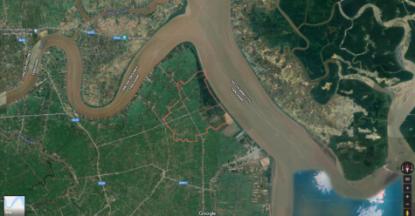
Gia Thuận jungle is the dark area within the red-delineated lines marking the boundary of Gia Thuận village
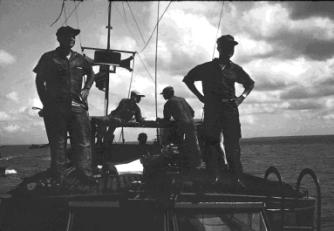
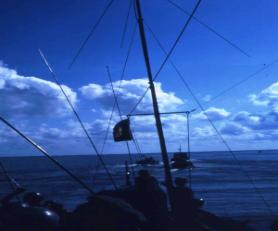
Navy advisors and Vietnamese officers commanding Gia Thuận River Assault Group operation
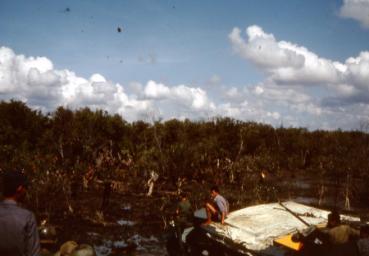

South Vietnamese troops prepare to disembark (right) and fan out into Gia Thuận jungle (red scarves visible)
We embarked at 0400 hrs and proceeded down from the town of MyTho to the entrance of the Cho Gao canal which, as the map shows, connects with the Vam Co river which is the boundary between Go Cong and Long An province. In turn, the Vam Co Tây connects to the Soai Rap river that goes to Saigon, and this is the route by which most of the Mekong Delta’s rice reaches Saigon. At dawn we arrived at the Gia Thuận jungle, and the troops disembarked to conduct a sweep of the area. Nothing was found and, as in the case of so many such uneventful operations, the expedition re-embarked and returned to its base.
Later in 1966, the U.S. sent in a river patrol task force to help interdict the movement of supplies and members of the revolutionary movement along the waterways in and around Dinh Tuong. “… Game Warden (the Navy’s river patrol operation) developed largely in response to the deficiencies of the Vietnam Navy. For much of the war, Vietnam Navy riverine boats were employed mainly to ferry and re-supply Army of the Republic of Vietnam (ARVN) units rather than to deny the enemy the use of South Vietnam’s rivers. The Mekong Delta alone contained over 3,000 miles of waterways. MACV could not hope to defeat the insurgency without establishing some semblance of government control there. Consequently, a 120-boat U.S. Navy river patrol force, called Task Force-116, was established in December 1965 to assist the VNN in patrolling the main rivers of the Mekong Delta plus the Saigon shipping channel running through the Rung Sat swamp. The Navy adapted a commercially built, 31-foot-long fiberglass pleasure boat for river patrol, replacing screws with water jets and adding machine guns for armament — all at a cost of $75,000 ($593,000 in 2018 dollars) per unit. Like the PCF, the Patrol Boat, River (PBR) was a cost-effective and innovative application of off-the-shelf technology to a military role.95
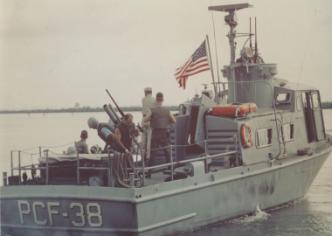
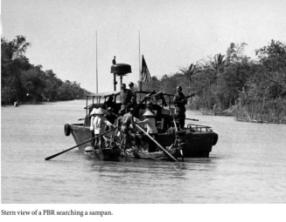
One day a naval officer showed up at our door in My Tho. Lt. Jg. Henry Klein had just come from the sector advisor’s house where he had been seeking information about Viet Cong activities in Dinh Tuong, which was his new base of operations as part of Task Force 116, assigned to Game Warden duty along the waterways of the upper branch of the Mekong and Dinh Tuong province. The province advisors told him about our Rand project and suggested he stop by to touch base, since we were just down the street from them. I was immediately impressed with Klein’s desire to understand the societal context in which he was operating. He had concluded that in order to be able to distinguish unusual activity from normal routine, he would have to know what the rhythms of daily life along the river were. He was frustrated by the lack of information he had been given about the local context of the war, and wanted to know more about the life of the people on the river, and the enemy whose supplies he was trying to interdict. Unfortunately, Mai and I were not experts on this subject, but we did the best we could. He invited me to join him on a daytime patrol to observe his unit in action, in the hopes that I might be able to provide some local knowledge and, in turn, that my studies of the Viet Cong would benefit. I happily accepted, glad to get this new perspective on the activities around the province.
The patrol was a memorable occasion, still preserved in a few minutes of shaky 8mm video in my possession (unfortunately double exposed, so that the river scenes are mixed in with unrelated shots of the Vietnamese countryside). Unfortunately I shot only the trailing boat, and have no footage of Henry Klein.
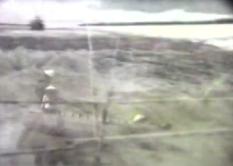
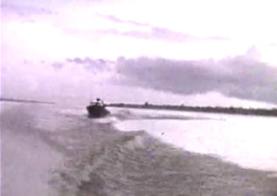
Blurred 8mm home video capture frame – on left trailing PBR taken from Lt. Klein’s lead patrol boat with double exposure of a sampan.
On right trailing PBR.
The following day, as a gesture of thanks from his crew, Henry came to the house and gave Mai a set of navy fatigues as a gesture of thanks and a kind of honorary link to his unit. These still hang in her closet today, and we both remember this gesture of friendship and solidarity with gratitude and appreciation.
Not long after that, Lt. Jg Henry Klein’s unit moved from My Tho to operate in another area. I left My Tho for on home leave, and when I returned I learned that Henry Klein had been killed on an operation in Phong Dinh province in the lower Mekong Delta. The official account of his death is as follows:
At 2030 on 2 December, a PBR patrol in the lower Bassac River picked up two small, high-speed contacts moving from the northern end of Cu Lao Dung Island toward the west bank of the river. The lead PBR moved upstream to investigate and at a range of 200 yards, illuminated the contacts – two motorized sampans. No one was visible and the Patrol Officer, LTJG Henry I. Klein, Jr., fired two warning shots. Suddenly the sampan’s occupants began firing with automatic weapons. The PBR’s searchlight was secured, and the sampans taken under fire. The PBR cover boat then moved in to support the lead boat’s withdrawal. The PBR’s M-79 grenades and .50 cal. machine gun fire destroyed one of the sampans. LTJG Klein died of a gunshot wound in the chest. He was the first GAME WARDEN officer to be killed in action.96

An LCM-6 is being used as a makeshift pier for U.S. Navy PBRs transiting to other bases. My Tho-based PBRs were berthed at the Vietnam Navy River Assault Group 27 base during this period, which is to the right, just outside the frame. December 1966.
I of course grieved that an American officer had been killed, but was hit especially hard by news of the death of Henry Klein, because he was a truly remarkable person – the best America had to offer. He was very bright and extremely intelligent in trying to work out the best way to perform a mission that was exceptionally challenging. He was not satisfied with a by-the-numbers approach to his patrols, but wanted to understand everything he could about the local context that would give his crew an edge, and make their operations more successful. The fact that he sought me out to learn more about this local context was, in my experience, very rare among the many American units, army and navy who I encountered during my years in the Mekong Delta.
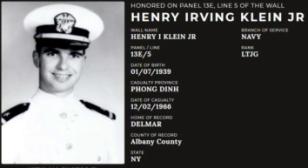
The Mekong River’s upper branch was the southern boundary of the province of Dinh Tuong. The northern boundary was the Plain of Reeds, a vast swampy area laced with irrigation canals dug during the colonial period. One of these was the Dương Văn Dương canal which ran east to west starting from the Mekong river and ultimately connecting and connected with the Vàm Cỏ Tây river, the main waterway in Long An province, just north of Dinh Tuong. Formerly known as the La Grandiere canal, it was the most important waterway in the Plain of Reeds. The town of Tuyên Nhơn was established at the confluence of the canal and the Vàm Cỏ Tây to monitor river traffic and to provide a small market for what was then a thinly populated area surrounded by swamp. In 1965 the U.S, Special Forces established a base camp there for a small “A team” detachment.
In the spring of 1967 I learned that my high school classmate and childhood friend Nick Vay had been transferred to take command of the Tuyên Nhơn A team contingent. Nick came from an aristocratic Hungarian family. His widowed mother had fled Communism and emigrated to the US finally finding employment with a wealthy Palm Beach socialite who had established a summer school for international students in Canaan, Connecticut which my father directed for a number of years. My brother and I became close friends with Nick, who from an early age showed an affinity for the weapons he would later carry as a professional soldier.
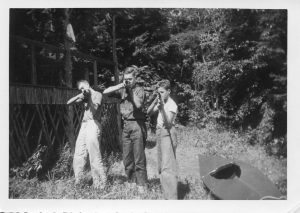
DE, Ward Elliott and Nick Vay defend their territory in Twin Lakes, Connecticut
After graduating from Deerfield Academy, Nick had gone on to West Point with the class of 1961. He was by 1966 a captain and already had one command stint under his belt in an old Bao Dai hunting resort in the Central Highlands. Nick dropped in to see us in My Tho during his stay in Tuyên Nhơn, and invited me to visit his camp. I traveled there by helicopter which set down on the narrow raised platform of land where the A team had built its base, consisting of a large tent, and a few smaller tents and a mortar pit. The first sight I encountered was a civilian patient dying of rabies, lying on a table in the big tent and being cared for by the Special Forces medic. He was thrashing around in agony and frothing profusely at the mouth. It is one of the most gruesome spectacles I have ever witnessed, and demonstrated that the Viet Cong were not the only hazard in the remote Plain of Reeds.
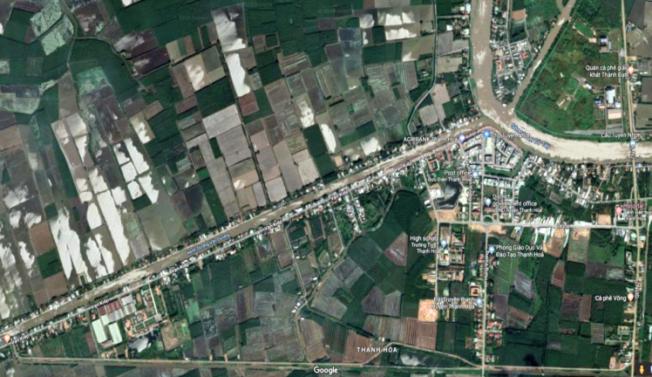
Tuyên Nhơn district as it appears on Google in 2109, with houses and commercial development filling in once empty space. The market and district compound are at the southwestern confluence of the Dương Văn Dương canal and the Vàm Cỏ Tây river. The former Special Forces camp was on the south bank of the canal, probably around where the words Vạn Kiếp are written on this map.https://www.google.com/maps/@10.6567617,106.1727388,2215m/data=!3m1!1e3?hl=en-US
Nick gave me a short tour of the camp – there was not much to see. That night I was awakened by a thunderous explosion. I jumped up thinking we were being shelled, but it turned out that it was outgoing rather than incoming fire. Nick was there along with his mortar man, who was struggling to adjust the fuze of a shell. The fuze appeared to be stuck. After a few minutes, he gave up and popped the shell in the tube with an unadjusted setting. “Good enough for government work,” he said with a touch of sarcasm – one of the classic commentaries on the Vietnam War that I heard during my seven years there. It was not clear to me whether there was an actual target, or whether this was so-called “harassment and interdiction fire,” random shelling just to let the enemy know you are there. Of course “H & I fire” was a major source of civilian casualties.
The following day, I climbed in a ¾ ton truck with Nick driving to go to the district headquarters, which was about a quarter of a mile down the canal from the A camp. There we met up with Nick’s counterpart Major Chất, the district chief, who was also our landlord and whose family lived in the attached house next to ours at 27 Hung Vuong in My Tho. I had known him since he was a Lieutenant when we first moved to My Tho. His connections had propelled him up the promotion ladder with unusual speed and he was now in charge of a remote, but strategic district.
As in the case of the Red River in North Vietnam, the canal and been built up in embankments as well as dug down, and the water flowed between breastworks that were about six feet high, and probably at least that width at the base. Alongside the base was a slick, muddy one lane dirt path – it could hardly be dignified by the term “road” which went along the canal to the district seat. We plunged down to the path from the high ground of the campsite and immediately started to fishtail along the slick muddy surface. The vehicle was spitting out geysers of mud as the tires tried to gain a purchase. Several times I was sure we were going to spin out into the swampy terrain bordering the path on the other side from the canal. As I was hanging on for dear life, I happened to glance up toward the canal. The top of the dike was about eye level, and we could not see the water in canal flowing by. But I did see a sampan on the surface of the water gliding by effortlessly within meters of our truck and leaving our laboring vehicle to slither in the mud. “Did you ever consider doing that?” I asked Nick. He snorted contemptuously. “That’s not the Army way!” I have always thought that this tableau encapsulated the reasons we could not succeed in Vietnam, slithering and fishtailing in the mud while the Vietnamese, taking advantage of their familiar environment, effortlessly slipped by us.
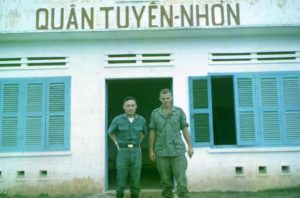
Captain Nick Vay, commander of the Tuyên Nhơn district Special Forces “A team” and his counterpart, the Tuyên Nhơn district chief (and my landlord in My Tho) Major Chất.
Friends and Colleagues
One of the things that made life bearable despite the stresses of the backdrop of war was the friends and colleagues that we occasionally socialized with in Saigon or My Tho. We tried to get back to Saigon every few weeks for a weekend for a change of pace and so Mai could see her family. Often our host was Doug Scott, who generously allowed us to stay with him at his large villa on Le Qui Don street. The exoticism of this and other Vietnamese place names occasionally overwhelmed some of the senior members of Rand’s Saigon office, like retired Col. Ken Strother, one of the line of former officers that Santa Monica sent out to baby sit the predominantly younger staff after Leon Goure and Chuck Thomson were edged out. Ken struggled to transform the incomprehensible Le Qui Don into something that felt more comfortable resulted in a serviceably understandable “Lake Ladonga.”
Ken found it hard to relate to some of the more free spirited younger people, including me. On one occasion, I went to the door of the Rand villa at 176 Pasteur to receive a distinguished American military visitor. I introduced myself as “Sp. 5 Elliott, ret.” Ken, who was right behind me was appalled. “You can’t say that!!!” For him, my flippant attempt to note my insignificant and transient military career was an unpardonable violation of military etiquette. Only high ranking career officers, honorably retired after a long career of service were entitled to style themselves “Col. X. ret.” My attempt to state in a humorous way the fact that I had served in the Army, but briefly, and in a low-level capacity did not go over well with Ken.
Doug Scott also had a sense of humor, which frequently agitated Ken. Doug was a person of many talents, who had never seemed to find recognition for his musical ability and literary flair. Doug had wound up as an editor for the Social Science Department at Rand. When he heard that Rand needed bodies in Vietnam to oversee the interviews, he felt that this would be an interesting challenge. In 1966 he discovered that although Cambodia was off-limits to Americans as far as military personnel and official Americans were concerned because of tensions between the US and Sihanouk, that Rand fell between the cracks and was not subject to these restrictions. Mai and I were glad to take Doug up on his invitation to join forces for a tourist visit to Cambodia.
In early 1967 Pnom Penh was an island of tranquility in a turbulent region. We stayed at the premier hotel in town, Le Royal, which years later became the hangout of a carnival of journalists, and a symbol of the war-induced decadence of a society that was falling apart.
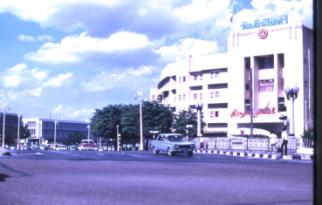
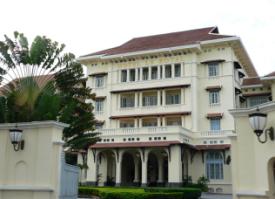
Hotel le Royal Phnom Penh 1967 Hotel le Royal Phnom Penh 2019
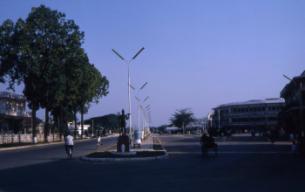
Phnom Penh boulevard 1967
We toured the broad, silent, and nearly empty boulevards in two cyclos, Mai and I in one and Doug in the other, Doug later reported his conversation with his cyclo driver: “You want nice girl?” “No.” “You want nice young girl?” “No.” You want boy?” “No.” “You want young boy?” Same answer, until the cyclo driver had exhausted his repertoire of attractions.
Following sight-seeing in Phnom Penh, we hired a car and driver and went south to visit what was billed as Cambodia’s Riviera, Kep-sur-mer. Along the route was a small mountain with a casino at the top in a place called Bokor. We decided to drive up to check it and, after ascending a winding road cutting through what looked to be impenetrable forest, suddenly arrived at an open clearing at the top dominated by a surrealistic building, which was the casino. It look like a set in an Antonioni film – a detached and dream-like scene. It was also off-limits to Cambodians, by order of Sihanouk. It was certainly not Monte Carlo. We went inside and saw a few Chinese in undershirts, stripped down for gambling action, and spitting on the floor, which was littered with straw to deal with this cultural practice.
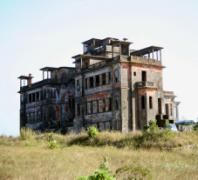
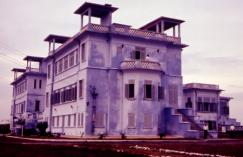
Former Bokor Casino and Hotel, 2007 Bokor Casino and Hotel 1966
It did not fare well under the Khmer Rouge
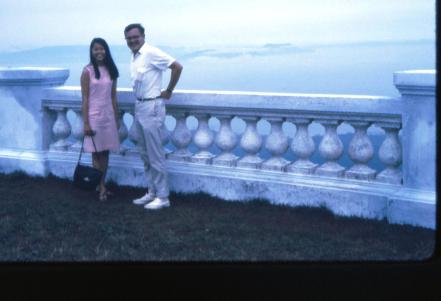
Mai and Doug Scott in front of Bokor Casino ballustrade
We continued on our way to Kep, and were greeted at the outskirts of the town by a statue of Sihanouk in the pose of Rodin’s Le Penseur.
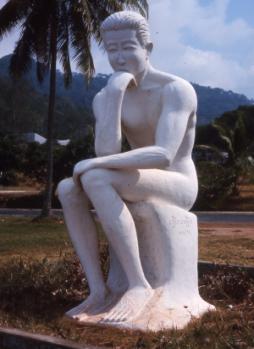
After having lunch in what was once an elegant hotel for international tourists in Kep, as the only guests in a cavernous dining room, we rented a boat and spent the rest of the day on a nearby island, which was a weekend resort for the Phnom Penh elite. Unlike Kep, the “Riviera of Cambodia” which had an unusable beach with sharp stones that made it impossible to walk barefoot, or even go in the water, the island had a nice secluded sandy beach which we thoroughly enjoyed.
After this interlude we traveled to Angkor Wat, and had the privilege of visiting this extraordinary complex almost entirely by ourselves. The site which is now overrun with tourists was nearly empty (though not as deserted as in 1990 when I visited with former Senator Dick Clark and there were less than a dozen tourists in the entire Angkor/Bayon complex. We stayed in the picturesque Auberge des Temples Royales right across from the main temple (leveled during the Khmer Rouge period). At night, there was a spectacular illumination of Angkor Wat. Then it was back to the grind in Vietnam, where the war raged on.
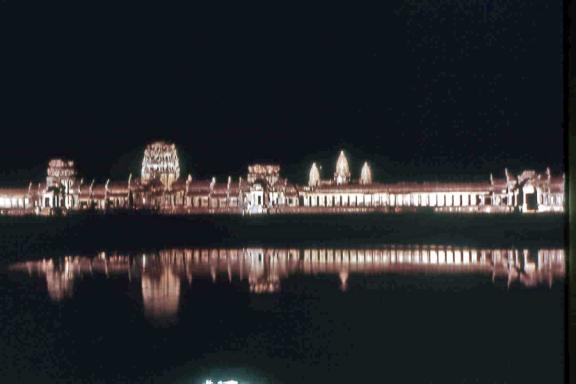
Illuminated Angkor Wat Temples – 1966
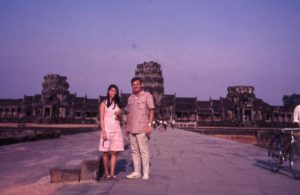
Mai and Doug Scott at Ankgor 1966
Russ and Ardith Betts who worked for Rand out of Saigon were good friends, and would occasionally come to My Tho to visit. We were often joined by Bob Dickerman, the local JUSPAO (Joint U.S. Public Affairs Office) representative in My Tho, who wrote a wonderful book about his experiences as a Cold Warrior that captures much of the zeitgeist of my Generation.
 .
. 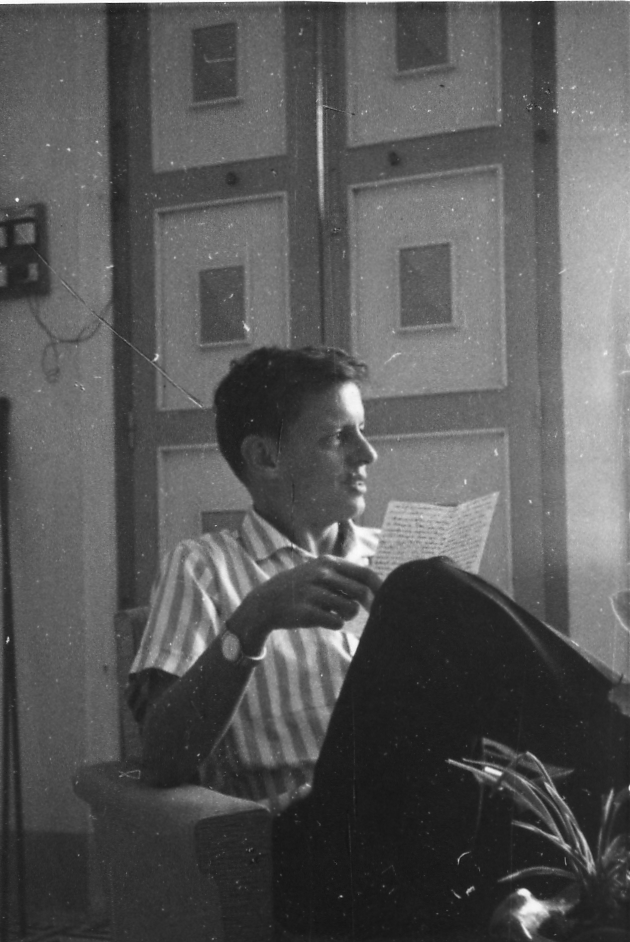
Bob Dickerman in our living room in My Tho, circa 1966
Bob had two accomplishments in the psychological warfare field. He intervened with higher ups in Saigon to get the prosaic original name of the newly built base for the U.S. Ninth Division in Dinh Tuong, “Base Whiskey” changed to “Đồng Tâm” (“with one accord”). The second splash Bob made was discovering that one the ralliers that we had interviewed (DT170) had been transformed into a national Viet Cong hero. His new story was that he had heroically sacrificed his life on the battlefield, and he was selected to become a model for emulation. It must have been an embarrassment to the Viet Cong to discover that not only was he alive and well but, far from being a hero, he was an ordinary defector.
In Saigon, we enjoyed the company of Joe Carrier and Gerry Hickey. Gerry was Rand’s star in Vietnam. A Ph.d in anthropology who had done work with Paul Mus at Yale, Gerry was the undisputed authority on the Montagnards. Mai has written perceptively about Gerry’s experiences in Vietnam, based partly on his own autobiography.97 Despite Rand’s dismissal of academic titles in Santa Monica, in Saigon the Rand office made every effort to ensure that Gerry was referred to as “Doctor Hickey” to underline his academic credentials. Ironically, of all the members of the Rand staff, including several retired colonels, Gerry was the only one to experience real combat, in a hair-raising encounter at the Nam Đồng special forces camp in 1964, when the camp was nearly overrun, and in defense of which Captain Roger Donlon received a Medal of Honor. (During the Tet Offensive, Jon Harbut, another team leader was caught in the fighting and had part of his hand blown off).
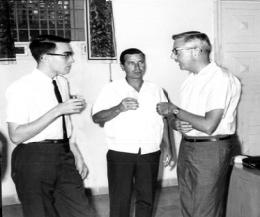
DE, Joe Carrier and “Doctor Hickey” at 176 Pasteur circa 1966. Gerry was known to the Vietnamese as “Ong Wickey” to Joe’s great amusement.
And then there was Tony Russo, who subsequently achieved notoriety as Dan Ellsberg’s collaborator in bringing the Pentagon Papers to light. I recall Tony as someone who had passionate feelings about the war and wrote some essays on subjects like crop destruction which stirred up great controversy. My most vivid personal memory of Tony was the occasional Sunday dim sum brunches that we had in Cholon, which he relished with great gusto, stripping down to his undershirt and loosening his belt like the Chinese gamblers in Bokor (and many of the Chinese dim sum diners in Cholon) to maximize the gusto with which the activity could be pursued.
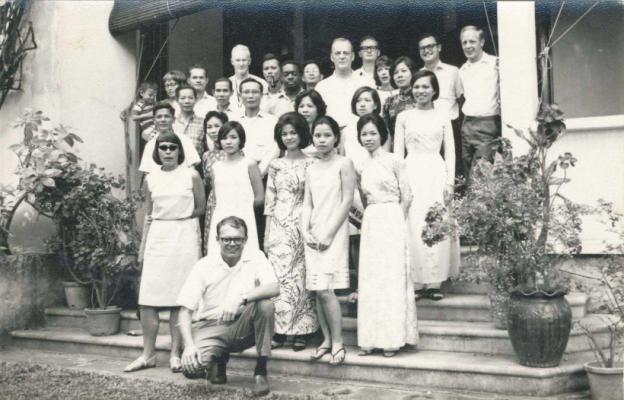
Rand group photo circa 1966 – back row on left (with child) Ardith Betts, Chuck Thomson (third from left), Ken Strother (upper middle of photo), next to him is Jim Carlson, Russ Betts is on far right (back row) and Doug Scott is next to him. Tony Russo is kneeling, front center of photo.
When we returned to the U.S. for an “R&R” [rest and recreation] break from the grind at the end of 1966, we stopped off at Rand. Tony Russo, in a gesture that prefigured his later antiwar conversion, informed us that there would be a concert in support of Cesar Chavez and the farm workers. It would feature Joan Baez. I wasn’t particularly attracted to the politics of the event, and wasn’t paying close attention to U.S. domestic politics at the time, but I was a passionate fan of Baez and relished the chance to hear her in person. The occasion induced somewhat of a culture shock, as we milled around in the lobby of the Santa Monica Civic Auditorium with a gaggle of flamboyant and whimsically dressed hippies. Although I had touched base in the U.S. the previous year and had briefly been in Santa Monica, it was only at this event in late 1966 that I was fully exposed to the magnitude of the culture change that had taken place in America since I had departed for Vietnam in September 1963 as a child of the Silent Generation. I had left the America of the 1950s and, like Rip Van Winkle, had re-awakened in the 1960s. I was appalled at what I considered to be the disjuncture between exhibitionist posturing and the serious politics in which I had been immersed in Vietnam, where there was little room for “Puss ‘n Boots” costumes favored by the hippies and where people dressed in tattered clothes because that’s all they had. I thought that the politics of the farm workers deserved more than providing an occasion for slumming flower children.98 I will always associate Tony Russo with the moment I was first exposed to the 1960s. Tony himself did not get sidetracked by the externalities of the counter-culture but, as events would show, plunged directly into political action. After this, in a way it was a relief to get back to Vietnam, where I felt more at home.
Wrapping Up Phase One in My Tho
By the end of 1966 a picture of how the Viet Cong operated in My Tho was beginning to emerge, and we were able to move beyond the stories of individuals and specific villages and units to see a broader picture. I did not begin to write this up until late 1967, and the resulting Rand Memorandum was not published until 1969. There were also changes in the larger Rand
Vietnam program in late 1966. Leon was under siege from Rand headquarters, as the criticism of his work mounted. Gus Schubert “tried to institute some control and went to great lengths to apply the RAND review system to Leon’s work.”99
On December 13, 1966 Leon took me, along with Mai, to a briefing he gave to Westmoreland. Somewhere along the line I’m sure I mentioned some of our preliminary findings in My Tho, but the main thrust of this encounter was Leon accentuating the positive, as usual. Although, Westmoreland has often been criticized for his own over-optimistic reading of the situation, and though he had expressed interest in Leon’s previous briefings, this time he did not bite. Although he was polite and cordial, Westmoreland was non-committal. Decades after the fact, both Mai and I, on separate trips to the LBJ library, came across Westmoreland’s diary entry on this meeting. As Mai summarized it, “Westmoreland noted that, since he did not trust what Goure had to say, he did not trust what the Elliott’s had to say either.”100A year later, my RM on the cadres had reached Westmoreland, and the reception this time was more positive. I wrote Chuck Thompson, who co-authored the RM, “The cadre paper, as you have probably heard by now, got raves from Westmoreland and 300 copies have been printed.”101 I assume, therefore, that if Westmoreland was skeptical of what he was told in our December 1966 meeting, it was more a reaction to Leon than anything Mai or I said.
The cadres paper was printed as a Rand Memorandum (RM) in March 1967, but my work on it was done by the end of 1966. The year 1967 was a year of ups and downs for me and the My Tho project. Mai and I spent a week in Hong Kong in June 1967, and splurged on a room in what was then the most luxurious hotel on the island, The Mandarin. It was just as well, because I spent most of my time in the hotel room, totally exhausted with what turned out to be a serious case of infectious hepatitis. Even if I had been in better shape, it was not a good time to visit Hong Kong, since the radical phase of the Cultural Revolution in China had spilled over into the colony.102 There were student and worker demonstrations, sometimes violent, and the streets were empty and forlorn.
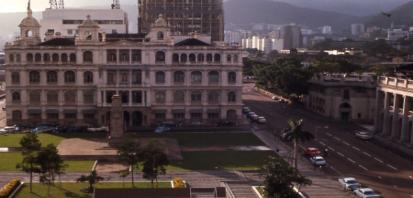
View of empty streets of downtown Hong Kong from the Mandarin Hotel, June 1967.
After a week, we returned to the relative tranquility of Vietnam. It took a while for my malady to be correctly diagnosed, but the only treatment was bed rest. So I stayed in My Tho for several weeks. As the affliction progressed, I began to suffer agonizing itching all over my body, the more frustrating because it was not a skin ailment but carried by the blood and not able to be relieved by scratching or by medication. It was the most excruciating physical ailment I have ever suffered.
Finally, since I was not getting better, I went back to Saigon, seized by vomiting all the way. In the end the Third Field Hospital determined that I should be evacuated to the hospital at Clark Air Force base in the Philippines, because no U.S. military hospital in Vietnam had an isolation ward dedicated to hepatitis patients. By this time itching and vomiting had subsided, and I recall feeling faintly ridiculous when, as I was standing around an ambulance waiting to take me to Tan Son Nhut airbase. Standing next to a stretcher on the ground, I idly wondered what grievously wounded GI would accompany me to the airport. I was told to get strapped into a stretcher, like a victim of war wounds because protocol demanded that if you rode an ambulance as a patient you had be strapped into a stretcher.
The ambulance took me to a non-descript complex of two concrete buildings at Tan Son Nhat about twenty meters apart, connected by an enclosed concrete corridor. There were concrete ramps leading up to the entrance of each wing. As I soon discovered, the building on the left was the morgue, holding bodies pending repatriation to the United States. I’m sure that the gruesomely wounded soldiers in the other wing of the pavilion were grateful that they had been able to be taken up the right hand ramp, rather than the one on the left.
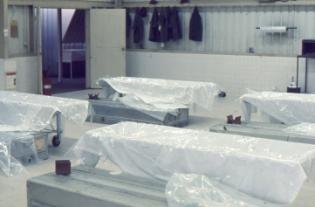
Morgue at Tan Son Nhut airport
The building on the right was a medevac transit center for seriously wounded troops being evacuated either to Japan or Clark Air Force base hospital in the Philippines. Since I was working for a defense contractor, I had been channeled into the military medical system, and ended up at this medevac transit center. It was a charnel house, with horribly wounded GIs packed in awaiting transport, suffering their wounds in drugged silence, swathed in bandages, their attached tubes protruding, and carrying their coloscopy bags with them. Since my problem now was mainly a debilitating weakness I, of course, felt extremely out of place in this tableau of trauma.
Early the next morning we were loaded onto a C123 transport bound for Clark Air Force base. As in the ambulance which had taken me to Tan Son Nhut, I had to follow medical protocol and was strapped onto a stretcher and stacked with the seriously wounded for the flight. For the hours that it took to get to Clark, all I could see was the stretchers surrounding me, many with blankets flattened out on the bed where legs should have been. As in the case of the visit to My Tho hospital to visit the civilian burn victims, this experience was one of the infrequent times that I came into direct contact with the gruesome face of war.
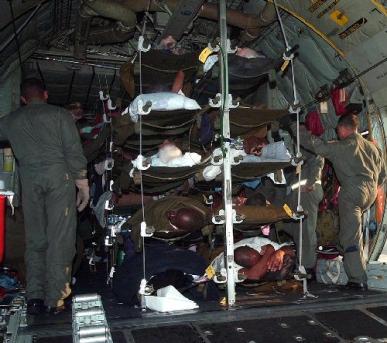
A typical Medevac flight
When we arrived at Clark, I was taken to the base hospital hepatitis ward, a long barracks style room about the length of a football field, with perhaps 50-70 beds in two rows, one on each side of the room. The three weeks I spent there vegetating and waiting for my blood count to improve were boring, lightened only by a welcome visit by Mai, whose trip to the Philippines had been generously underwritten by Rand.
For the most part the patients simply lounged around on their beds and read or listened to music. One educational aspect of this was that I was able to experience a pale version ot the culture war that tore many units in Vietnam apart. There were perhaps four or five black soldiers in the ward, all of whom were insistently playing Motown hits at top volume, to the dismay of many of the others in the room (there were two or three other civilians and a major who loudly complained about being put in with undeserving civilians and enlisted men). They did it in the spirit of asserting their rights, and underlining the changes in race relations that were sweeping the United States in the summer of 1967. Since I had been out of the army for several years, this was my first close up exposure to how much things had changed. The other patients were all enlisted men. I had a small transistor radio, which had just become the rage. I listened to it through an earbud hours on end. As a result I developed a nagging case of tinnitus which plagues me to this day – a memento of my stay at Clark.
Because of this interlude of illness, I was largely out of touch with the My Tho project, which continued with Phước, Cầu and Bách doing weekly interviews. This was a critical period to have moved back from the front lines of interviewing and analysis because this would have been the period in which indicators of the impending Tet Offensive might have surfaced. I have to say that after going over the interviews after the fact I don’t see many obvious pointers to Tet, although we might have suspected that a major attack on the town of Cai Lay in November 1967 was a dress rehearsal for the something bigger.103 But that would have required putting it the larger framework of a concerted nationwide offensive on all major cities and towns in Vietnam, something that would have seemed inconceivable before it actually happened.
In late 1967 I had decided that the time had come to move on the next stage of my life, and had applied to graduate programs at Berkeley, Columbia, and Cornell, knowing that I would have to start graduate studies from scratch in order to pursue my interest in Vietnam and Asia. So we packed up our household goods for shipment back to the United States, and closed the My Tho house to move to the Rand villa at 176 Pasteur until I could finish writing up a final report on the My Tho project.
By this time Leon Goure and Chuck Thompson were out of the picture. Several retired military officers had come to Pasteur to keep the trains running until Rand decided what it wanted to do with their programs in Vietnam. Bill Jones, a retired Air Force colonel was sent to Vietnam in the fall of 1967 as a caretaker. I did not have good chemistry with Bill, who was inclined to paranoia and felt that the long time Rand employees in Vietnam were conspiring against him. In addition, he revealed in a boozy late night conversation with me that he was convinced I was a CIA plant in Rand. Needless to say, I was not pleased by this accusation of being a mole within the ranks of Rand.
I tried to arrange to have the interviewers continue their work in My Tho even after I was gone. By this time I had arranged with Rand to continue working as a consultant while in Taiwan, where I had decided to spend six months studying Chinese language prior to resuming graduate study in the fall of 1968. I would take with me a sack full of captured Viet Cong documents, to translate, annotate and analyze while in Taiwan. I had come across these documents on a trip to the newly established Dong Tam base of the U.S. Ninth Division, which had moved into Dinh Tuong in force in 1967. I flew from My Tho to Dong Tam base in the co-pilot’s seat of an OH-1 observation helicopter, surrounded by the large bubble windshield that curved inward at foot level to offer a view below the chopper, which not only facilitated observation but made you feel that there was nothing between you and the scenery outside. We skimmed the treetops about ten feet below us all the way, with the tree canopies rushing up at the bubble windshield at 200 miles an hour. Because the chopper was flying at a forward slant you constantly had the impression that you were about to crash into tops of the trees that were so close you could almost touch them. It was hair-raising; “Mr. Toad’s Wild Ride.” By contrast, flying in a Huey was like riding in a luxury sedan. At 2,000 feet you hardly noticed the speed – it was cruising at altitude, except when the occasional plunging corkscrew descent to a remote postage stamp sized landing zone started the adrenaline pumping.
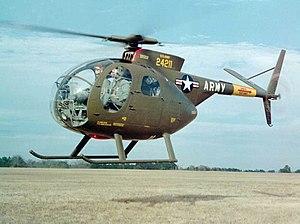
OH-1 observation helicopter
When we arrived at the Dong Tam base, a cannonade of 105 mm artillery fire went off just as I entered the G-2 tent. I discovered that this fusillade had been fired more or less at random, on the off chance that a vague report of VC somewhere in Kien Hoa province on the other side of the river might be accurate. Kien Hoa was regarded as “Indian country” and anyone living there was regarded as a probable VC. It is no accident that the worst civilian death total amassed by the Ninth Division in the infamous “Operation Speedy Express” was largely in Kien Hoa.104
To me this casual shelling, with no verified target and without concern for civilians who might be in the area was nothing short of criminal. But I stayed focused on my main reason for going to Dong Tam. I had heard that an entire unit of the 514th Battalion had been overrun by the 9th Division, and a large cache of documents covering every aspect of the unit’s activities had been retrieved. The 9th Division G-2 had gone through them, and finding little of immediate further tactical value was happy to let me cart them off. In my years of dealing with captured documents, I had never come across a trove which presented such a complete picture of an entire military unit – this was the demolition platoon of the 514th Battalion. (Where was Joe Alsop when I needed him?).
After determining that this was a rare find, I proposed to Rand that I translate and annotate these documents while in Taiwan, for Rand to publish as an RM.105 The contents are well described in Mai’s Rand book.106 This was agreed to by Rand and, since I would be on the payroll as a consultant, I proposed to continue work on the My Tho interviews as well while in Taiwan. The salary and logistical expenses of keeping three interviewers in My Tho were miniscule in the grand scheme of things with Rand, and the payoffs had already been amply demonstrated.
But Santa Monica wanted to end its Vietnam programs, and left it to Bill Jones to bring down the axe on My Tho. The photo taken of me with Bill Jones in front of our house in My Tho just after he had told me flatly that the program would have to shut down tells the story. As is evident from this photo, I was not pleased to receive this news.

Bill Jones informing DE that the My Tho program will have to shut down, circa October 1967.
Mai’s Rand book states, “In an October 12, 1967, letter to Chuck Thomson, Elliott wrote that he tried to keep the Dinh Tuong interviews going after he left, but Bill Jones thought it would be too expensive. Elliott had the feeling that Jones also thought that it could not be ‘effectively supervised’ after his departure, even though Elliott was attempting to make ‘arrangements to return to Vietnam every two months or so’ from Taiwan, where he was going to learn Chinese. In a subsequent letter to Thomson on November 10, 1967, Elliott wrote that Jones had told him “upon his return, after a long party and much booze, that he is going to cut off the My Tho project in three months for ‘lack of funds.’” Elliott, however, felt that Jones’s ‘real objection is not money but lack of direct control.’”107
Still somewhat convalescent, I settled down at 176 Pasteur to write up the final report. During the weeks I spent doing this, I became progressively more depressed with the way the war was going. Like many onetime supporters of the war who eventually changed their view, the process was a gradual evolution rather than a flash of enlightenment. The first step is usually a recognition that the tactics are not working and are often counterproductive. The second step is a gradual recognition that the problem is not flawed tactics, but misconceived strategy. Following that is the recognition that there is no “correct” strategy that would bring a “victory” in Vietnam.
Once that point is reached, the only remaining step is trying to determine what would be the least painful way to disengage for both the U.S. and the Vietnamese who would be certain to suffer grievously in the wake of an American withdrawal. By the fall of 1967 I had reached the stage of recognizing that there was no strategy that would achieve victory. I vividly recall having lunch at the Victory BOQ around the corner from 176 Pasteur and becoming uncharacteristically heated and belligerent in a conversation with a recently arrived civilian contractor, who had come with a laundry list of win the war schemes – all of which had already been tried and found wanting. I had become Ev Bumgardner (“tried that in ‘61”). It was symptomatic of the funk I was in at the end of my first Rand stint.
In his classic study of the impact of the 1968 Tet Offensive, Don Oberdorfer perceptively described the reason for the shift in popular attitudes on the war of Tet. “ ‘And it isn’t working’ was the central justification for the turnabout. Very few of the switchers in Congress objected to the war on moral or legal grounds, and very few of them fit easily under the label of ‘doves.’ .. So long as the war appeared to be progressing at an acceptable price and an acceptable cost, these men did not object. Their quarrel was not with the aims of the war –such as they could perceive – but with failure.”108 In late 1967, I wasn’t ready to admit that the war was a failure, but I certainly felt “it wasn’t working,” and that was a major step along my path of conversion.
The Faceless Viet Cong Emerge from the Shadows
About this time, the journalist David Halberstam came to the Rand villa to do an interview with me, which I agreed to on the condition of anonymity. In a Harper’s article titled “Voices of the Vietcong,” Halberstam did not identify the province by name, or RAND, and referred to me as, “One extremely knowledgeable young American who worked on these interrogations.” In the article Halberstam said he was “impressed by the skill and fairness of the interviewers” and found the interviews “totally absorbing” and revealing about “Vietnamese and Viet Cong daily life.” To him, this was “the real thing.” After reading interview after interview, he concluded that the materials shed light finally on an enemy who had “remained in the shadows” despite years of U.S. efforts to fight them, kill them, and propagandize against them, and that “for the first time we are seeing into the darkness, seeing their faces, often hearing their voices, sensing how they live.”109 I recall that during Halberstam’s questioning, he would probe for signs of Viet Cong weakness or possibilities that the war might end successfully. The more we discussed it the more we both came depressed by the evident fact that the United States was in a cul-de-sac and there did not seem to be any way out. Toward the end of the conversation, there were increasing moments of morose silence as we both contemplated a conclusion that I don’t think either of us wanted to reach. The war had reached a stalemate. Halberstam’s article appeared in Harper’s Magazine on the day of the Tet Offensive.
Pacification and the Viet Cong System
Still, I was not ready to acknowledge that defeat was inevitable, and began to explore what the best possible approach to pursuing pacification would be, given what we had learned from over two years of interviews in Dinh Tuong. I extended the approach I had taken in the cadres RM of trying to identify stress points that could be targeted in order to prioritize the deployment of limited resources. In the case of the cadres paper it was the linkage between the district cadres and the leading village cadres under them.
In the “Viet Cong System” draft it began to dawn on me that one of the reasons that the Viet Cong had remained effective despite seemingly catastrophic losses was that the strength of the organization as a whole was greater than the sum of its parts. “Synergy” was even then becoming a buzz word, but it seemed to apply well to this phenomenon. The resilience built into what I somewhat misleadingly termed the “Viet Cong System” was built on a strategy in which strengths in some areas could compensate for weaknesses in others. There was a balance sought between the unpopulated jungles of Central Vietnam, where the main force units were able to operate on a large scale, with assured supply lines, and relatively secure base camps and escape routes across the Cambodian and Laotian borders; the delta areas would supply manpower and resources to the large units as well as fertile ground for expanding the insurgent movement in one of the critical areas of South Vietnam, and the cities, where military action was impossible or difficult to sustain, could be the setting for political agitation that would destabilize the Saigon government, and whip up anti-American sentiment.
Within each of the three main areas, jungle, delta and cities, there were also ways of pursuing a balanced strategy with tactics that would not put all eggs in one basket. This strategy required constant rebalancing when one component became too weak and required strengthening. What we witnessed in the spring of 1965 was one example: the Mekong Delta had been drained of manpower resources in attempting to strengthen the main force units north of Saigon, and the mobilization measures (compulsory draft and taxation) had weakened it politically in the most critical highly populated area of the country. The Tet Offensive focus on the cities caused the revolution to miss the opportunity to strengthen its hold on the countryside, as official Party histories later conceded. An important objective of the 1972 Easter Offensive was to revive the flagging guerrilla warfare in the Mekong Delta by forcing the GVN to send critical units out of the Delta to put out fires in other areas of Vietnam. The purpose of strengthening the guerrilla warfare movement in the Delta was to prepare for the civil war struggle over people and resources that would follow an anticipated cease-fire.
There would be a variety of different types of military forces, from concentrated main force units, to company and platoon sized local force units, to squad and platoon sized village and hamlet militia units. The art of military deployment was to concentrate or disperse these forces in the most flexible manner, in order to reduce vulnerability, expand mobility, and use the psychological threat of uncertainty about the size and location of forces to dissuade GVN forces from entering large swaths of the province on a regular basis.
One way of breaking up this synergy was to target the local forces and make this a higher priority than going after village guerrillas or province and region main force units. In order to maintain a seamless continuum of forces from large to small, and implement the tactics of concentration and dispersal that were essential to Viet Cong military operations in the Delta, the middle range of force – the local forces – were a key. The logic was the same as focusing on interdicting the district-village link. If you didn’t have the resources to target everything at once, and all the time, selective deployment of assets would be necessary. In order to facilitate this approach, it would be necessary to understand the geography of the base and liaison route network, and ways in which it was used. Finding and attacking the key nodes that connected various parts of these routes and bases would allow more precise focus on military operations. This was the gist of the Viet Cong System paper. Typically, the original draft which I wrote at Pasteur in the fall of 1967, ballooned to several hundred pages.
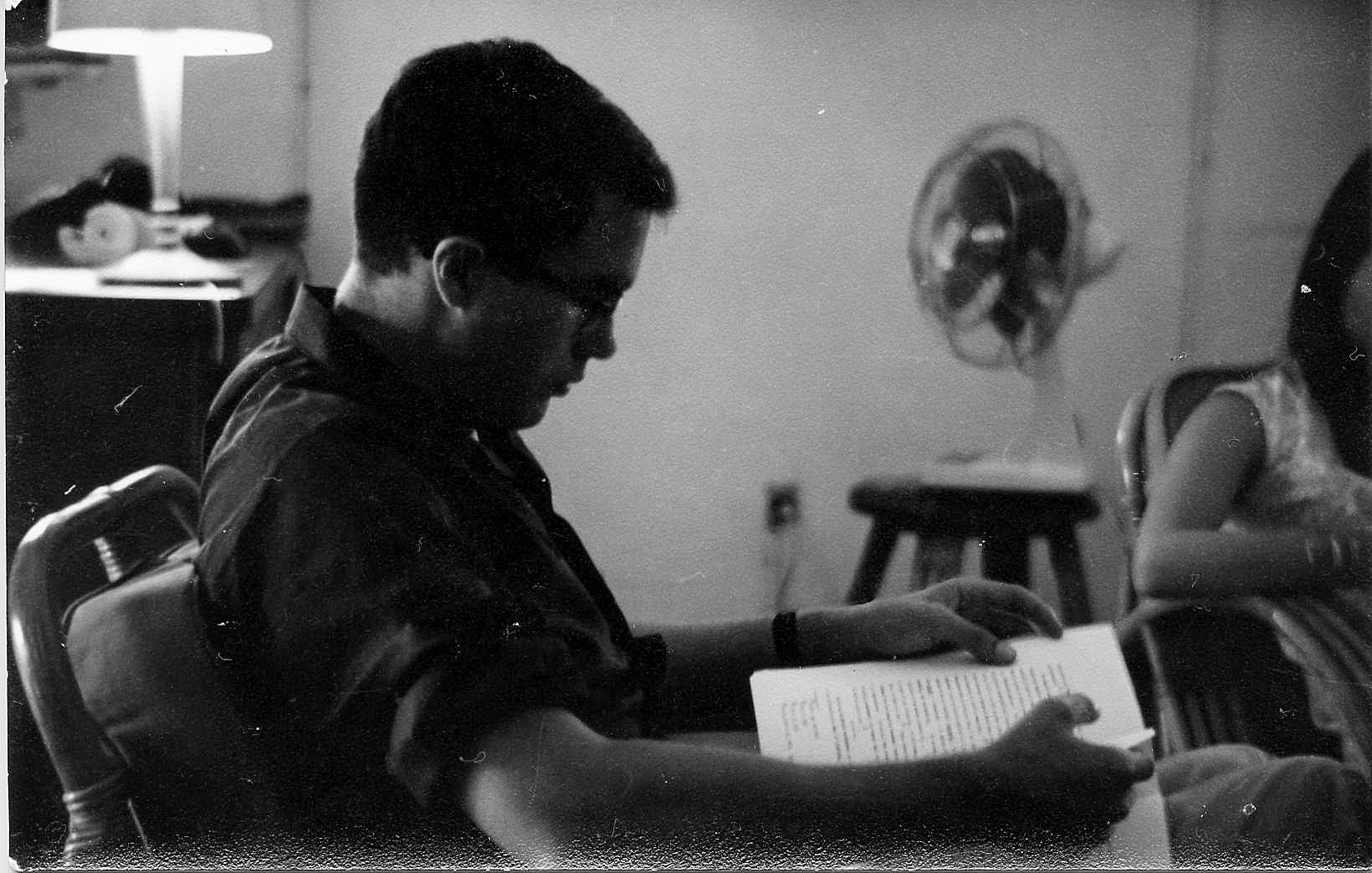
DE reviews draft manuscript of Pacification and the Viet Cong System in Rand office at 176 Pasteur, Fall 1967
As Mai’s Rand book notes “when Dave Elliott’s lengthy report on pacification in Dinh Tuong arrived in the Social Science Department in 1967. Stewart could see that it contained “great insights,” but he knew that the length would deter people from reading it. He decided to edit it down to a manageable size.” Not surprisingly, one of people who preferred the lengthier version was fellow Vietnam-freak Dan Ellsberg. “…Ellsberg, whom Stewart had asked to read the original and the edited versions of the report, himself liked the original version, telling Stewart that the final report was “a decent piece of work,” but that he preferred the ‘bigger version.’ Stewart would later say that he picked Ellsberg as a main critic because ‘he was more likely to oppose it than anybody else.’”110
The “Viet Cong System” Rand Memorandum got lost in the shuffle and was for a while overtaken by events. First was Rand’s decision to end its research activities in Vietnam. Rand was already headed for the exits when the Tet Offensive hit Vietnam, throwing everything into turmoil. When it finally was published in January 1969, the RM got a favorable reception, but by then the idea of pacification through more clever tactics and strategy was no longer on the table. For all the talk of a “better war” to be fought using “clear and hold” and abandoning Westmoreland’s approach, in reality what happened was a return to Gen. DePuy’s “stomp ‘em” philosophy. In many ways pacification did make progress in the years after Tet, but largely as a result of depopulating the countryside – Samuel Huntington’s “forced draft urbanization” with a vengeance, as I tried to document in my book The Vietnamese War.
Move to Taiwan
With a lengthy draft of the final report on the My Tho project submitted to Rand, Mai and I left for Taiwan in late 1967 so that I could study Chinese language in preparation for grad school. By this time, I had been accepted in Cornell University’s graduate program, largely thanks to the support of David Mozingo, who had himself left Rand for Cornell the previous year. Ironically, I was rejected by both Berkeley and Columbia, despite the fact that they were far more disposed to support American policy in Vietnam than Cornell, which was a hotbed of opposition to the war, most notably by George Kahin, and thus probably less put off by someone who had gain his knowledge of Vietnam in the Army and a Defense Department think tank.
I have no idea why Berkeley and Columbia turned me down. Although I did not have a distinguished undergraduate record at Yale, I had recouped this with a quite good record at University of Virginia’s Woodrow Wilson School of Foreign Affairs. My academic transcript there was strong, and I had passed all but one of the preliminary exams necessary to qualify for embarking on a Pd.D thesis. But those rejections turned out to be my great good fortune, as was able to undertake graduate studies under the direction of David Mozingo, George Kahin and a number of truly remarkable faculty in their Government and Southeast Asian programs. My calculation was that if I was going to focus on Asia, my background on Vietnam would not be enough and I would have to develop some expertise on China. Taiwan was very helpful in getting me started on the language, but though I occasionally teetered at the brink of functional fluency, my commitment to Vietnam and immersion in Vietnamese language research kept me from reaching full fluency.
I had opted to live in provincial Taichung rather than Taipei, because the Chinese language training center for the State Department was located there, and I hoped to be able to find trained language teachers who were willing to moonlight. That did not turn out to be the case, but the Taichung branch of the Taipei Language Training Institute proved to be quite satisfactory. Mai and I had a class to ourselves. The other students were missionaries, mostly dour Lutherans from Sweden. The major drawback of Taichung was that fewer people spoke the pure northern Mandarin dialect that I was studying, and the Taiwan dialect was incomprehensible to a Mandarin speaker.
On an outing organized by the Institute, we went to the mountains and passed by a village ceremony being conducted by the aboriginal people who lived there. The Swedes asked our teacher what the ceremony was about. It turned out the village, which had been converted to Christianity, was celebrating its reversion to traditional religious practices. The Swedes, seeing the fruits of missionary labor go up in smoke, were appalled. When we returned to the base of the mountain, we came across a Buddhist temple, and went in to have a look. Mai instinctively lit some incense as a gesture of respect. The Swedes were appalled at the heathen act of this Western-educated Asian woman. They rushed outside, huddled in an urgent strategy session, and then fanned out with proselytizing leaflets to try to recoup their losses.
Apart from studying Chinese, Mai and I translated an annotated the large collection of documents captured from an elite demolition unit of the 514th Battalion in My Tho which I had retrieved from the US Ninth Division in late 1967. These documents gave a remarkably comprehensive and detailed picture of a Viet Cong unit over an extended period. There were personnel dossiers, records of Party meetings and indoctrination sessions, notes on operations undertaken by the unit, and personal letters which shed light on the human dimension of the “Faceless Viet Cong.” Rand published our translation and commentary in five separate RMs. As Mai wrote in her book on Rand in Southeast Asia: The value of the documents lay in the fact that, with the exception of the personal letters, they were written for internal rather than external consumption, and certainly not for the elucidation of the Americans or the GVN. Therefore, they revealed a more candid and more reliable picture of what it was like to live and operate within a Viet Cong unit. Through the documents, the platoon members emerged as real people, with their strengths and their foibles. They wrote about battles and forced marches, recounted self-evaluations given in criticism sessions, confessed their misconduct, reaffirmed their dedication, told their life histories, and explained the reasons they joined the insurgency. ‘They are all here,’ Elliott wrote, ‘The braggart soldier, the repentant sinner, the roisterous but able leaders, the quarrelsome true believer, the romantic revolutionary,” and together their “personal accounts afford unusual insights into Viet Cong practices and habits of mind.'”[4]
As Tet 1968 approached, Mai wanted to go back to Vietnam to visit her family before what was likely to be a lengthy absence as I pursued my graduate studies in the United States. We were able to stay at 176, then in its last days under Rand auspices. Retired Marine Col. Vic Croizat was presiding over the crumbling remains of the Rand project. Mai reports that later Croizat said that agreeing to go to Saigon “was about the stupidest thing I’ve ever done.”111 Bill Jones was also at 176 in the last days of the transition to Croizat.
Two days before Tet, I travelled to Dinh Tuong with Col. Phước. We did a tour of the province, ending up in Cái Bè district before returning to Saigon. Everything seemed bustling and peaceful as we visited the Hồi Cư village market and observed everyone getting ready for Tet.
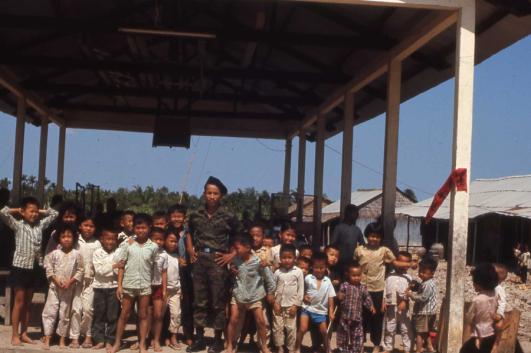
Hồi Cư village market, Cái Bè district, two days before Tet 1968.
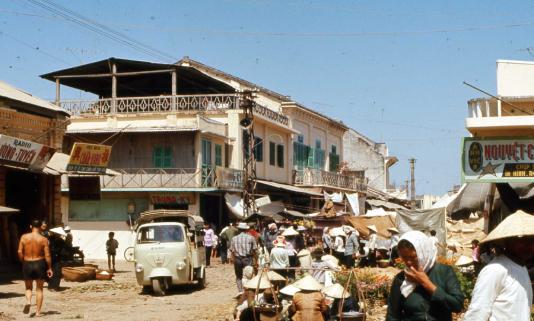
Village market in Cái Bè district two days before Tet 1968
On the drive through the province we could see the toll that the war had taken on the province. Highway 4 through the middle of the province was no longer the smooth newly paved and widened road that it had been in 1966, one of the results of massive U.S. infrastructure projects. Just before Tet it was a dusty dirt road, pock marked with ruts and the damage from VC mines that had hit nearly every meter of the road over time.
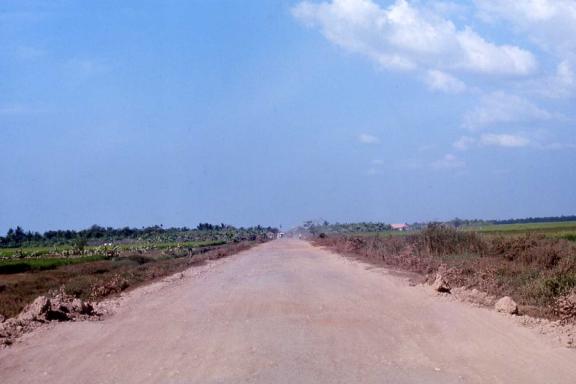
Highway 4 through My Tho on the eve of Tet 1968.
It was an indication of the dangers to civilians in the rest of the province that many had settled alongside this constantly mined road to live in ramshackle straw huts, because they felt more secure in an area that was at least not being bombed and shelled by the U.S. and the GVN.
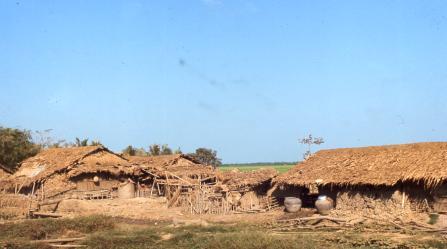
Refugee huts along Highway 4 in Dinh Tuong just prior to Tet 1968
Little did we suspect that there were eight battalions in Dinh Tuong awaiting the attack order for the Tet Offensive.112 We returned to Saigon to celebrate Tet with Mai’s family.
As Mai describes it we “were sound asleep in one of the bedrooms with a window that opened one of the bedrooms with a window that opened toward Thong Nhut, the boulevard that ran past the U.S. Embassy toward the presidential palace, when they were awakened by loud banging on their door. Groggily, they instinctively switched on their bedside lamp and heard the military barking of Vic Croizat, ‘Turn off the light. We’re under attack.’ [The Elliotts] listened for a while, and since there was nothing they could do, they turned over and went back to sleep. In a letter to his family describing what he knew of the offensive, Jones wrote that the RAND villa was located within a triangle formed by the presidential palace, the American Embassy, and the Vietnamese Navy Headquarters, all of which came under attack. These structures were far enough away, however, so that the villa was out of the line of fire. Croizat tried to catch a glimpse of the attack on the embassy by standing on the toilet and looking through the ventilation window near the ceiling, but all he could see was the top of the building. Unlike the Elliotts, who slept comfortably in their bed, Jones wrote that he and Croizat hunkered down and “spent the rest of that night taking cover in case the house was hit by a stray bullet—which it was not.”
“The next days, while his wife returned to her family to spend time with them, David Elliott joined some American correspondents he knew and went around town to check out what was happening as the attacks continued. Jones, meanwhile, was ‘taking all precautions.’ The two ex-military men, Croizat and Jones, taking no chances, armed themselves and locked themselves in the villa, which they blacked out each night. Jones found it comforting that the villa was close to “an American, well armed BOQ [Bachelor Officers Quarters],” and felt reassured by the thought that they could ‘always move into the BOQ if things get more tense.’ Jones admitted that he and Croizat were being careful ‘to the point of being considered cowardly by some of the brasher types here.’ He ‘couldn’t care less what people might think,’ however, and would continue to minimize his exposure. By arming themselves, Croizat and Jones violated a RAND stricture. Jim Digby recalled that ‘RAND people were not supposed . . . to carry arms,’ because ‘if they had been caught’ by the Viet Cong ‘they might have been executed.’”113
On the second day of the offensive there was still fighting in close proximity to us. There was a small insurgent unit holed up in the South Korean Embassy building, which was still under construction, and had provided cover for this unit to fire across the street at the Presidential Palace. The group inside this building were the last remnants of the attacking force that operated near us, and they were gradually eliminated.
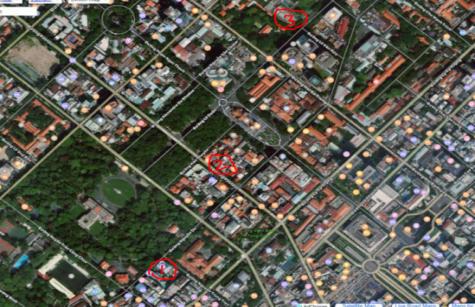
Saigon map. 1 is site of the South Korean Embassy building, 2 is the Rand villa on Pasteur, and 3 is the US Embassy (former sites)
The Saigon government sent up loudspeaker planes which flew over the city urging the population to remain calm and assuring them that the situation was under control.
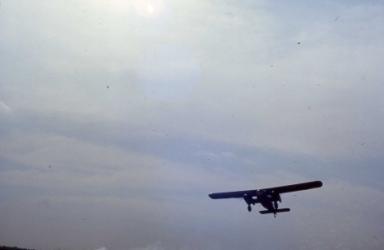
For the first day or so of the offensive we could occasionally see puffs of plaster coming off the building at the corner of Nguyen Du and Pasteur, down the block from us, the result of a continuing firefight between the Viet Cong forces in the South Korean embassy building and besieging forces attempting to dislodge them.
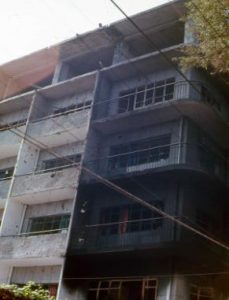
Unfinished construction site of South Korean embassy across from the Presidential Palace several days after the start of the Tet Offensive
Civilian traffic was totally shut down, and most streets in the normally bustling center of the Saigon were ominously deserted, though fighting raged in streets of the outlying districts.
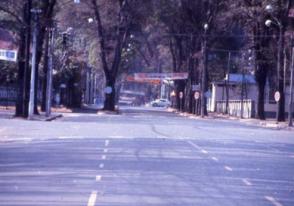
Pasteur street on day one of Tet 1968 with a lone civilian car in view
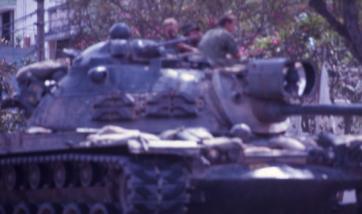
U.S. troops monitor an intersection – Tet 1968
Somehow Steve Schlafer, my fellow linguist from the Monterey Defense Language Institute, now a Buddhist monk, made his way from the pagoda he lived in on the outskirts of Saigon where heavy fighting continued, through the battle still raging in Cholon, and showed up at the gate of 176 Pasteur gaunt and haggard, in his saffron robes with head shaved, in search of a temporary safe haven. Schlafer was one of the most fluent of the Monterey Vietnamese language graduates and, after his stint with the 3rd RRU, stayed on as a civilian in Vietnam and became a Buddhist monk – much to the consternation of his Jewish parents in New Jersey. His conversion took place on December 3, 1967, the month before the Tet Offensive.
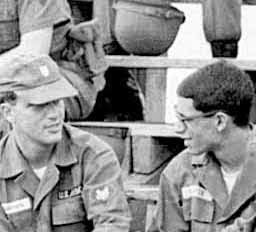
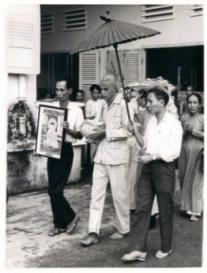
Photo on left: Steve Schlafer at 3rd RRU September 1963 Photo on right: accompanying caption reads “Saigon 1967: Becomes A Buddhist. Saigon: Stephen Schleafer [sic], 24, of Springfield, N.J. who was born a Jew, walks under an umbrella en route to take his vows as a Buddhist (Dec. 3). After serving his hitch as a U.S. military advisor in South Vietnam in 1963, he stayed on to study Buddhism and Chinese literature at Saigon University.”
Steve described his harrowing journey through the thick of the Tet Offensive. He looked emaciated. The most difficult aspect of his monastic life, he told us, was living on one skimpy meal a day. In order to survive, he had been forced to sneak out of the pagoda and clandestinely buy ice cream on a stick to keep him going for the rest of the day. Unfortunately, the Tet Offensive put an end to Steve’s Buddhist vocation.
The person that I spent the most time with during the period after Tet was Don Oberdorfer. We spent hours in his room in the Caravelle Hotel poring over documents which Oberdorfer had collected from his sources. He had been so confident that there would be no major story during Tet that he had gone to Laos to see if he could find anything to report there. It took him several days to find a flight back to Saigon, so he missed the first days of the event. We were, like everyone else, baffled by this spectacular shift in strategy. The Westmoreland explanation, that it was a desperation gamble by a force that was on the brink of defeat did not make a great of sense to us, or to most other observers on the scene.
As we discussed this, an alternate explanation occurred to me. There had been an increasing number of shellings of urban areas prior to Tet which, I speculated, might be due to a desire to stem the flow of population out of the countryside by making the cities equally hazardous, and that the full scale assaults were an extension of this strategy. We both rejected the idea that this was simply a propaganda ploy, to make a big splash in order to divert attention from the setbacks that Viet Cong forces had suffered. The great insight that Oberdorfer laid out in his reporting and his subsequent book Tet, which became the definitive account of the turning point of the Vietnam War, was that the decisive impact on America was not a panicked wave of defeatism, as argued by a number of revisionist historians who blame the press for abetting this alarmism, but rather that the shock of this unexpected event stimulated a fundamental re-examination, for the first time, of the costs and benefits of the war to America.
The real meaning of Tet was that it demonstrated that the war was unwinnable. In newly-appointed Secretary of Defense Clark Clifford’s post-Tet review of the situation, it became apparent that there was no strategy, and no amount of additional troops or weapons that could lead to victory. Walter Cronkite succinctly summarized the significance of Tet when he said “[I]t seems now more certain than ever that the bloody experience of Vietnam is to end in a stalemate . . . [I]t is increasingly clear to this reporter that the only rational way out then will be to negotiate, not as victors, but as an honorable people who lived up to their pledge to defend democracy, and did the best they could.”
As Henry Kissinger acknowledged in his evaluation of the post-Tet situation in Vietnam, “the guerrilla wins if he does not lose.” The original strategy with which the United States entered the war in 1965 was simple: do whatever is necessary to avoid a humiliating defeat.” At the time, Bundy and LBJ assumed that the U.S. would be the side that would win if it did not lose. That was the concern then, and while the intervention staved off an imminent collapse, the question of what it would take to achieve a military victory, and how much it would cost was never directly confronted.
The Tet Offensive forced this reassessment. In the light of the realization that the war was stalemated and militarily unwinnable, the John F. Kennedy rhetoric about “pay any price, bear any burden” now rang hollow. One of Oberdorfer’s key insights was that the shock of the Tet Offensive provided that catalyst that gave people who had supported the war a pretext to abandon their previous position on the war on the grounds that they had been misinformed and mislead. The more I study the communist documents on Tet Strategy, the more it becomes apparent to me that the main goal of the offensive was not to drive the Americans into the sea, or even collapse the Saigon government, and not to stage a propaganda extravaganza to spook the American public, but to convince the political leadership in Washington that the war was unwinnable and “defeat the aggressive will of the Americans.”114 This they did, as evidenced by Clark Clifford succinct summary of the Wise Men’s advice to Johnson: “Mr. President, stop trying to win the war. Start cutting back. Don’t send any more men. We think you ought to get out.”115
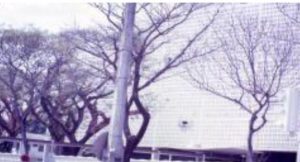
U.S. Embassy post-Tet
Letter on Tet Offensive Written February 11, 1968
Just before leaving Saigon to return to Taiwan I wrote a letter to my family about the recent events in Vietnam. It provides a rare contemporaneous record of my thoughts at a critical juncture of the Vietnam War, the more so because my views were in a state of transition, and it is difficult from the vantage of fifty years after the events to pinpoint exactly where I was in my progressive disillusionment with the war. I suppose that a general summation of the letter would be that I recognized that Tet had transformed the war into a new stage, which might hasten its conclusion, but was still unsure how it would turn out. Although the situation was not as bad as reported, I felt, the war might be entering a terminal phase.
My father was interested in the parts of the letter which mentioned the ameliorating factors, the failure of the “general uprising,” and the heavy Viet Cong losses in particular. He sent the letter to Walt Rostow, LBJ’s hawkish National Security Advisor. The copy below is from Rostow’s files in the LBJ Library. I doubt if Rostow paid any attention to it, though it may have briefly caused him to note my return from the dead, after his May 1966 letter to my father; “Dear Bill: The book Elspeth brought home again reminded me of how often you have been in my thoughts. I tried several times to write about the loss of your son in Viet-nam, but, aside from conveying my deep affection, there were no words to help.”116 Coming across this letter in my father’s archives years later was a reminder that Rostow was not the most perceptive or retentive consumer of the many bits of information that came across his desk. As Mark Twain said, “the report of my death was an exaggeration.”117
Here is the text of the letter I wrote home from Saigon on February 11, 1968, the second week of the Tet Offensive:
David W.P. Elliott
C/o HEDSUPPACT, DET. 3
Box 116
APO San Francisco 96293
Saigon, February 11, 1968
The fighting in Saigon was intense in some areas, notably in the poorer outlying sections of the town. We are staying in the center of town, and were neatly triangulated betweenh the US Embassy, the Independence Palace (of Thieu and Ky) and a spot near the Korean Embassy that was not cleared for a day or so. As a consequence, the battle largely passed us by.
Apart from some inconvenience and a minor food problem, we were largely unaffected by the events of the battle. I had finished the work that I came to do, and have been occupied with relatively minor and peripheral matters for the past week. The situation is calming somewhat, but there are still pockets of resistance in the Chinese section of town and on the outskirts.
This was certainly a spectacular action on the part of the Viet Cong, and demonstrated a capacity for large scale co-ordinated activity that we had not fully appreciated. The planning of the attacks was meticulous and the execution, on the whole, was good. What they accomplished remains to be seen. I expect it will be five or six months before we have any solid indications on this score.
The US officials are claiming a victory, since the Viet Cong were not able to hold any significant areas, and received stunning losses (though the official figures – taken largely from Vietnamese sources – are probably exaggerated). I feel that this is an extremely superficial argument and plays into the hands of those who are critical of the war effort in general.
The critics argue that the very fact that the Viet Cong could enter so many supposedly secure areas is a definitive indication that the pacification program is a complete failure. They are now after Westmoreland, who is the unfortunate object of a concerted attacks by the doves on the press corps. The argument is that the Westmoreland strategy is a failure, and that the Viet Cong successes are, in themselves, clear and sufficient evidence of this failure.
I have been in close contact over the past week with an excellent reporter, Don Oberdorfer of the Knight Press (which is occasionally subscribed to by the Washington Post), who put the matter in a quite different light. Instead of proving that pacification is a failure, he points out, it simply means that pacification is (for the moment) irrelevant. Pacification has to do with the countryside. The Viet Cong strategy, for the moment, is aimed at the cities. In the two (of four) most heavily populated Corps areas, which comprise the majority of South Vietnam’s population, there were no reported attacks on pacification teams in the countryside.
The reason is simple; in these areas the Viet Cong had committed almost all their forces in the attacks on the cities. In the Mekong Delta area, every known Viet Cong unit participated in the attacks on either province capitals or Saigon. North of Saigon, only 50% of the units were committed. The North Vietnamese units are being held in reserve – some people feel they are the nucleus of a second offensive.
The major question is, have the Viet Cong gained sufficient political and psychological momentum by these attacks to compensate for the staggering losses, at a time when they are encountering severe recruiting problems and seeing their grip on the countryside broken? To judge from the reactions of Sen. Edward Kennedy and the New York Times, perhaps they have.
On the other had, it is absolutely clear that the gross miscalculation was made by the Viet Cong strategists, who interpreted signs of urban unrest, strikes, and rising anti-Americanism in Saigon s being a favorable revolutionary situation for them. They were absolutely wrong. The support they gained from the population was minimal, and that largely confined to previous sympathizers who let their houses serve as depots and billets for the Viet Cong troops as they infiltrated in with the crowd coming to Saigon for the Lunar New Year holiday. With the possible exception of Hue, the ancient imperial capital – always xenophobic – no popular support emerged in the cities for the Viet Cong.
Win or lose, the Viet Cong have done us a favor by foreshortening the war. They took a big gamble with their forces, and lost a great deal of manpower. It is not yet clear whether they intended to provoke a general insurrection and bring the war to a close, or whether these attacks are only the beginning of a series of all out attacks which will ultimately lead to the general insurrection. Whichever it is, the war has shifted into a new phase – possibly even the terminal phase.
It is interesting to note that in the New York Times lead article in the News of the Week in Review, no mention was made of the Viet Cong miscalculation concerning the popular support they would receive, and what effects the attacks had on the attitudes of the city population toward the Viet Cong. There is a mounting, but still inconclusive evidence that the Viet Cong not only did not win new support, but lost old sympathizers.
The refugee problem is appalling. There are over 300,000 that have been left homeless – over 100,000 of which are in Saigon. Much of this comes from indiscriminate shelling and bombing right inside the city, by Vietnamese forces (and the US Air Force, but to a lesser extent). Unnecessary as most of this was, it is viewed by the battle hardened Vietnamese population as an impersonal act of war. The blame is equally distributed on both sides, the Viet Cong for provoking the fire and the GVN for shooting. The Viet Cong, however, appear to have deliberately started fires that have burned entire sections of the town so that they could escape among the fleeing crowd. This is not an act of war, it is premeditated arson, and viewed by the people who have been burned out as such.
The government is trying to get the situation under control, and despite inevitable blunders, is making some progress in that direction. The destruction is vast, 25% of My Tho was reduced to rubble as well as equivalent portions of four or five other major province capitals. The clean up and reconstruction job is going to be arduous, but this is the kind of thing we do fairly well.
A more important problem is, where does this leave us with respect to winning the war? It seems too early to tell. My own strong feeling is that, far from indicating a weakness of the rural security program, these attacks are the direct consequence of a limited, but important, success. The control of the Viet Cong over the countryside has been gradually eroded over the past two years – quite seriously in some areas. They are losing their recruiting base by losing access to manpower. Viet Cong documents strongly indicate that they feel that the best counter measure is increased pressure on the urban areas – province towns, district towns, and Saigon. This strategy is based on the principle that the best defense is a good offense. If the Viet Cong are having difficulty holding on to their own base of support in the countryside, they will attack the US/GVN base of support in the cities. This is not a new policy. Since we left My Tho, it has been mortared eight times. Now it is subjected to a full fledged attack.
Whether this will help the Viet Cong restore their control over the countryside remains to be seen. The attacks on the cities were an impressive display of planning and co-ordination but do not seem likely to have any lasting results, other than to tie down additional security forces defending the cities that would otherwise be attacking the Viet Cong in the countryside.
From the point of view of Viet Cong strategy, the decision to shift the focus to the cities strongly indicates that they want to bring the war to a finish, and are apparently prepared to fight it out militarily rather than politically. They know that this tends to even up the score, and have always asserted that the US is most vulnerable to protracted conflict and political action. The fact that they have chosen to fight it out on different grounds indicates that things are not going as well as they would like.
The major advantage that they might gain from all this is to discredit not only the US effort here, but also the people who are most closely identified with it. Komer and
Westmoreland are conspicuous targets at the moment.
Time will tell whether this reflects a real reserve of Viet Cong strength that can sustain itself, and whether or not the political repercussions will work out well for them or not. At any rate the long process of melting the ice has resulted in some substantial cracks and shifts in the situation. When the ice packs breaks, however, it will be difficult to tell who will get crushed. I hope it will not be us.
It is interesting for me to read this letter over a half century after the event. The letter captures, as my memories can not, the point at which I stood on the shifting spectrum from hawk to dove – probably about halfway between the extremes. The preceeding text, which I wrote prior to re-reading my contemporaneous February 1968 letter, is written from the perspective of my current views on that period. The initial impression I get from a preliminary re-read of the letter is of a hard-line hawk, with critical comments about “doves.” But as I put these comments into context, I think that impression would be quite misleading.
First of all, I wrote that letter shortly after an extended interview with two Newsweek journalists – they were the “doves” to which I was referring – whose main agenda seemed to be compile a negative brief on Westmoreland, in order to make him the “fall guy” for America’s failure to anticipate the Tet Offensive. I didn’t realize at the time that de Borchgrave was anything but a dove, but I inferred this from his obvious fixation on making Westmoreland the scapegoat for this shocking setback. I found this outrageous, especially in view of Time and Newsweek’s previous fawning praise of the “inevitable general,” and though I had not been a great supporter of Westmoreland, I thought he was being unfairly scapegoated by vultures in the press swarming into Saigon to seize on the setback to make a journalistic splash.
The journalists in question were Ed Behr and Arnaud de Borchgrave. Ed Behr was the Newsweek Asia Bureau chief. He had reported on Algeria and French decolonization with Reuters in the 1950s, and toward the end of his career wrote an updated version of Evelyn Waugh’s spoof on foreign correspondents (Scoop) which Behr memorably titled “Anybody Here Been Raped and Speaks English?” De Borchgrave was born in Belgium and became Newsweek’s bureau chief in Paris in 1950. Over the course of his career he seems to have become more polemical, especially after becoming editor in chief of the Washington Times in 1985.
In later years de Borchgrave adopted the line of Peter Braestrup’s book The Big Story, that it was the unprofessional and sensationalist Saigon press corps that misled both the public and Washington officialdom about the Tet Offensive, reporting what he considered a crushing defeat as a great victory for the communists.A right wing blog reported that “On February 7, 1986 there was a special screening at the White House of Accuracy In Media’s documentary about the Tet offensive and media malpractice, ‘Television’s Vietnam: The Impact of Media.’ That month’s Accuracy In Media newsletter detailed the comments of former Newsweek editor and veteran journalist Arnaud de Borchgrave immediately following the screening: He had reported to Newsweek from Saigon that the Vietcong Tet offensive in 1968 had been an unmitigated disaster for them. He said that Osborn Elliott, then the editor-in-chief of Newsweek, engaged in a bit of advocacy journalism and declared that it was the consensus of the senior editors of Newsweek that we had lost the war and that we should get out. De Borchgrave said: ‘My file from Saigon reported just the opposite, and not one word of what I filed got in.’ He added that even though he was a senior editor, he had not been consulted and was obviously not part of the alleged consensus of senior editors. … ” 118
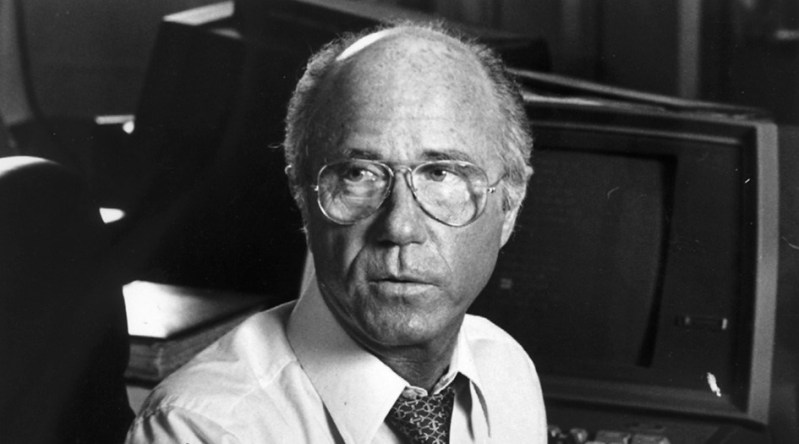
Newsweek journalist Arnaud de Borchgrave
Morever in another retrospective article on Tet, de Borchgrave cited Rand as the source of the “real story” on Tet. By this he did not mean his interview with me, but the immediate post-Tet interviews with a variety of Vietnamese sources on the impact of Tet that Vic Croizat had commissioned. “But Tet was an unmitigated military disaster for Hanoi and its Vietcong troops in South Vietnam. Yet that was not the way it was reported in U.S. and other media around the world. It was television’s first war. And some 50 million Americans at home saw the carnage of dead bodies in the rubble, and dazed Americans running around.”
“As the late veteran war reporter Peter Braestrup documented in ‘Big Story’ — a massive, two-volume study of how Tet was covered by American reporters — the Vietcong offensive was depicted as a military disaster for the United States. By the time the facts emerged a week or two later from RAND Corp. interrogations of prisoners and defectors, the damage had been done. Conventional media wisdom had been set in concrete. Public opinion perceptions in the United States changed accordingly. RAND made copies of these POW interrogations available. But few reporters seemed interested. In fact, the room where they were on display was almost always empty. Many Vietnamese civilians who were fence sitters or leaning toward the Vietcong, especially in the region around Hue City, joined government ranks after they witnessed Vietcong atrocities. Several mass graves were found with some 4,000 unarmed civil servants and other civilians, stabbed or with skulls smashed by clubs. The number of communist defectors, known as “chieu hoi,” increased fourfold. And the “popular uprising” anticipated by Giap, failed to materialize. The Tet offensive also neutralized much of the clandestine communist infrastructure.”119
I recall that in our February 1968 interview, de Borchgrave was particularly interested in singling out Westmoreland as a scapegoat, and while he later adopted Westmoreland’s interpretation of Tet as a victory for the U.S. that was certainly not his view at the time. In the letter I was critical of Senator Kennedy and the New York Times for, in my view, overestimating the military success of the Viet Cong forces, and noted that the civilian population had not come forward in support of the attackers, who had clearly overestimated the level of support they might mobilize in the cities. I neglected to point out that no reasonable person would have rushed into the streets in support of the Viet Cong in the hail of gunfire that they would have had to confront.
The Viet Cong may have done us a favor by breaking the log jam of a stalemated war and moving it to a new stage, I said, though whether or not this would be good or bad for the U.S. was hard to predict. What I meant was that anything that brought us closer to a conclusion to this nightmare of a conflict was good. I was correct to endorse Oberdorfer’s comment that the offensive didn’t prove that pacification had failed, only that it was, for the moment, irrelevant. The Party itself later acknowledged that it had blundered in attempting to sustain the attacks on the cities for too long, rather than taking advantage of the opportunity to undo pacification in the surrounding countryside when the security vacuum there offered them a golden opportunity to do so.
The top Party leader in the upper Mekong Delta wrote after the war “… After the first phase of the offensive, the Region proposed a shift of strategy to focus on expanding control in the countryside, arguing that this would be more suitable for their capabilities. For this, the Region was criticized by COSVN for questioning the Party’s wisdom and for a ‘diminished strategic resolve’ (sụt giảm quyết tâm chiến lược). “Afterwards a number of comrades in Long An and Region 8 were still aggravated and puzzled about why they had to carry out the option (khả năng) of clinging to the outskirts of the cities and towns and suffer heavy casualties and erosion of forces? This was the second scenario [khả năng hai] of the plan for attacking the cities, in case it did not deliver a knockout blow [dứt điểm]. Looking back on it and considering it carefully, this scenario was not reasonable in using military forces to attack into the cities. If you couldn’t deliver a knockout blow that would mean that the enemy was still strong and you had to retreat. If you couldn’t win the first time [first attack] when the enemy was caught off guard, when the enemy had woken up and organized a tight defense, then stopping at the outskirts of the cities would simply mean that the enemy would counterattack and we would be ground down [tiêu hao].”120
In short, I would not retract much of what I said in this later all these years later (other than the comments about Senator Kennedy and the New York Times), but recognize that I had at the time no way of knowing what I called in The Vietnamese War the “untold story” of Tet in the countryside (total collapse of pacification and GVN presence in most rural areas) and only dimly grasped the central strategic objective of Hanoi: to “break the aggressive will of the United States” because I did not grasp the extent to which the war had been transformed by the fact that the offensive had forced a serious reconsideration of strategy, costs, and objectives on Washington for the first time in the war. And though I blamed the press, it was really de Borchgrave I had in mind – not responsible journalists like Don Oberdorfer, one of the preeminent political reporters of his generation, who I saw first hand doing a superb job reporting the offensive and digging deep to figure it out.
Where I was at least partly wrong in my February 1968 letter was in making the following statement: “From the point of view of Viet Cong strategy, the decision to shift the focus to the cities strongly indicates that they want to bring the war to a finish, and are apparently prepared to fight it out militarily rather than politically. They know that this tends to even up the score, and have always asserted that the US is most vulnerable to protracted conflict and political action. The fact that they have chosen to fight it out on different ground indicates that things are not going as well as they would like. War has shifted into a new phase, possibly even a terminal phase.”
In retrospect, however, Tet was the catalyst that “shifted the war into a new phase” that, in historical perspective turned out to be the terminal phase because after the U.S. ceased to pursue the objective of “victory” the outcome was predictable. The guerrilla wins if he does not lose, as Kissinger observed.
I later concluded that whole point of the big military push against the cities was to “defeat the aggressive will” of the US by demonstrating to decision makers in Washington that the war was stalemated, and therefore unwinnable and too costly to pursue. As Oberdorfer documents, by 1968 the United States was reaching a foreign exchange and budgetary crisis, exacerbated by Johnson’s decision to attempt to fight a war without finding a way to pay for it. Now the benefits of hanging on in Vietnam with no immediate end in sight had to be weighed against the costs of competing priorities, such as NATO and the Great Society. Once Washington had reached this conclusion, negotiations were the only way out. But, if the negotiations failed, Hanoi was always prepared to pursue its aims miltarily as long as it took. At the time I dismissed the “aggressive will” language as mere bombast. But, as the statements by Clifford and Kissinger show, this was indeed a succinct statement of their objective.
We left Saigon after two weeks, but returned in late May 1968 so that Mai could say goodbye to her family before we returned to the United States. I drove around the city in the wake of the so-called mini-Tet offensive that had taken place earlier that month, and was astounded by the extent of the damage, and at the evidence that the battered Viet Cong forces still packed a punch. On that sour note, we left Vietnam and returned to the U.S.
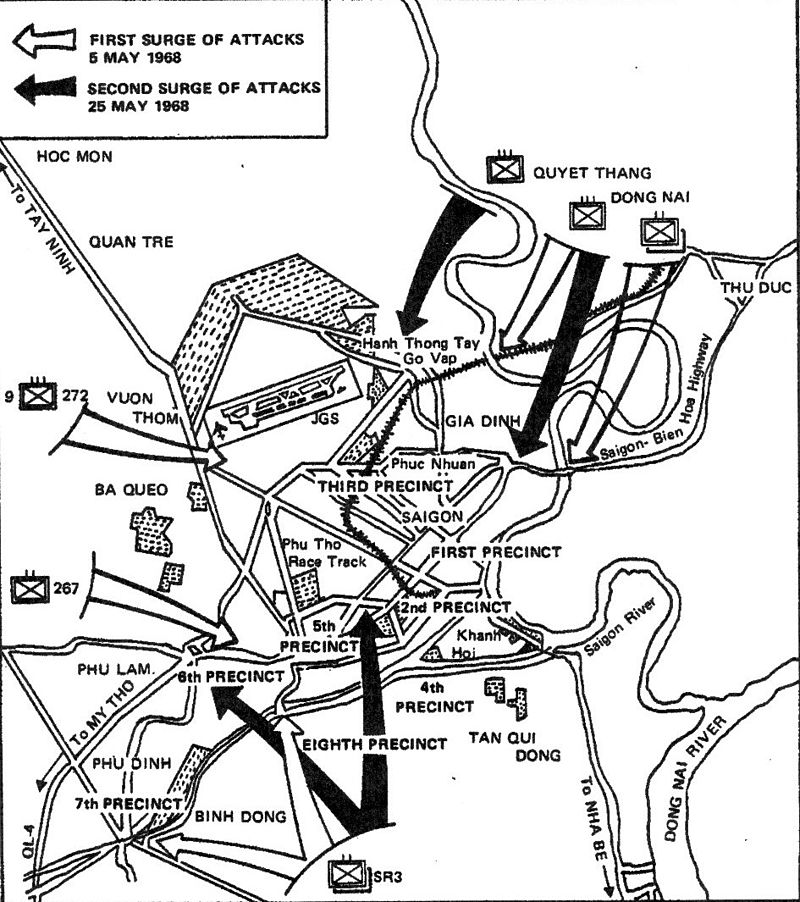
“Mini-Tet Offensive May 1968 https://en.wikipedia.org/wiki/May_Offensive#/media/File:TetMap4.jpg
I took a roll of film to document the extent of the damage, only to discover that it had not engaged with the take up spool, and there were no pictures after our tour of Saigon and Cholon. I did take a memento photo of the U.S. embassy, however, and the damage had not yet been fully repaired.
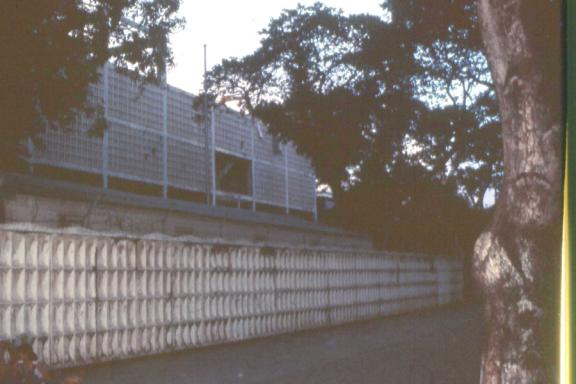
U.S. Embassy with shell holes, May 1968.
Out of the Frying Pan….
We spent most of the month of August summer of 1968 in Belmont with my parents, preparing for the move to Ithaca where I would begin graduate study in the fall. The assassinations of Martin Luther King and Robert Kennedy earlier in the year had cast a further pall on what had already been a traumatic year. But the event that capped it all was the Democratic National Convention.
Although my father had written a pioneering book on educational television in the mid-1950s, we did not own a television until the mid-1960s. I recall my consternation sitting in our family living room with my father watching the Chicago riots unfold. He was fulminating and I was appalled and speechless. This was not the reintroduction to America I had expected after six eventful and turbulent years. We could only passively witness what was unfolding on our black and white TV, which was small and low tech, but was still able to transmit the powerful images with dramatic impact.
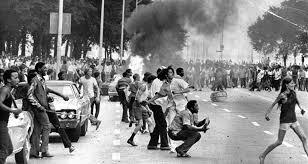
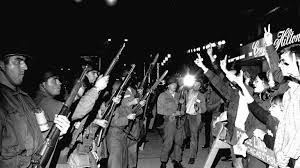
With these events still resonating in our minds, Mai and I set off for Cornell to start a new chapter in our lives.
- Noel Barber, The War of the Running Dogs; How Malaya Defeated the Communist Guerrillas 1948-60, (Weidenfield & Nicholson: 2013) ↵
- Robert S. McNamara with James Blight, Robert Brigham, Thomas Biersteker and Col. Herbert Schandler, Argument Without End: In Search of Answers to the Vietnam Tragedy, (New York: Public Affairs Press, 1999), p.173. ↵
- Office of Media Services, Bureau of Public Affairs, Department of State, “Communist-Directed Forces in South Viet-Nam,” Viet-Nam Information Notes, Number 3, Revised May 1968. p.2. ↵
- null ↵